This page will take you down memory lane with
pictures and narrative type comments, weaving together bits and pieces of
information as it relates to some of my early research and development
of GIBSON MASTERTONE PRE-WAR BANJOS,
a more or less autobiography leading up to the present time.
Verification documents, references and drawings are included and hopefully
all inferences and opinions by myself will be correctly noted. As
with many things from the past, one must extrapolate using the best
available data to hopefully obtain valid and reliable conclusions which is
not an exact science.
I am sure there are some errors present since I am relying on personal events of
nearly 50 years ago and memory is not infallible. I have made
corrections and
additions as necessary to provide the most accurate information. My
initial purpose for this page was to give credence to my wood working
experience and there was a natural overlap into other areas. I
don't consider myself an expert at anything simply because I have
never found one particular area to hold my interest and devotion, but for a
certain length of time, whereas many are able to find their own particular
profession, hobby and passion to become a Master at it. However, I have never been afraid to try a new challenge and task and do think outside the box which many times
is considered unorthodox. I like the statement that Anthony Hopkins
used in the movie "The Edge", "What one man can do,
another can do." With that
said, there are many
individuals that have
nurtured their God given talents that sets the standard for the rest of us
pretty high.
I do believe and practice,
"anything worth doing, is worth doing right!"
I have featured special and
talented friends and family that have helped and
inspired me and in no way all inclusive in this section and other pages
throughout this website.
I give God our Creator, through Jesus Christ our Lord
and Savior, the Praise, Honor and Glory in all things!
Our "Pop"
William Porter taught us the value and respect of the great
outdoors
and we shared many memorable days hunting cottontail rabbits with all breeds of hounds and later had to use the small beagles because of the increase in
the Whitetail deer population. Pop loved woodworking and made a great
porch/yard swing with the correct seat and back angle curve and used
"old world techniques" such as a draw knife, chisel, etc. to
fabricate his swings. Some of my earliest wood working projects
got its start from "Pop" who taught me how to make a rabbit box,
rabbit trap or rabbit gun, which ever you choose to call them. I made
"Pop" several drill fixtures with
hardened drill bushings over the years but he loved the ole way of doing
things. Pix of our Dad taken in the early to mid 1960s with my dog Brownie. Pop passed away on August 10, 2007 after a
long battle with heart disease and inserted is the last pix I took of
him on July 4, 2007 while enjoying some ice cream and cookies at our home.
My sister sent me pix of his school days in 1934. Pop had a continuous
testimony for Jesus Christ, loved his Church and fellow man and he witnessed
to us and those in the hospital room hours prior to his death. He was
an honest hardworking man devoted to his wife and family and is greatly
missed, but not forgotten!
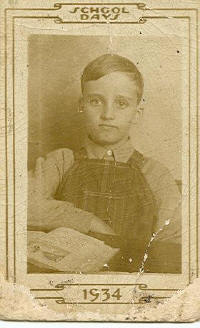
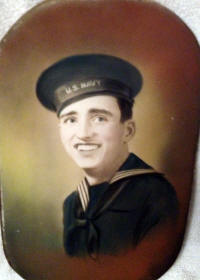
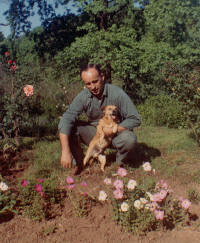
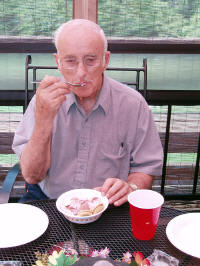
Above four pixs of our "Pop" William Porter
taken between 1934 and July 4, 2007.
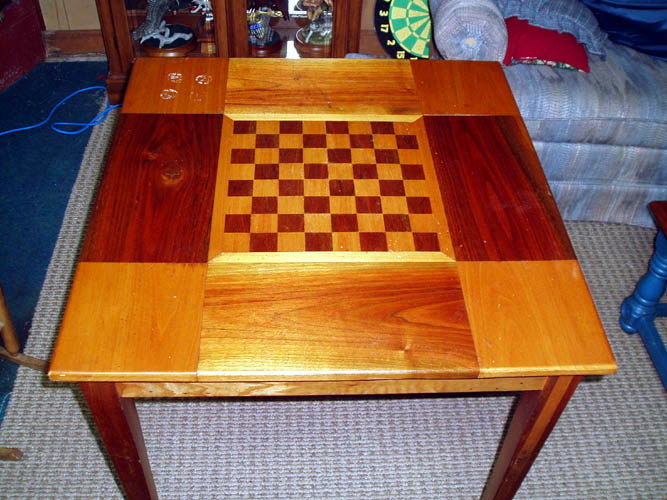
Above is a checkerboard table in my
Man Cave in our basement that I
built for our Pop around 1962 or 1963 in the Industrial Arts aka Shop Class
at the Wadesboro High School. David Kephart (now deceased) was our
shop teacher who was an excellent woodworker, craftsman and teacher.
The table had plenty of usage over the years by Pop and anyone who
challenged him to a game of checkers. This checkerboard table was made
long before the veneered checkerboard tops were available through the wood
working suppliers and constructed from solid walnut and poplar, however the
tapered legs were made from glued up walnut 4/4 stock. Table has a
small drawer underneath and visible from the other side to store the
checkers. The flash from the little digital camera "washed" out much
of the detail; the corner squares are from white poplar and the adjoining
wood is dark walnut but the pix bleached the color out at that camera angle
and doesn't do justice to what the table looks like. The table could use a
make over; e.g., sanding and refinishing, but I plan to leave it as
is. Pop was an excellent player and I rarely won a game of checkers
with him since he could see about 3 more moves ahead of you all the time,
however I won the first game ever played on this table. After the
passing of our Pop and Mom, I received the checkerboard table and a custom
inlaid Buck folding hunter knife that I also did for him. I certainly
do miss them both! Posted update by Bill aka Mickey Porter on
03-11-2023.
There is a special Love for one's Mother of which it is
hard to find words to convey that message, but I certainly let her know that
I loved her and have no regrets in that area. Like our "Pop", she was
a hard working woman and loved our Dad and her children dearly and did the
best she could by us and lead us in the right direction. She had a
beautiful strong Alto voice and shared her God given talent that was
nurtured early on with singing and music lessons proved by a prominent
Wadesboro resident. Mom shared her singing in many services in
and around Anson County. NC and will be greatly missed, but not forgotten!
Like our "Pop", Mom had a continuous testimony for Jesus
Christ and did her part witnessing the great Love that Jesus Christ has for
us all and how to obtain Salvation.
She suffered greatly the past seven (7) weeks and was a
cancer survivor of about four years and finally succumbed to congestive
heart failure. During her much suffering, when asked how she was
doing, she would answer, "I am trying"
attempting to maintain a positive attitude and outlook. Throughout the
years, during the many trials and tribulations that came her way which is a
part of Life, she would say,
"And this too
shall pass" of which it does given time and with the Lord's
Grace and Mercy that is available to all of us. Below a few pixs:
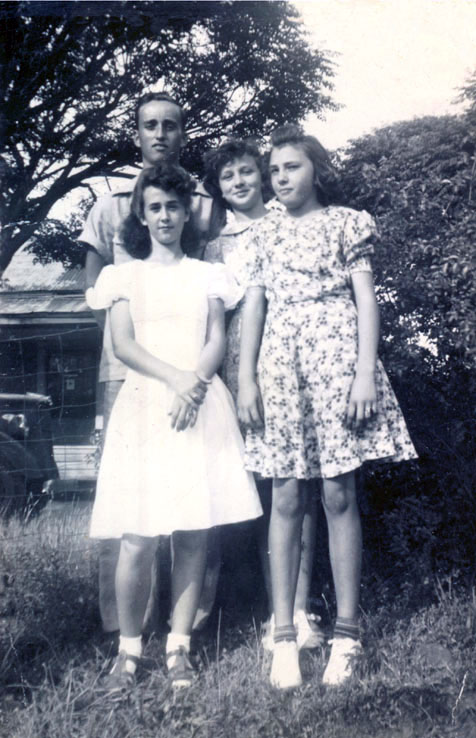
The above pix was taken sometime around 1941 with our
Pop in the background of which was Love at first sight when he met our "to
be Mom", grin if you must! Mom is the young Lady on the front right
and her Mother dressed her like a little girl for sure. One of her
sisters Molly Bowers is in the background and Rose Thomas is on the front left.
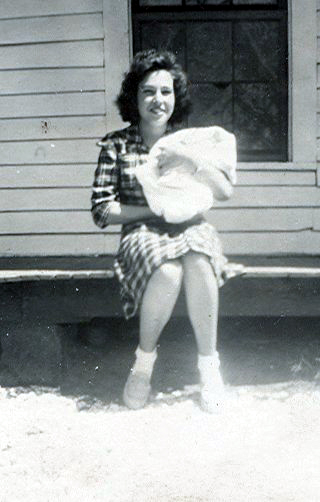
Pix of my Mom taken in 1946 holding yours truly.
My friends said this was about the best I have ever looked! Grin if
you must.
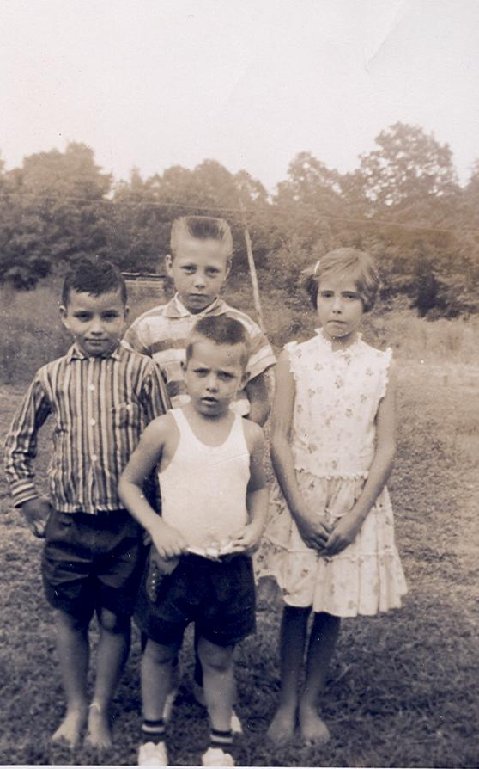
A pix taken in the mid 1950s of the Porter kids
left to right; Allen, Mickey, Joe, front row (deceased) and Sue. Back
during the early black and white westerns on TV, our younger brother Joe
would ride his horse which was a stick that he had fashioned reins (string) tied to
it and he would make all the sound effects and motions of a horse raring up
and would slap the side of his leg while he was "riding" his horse.
How he was able to run with that stick between his legs dragging the ground
behind him and not getting tripped up was unbelievable. He would tie
that stick up to a hitching post just like it was a real horse at the end of his ride.
Back in the 1950s kids created their own toys and
invented games to
entertain themselves and others. I have made my share of sling shots
using automobile tire rubber, old shoe leather tongues and forked prongs
with dogwood being my favorite. It was nothing to roll an old tire
around and if one was large enough, get inside and roll down a hill.
Old tin lard can lids and large coffee can lids would be nailed to a piece of wood and rolled around
like a wheel. Tarzan vine swings were used across small creeks and
branches and sometimes would give way with a crash to the ground, but we
were tough back in those days. About every young boy had a pocket
knife and a Barlow was the standard and whittled and carved many whistles
and objects. Don't remember any kid in our neighbor that intentionally
cut another kid with his pocket knife and we were allowed to carry our
pocket knives to school! Kids also built home made wagons, go carts;
made skate boards and push scooters from metal skates and that was long
before the synthetic poly wheel commercial skate boards. Home made
bows and arrows and the Biblical type David sling has thrown many rocks with
varying degrees of accuracy. The girls would make "play houses" by
clearing off the ground and using pine straw to make the room dividers and
rocks and other objects to simulate the furniture, etc. Making home kites or
using store bought ones which required you to make a long tail to help
stabilize it so it would stay aloft. Those days are long gone! Today, kids have digital technology
devices to occupy their minds and I believe has diminished their personal
creativity.....grin if you must! Times has really changed and I
certainly do miss Brother Joe! Pix added 10-24-12.
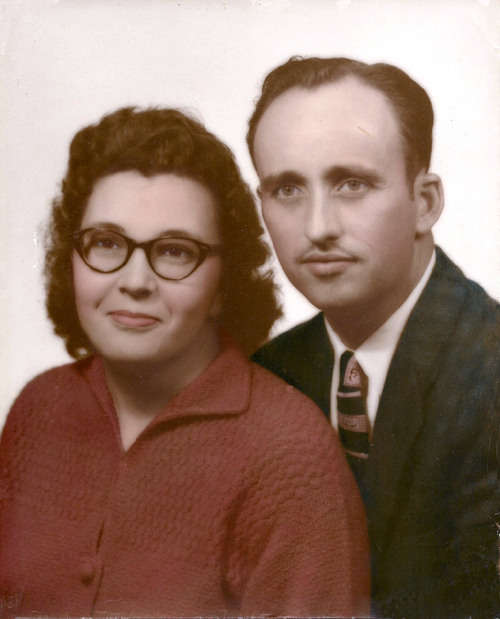
Another early pix of Mom and Pop.
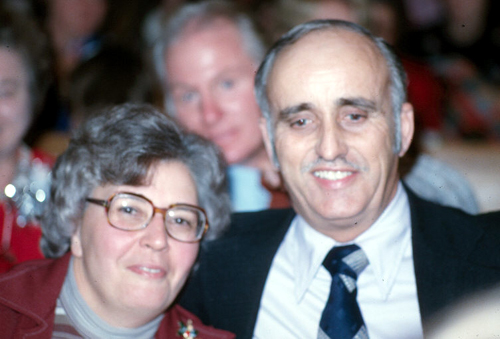
Another one of my favorite pixs of Mom and Pop taken in
1978 with Ray Newton in the background.
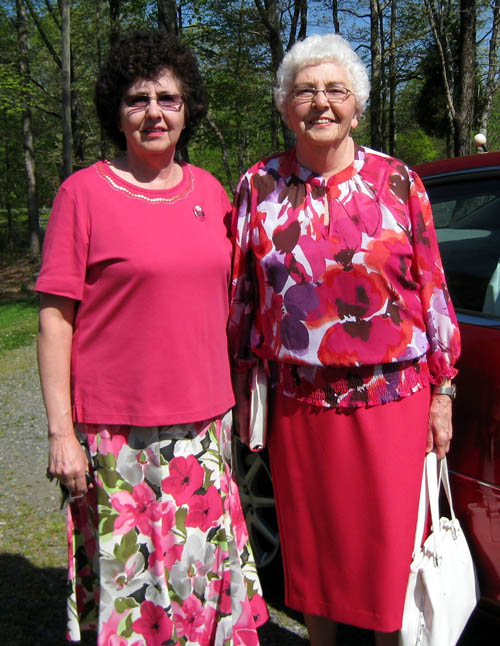
Pix of my Sister Susan Pettigrew and our Mom.
I have an audio file in .mp3 format about 4 Mb of
Mom singing
Pearly White City around 1998 at a funeral. Click on Pearly White
City hyperlink to open the file.
I have an audio file in .mp3 format about 4 Mb of Mom
singing
I Cannot Fail The Lord recorded on April
17, 1983 at the Wadesboro Church of God. Ralph Henry Coble is playing
the Organ and Carolyn Griffin is playing the piano. Click on I Cannot
Fail The Lord hyperlink to open the file.
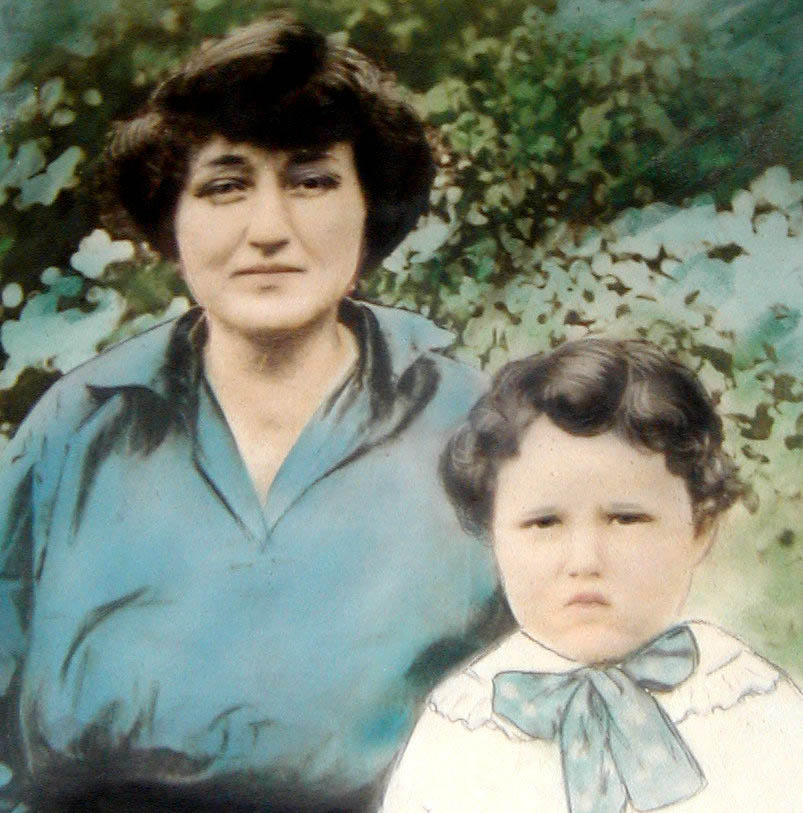
The above picture of my Grandma with her first
son Joe of which I have the large framed hand colored photograph in our
home. I lived with Grandma as far back as I can remember and stayed there until 1964 when I enlisted with
the US Navy. My Mom and Dad lived next door to us and countless times
after the passing of Grandma, Mom would say, "I know you loved her more than
me" of which I never gave an answer. I believe she knew the
answer!
As with most of us in our youth, we didn't realize how
smart and wise the "older generation" were
until some years later when we entered the normal struggle of life and the
light bulb finally came on. Grandma was a very giving person who
had a dozen or more rental properties that provided her income and many, many
families left owing her much money over the years, but she didn't have the
heart to immediately evict them as most property owners would do, but allowed them to
stay on until they moved.
I learned a lot of life's valuable lessons from her
over the years, but didn't fully understand the tremendous value and
magnitude of those lessons until after she departed this earth to be Jesus
Christ
our Lord and Savior!
I have a short story titled
Memories From The Past
which goes into some detail about her life and there is an audio file I made
of her in the early 1970s with her singing which is linked on the same page.
Click on the hyperlink
for additional information. I still Love and miss her dearly!
US NAVY BOOT CAMP
After graduating from the Wadesboro High School in
1964, I was interested in obtaining employment with the North Carolina
Wildlife Resources Commission as a Wildlife Enforcement Officer, but that door was never opened and decided to join the US Navy to get some life skills training and as
they advertise, "To see the world."
I did Basic Training aka Boot Camp at Great Lakes, Illinois and
that lasted for twelve (12) grueling long weeks. That training was definitely a
wake up call and not the relaxed training our current military boot camp folks go
through, except the Marine Corps.
I was offered a voluntary medical discharge because of
a .22 caliber gun shot wound received in the left leg ankle in 1960, but
refused the voluntary medical discharge!
I still remember the fire control training where we as
a team would put out fires simulating fire conditions on a ship with real
fires burning and in close quarters. The gas mask training was as real
as it gets too where we went into a closed room and tear gas was released
and we had to remove our gas masks and recite our name and service number.
Yes, it definitely brought tears to your eyes, but not as painful as the OC
pepper spray training with the NCDOC/NCDPS I have went
through.
I was in excellent physical
condition, having worked
out regularly with weights the last two years of high school, but the hours
of marching and drilling would drain your energy level quickly.
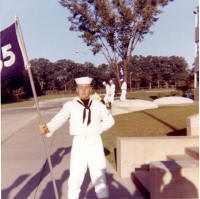
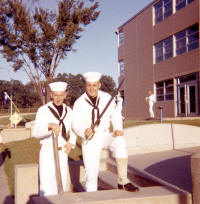
Before enlisting in the US Navy, my Pop told me not to
volunteer for anything as he was a Navy man himself during WWII.
SERVICE WEEK DUTY
About half way or so into our boot camp
training, we had to do two weeks of duty called
service week that encompassed all kind of duties like mess hall,
building janitorial service, grounds maintenance, etc. Our unit was assembled and the instructors
would call out looking for volunteers that had training in areas such as truck
driving, water fowl hunting experience and a bunch of hands immediately
were raised. I remember my Pop told me not to volunteer for anything.
The majority of the volunteer jobs were already picked by the eager volunteers
raising their hands and there were only a few of us left. They finally
asked for a volunteer that had typing experience to work as a
typist at the battalion
headquarters. I thought about what Pop told me again and those truck
driving volunteer jobs turned out to be sailors pushing wheel barrows and
the water fowl hunters were assigned to pick up cigarette ducks from various
locations. However, I surmised that I believe this job might be
legitimate and slowly raised my hand with a lot of anxiety. The Drill Instructor told me to
report to battalion headquarters for duty the same day. The typist job
turned out great, whereas I didn't have to report for duty until 0800 hours
each day and went by the mess hall each morning and got the Battalion Officers donuts/cake,
etc. that was waiting on them. I typed cover sheets for manuals, etc., and got off duty each day
around 1530 aka 3:30 PM to 4:00 PM and got off on Friday around noon and was off for the
entire weekend. That gave me a chance to catch up on getting all my
uniforms squared away, brass buckles polished, shoes spit shinned and things in order and do some studying for upcoming
written exams.
Those mess hall workers had to report to duty at around 0330 hours each
morning and didn't get back to the barracks until around 10 PM or later and worked
the entire weekend as well.
The Battalion Commanding Officer asked me if I would
like to finish out my training there as a permanent service week, but I
declined the offer wanting to attend classes and graduate with my regular company
No. 365. They
liked my job performance and gave me a letter of commendation for my
service record.
I lucked out on that two week service week duty
assignment and my
two years of typing in high school paid off as I cruised right along on the
ole manual typewriter.
LIBERTY WHILE IN BOOT CAMP
I can't remember what week of training we were on, but
we finally got a day of liberty and several of us took a train to visit
Milwaukee, Wisconsin. The country side was beautiful with rolling hills and
when we got downtown in Milwaukee, I ordered
a good size steak at a busy restaurant which might have been a T-bone, but not
sure. It wasn't the greatest cut of meat as I remember and definitely a break from
the mess hall chow.
Our group made it back to base in time and I believe we
got one other liberty while in boot camp, but can't recall where I went.
RADIOMAN SCHOOL BAINBRIDGE, MD.
After Basic Training, I was assigned to Radioman Class
A School
in Bainbridge, MD. which lasted at least six months. I received some
excellent electronic training to be used later on in the private sector and it was a tough course
having taken only one advanced math class while in high school. Most
Radioman jobs were of the clerical administrative nature, rather than hands
on electronics repair, unless you went to some of the specialized schools;
e.g., Class B and C Radioman schools, teletype repair, etc. The
Radioman RM rate is more or less and operator job and not a technical rate
per se.
IBM PUNCH CARDS
Getting side tracked a little which is my normal MO,
(modus operandi) while in Radioman School I met an individual who had worked for the Naval
Bureau of Personnel and he explained to me how the IBM punch cards worked
for selecting your duty stations/assignments. That acquired inside
knowledge worked to my advantage and I was able to basically get the
areas of duty that I wanted.
WATCHED MY FIRST THEATER MOVIE
Aside from attending daily classes, I didn't go
off base hardly at all, but watched movies on the weekend at our base theater. Prior
to my enlistment in the US Navy, I had never been to a movie theater and
remember watching the 1963 movie The Pink Panther with Peter Sellers; a riot
for sure! Our local Wadesboro Church of God frowned on attending movie
theaters as sinful activity. After watching the movie, I just could not
make the correlation to that activity being sinful, however I do realize certain types of movies
would definitely fall into that category. A large number of our class lived within driving distance of
Bainbridge, MD and would go home for the weekend, but it was too far from
Wadesboro, NC to try and ride a bus which would not leave much time to visit
home folks at all.
CHARLOTTE, NC TO NEW YORK
My parents took me to Charlotte, NC and boarded a plane
headed for New York JFK International Airport.
ROTA, SPAIN
As stated below, my next duty assignment was in Sidi
Yahya, Morocco, whereas several of us had duty assignments and the
flight was from New York JFK International Airport to Naval Station in Rota,
Spain where we stayed a week or two in a holding company.
GIBRALTAR
Several of us were then transported on a small twin
engine air plane (mail plane) to Gibraltar and if I am not mistaken, spent
the night there and the next morning flew to Rabat, Morocco.
From Rabat, Morocco, we traveled by bus to Sidi Yahya
riding with the locals and that was an experience for sure!
MOROCCO, AFRICA
My next duty assignment was at a Naval Communications
Station at Sidi Yahya, Morocco, Africa which was not to far from the old
Port Lyautey,
however our facility was about 20 miles East from Kenitra near
Sidi Yahya. I was there for two years and
advanced to Radioman Second Class E5 Petty Officer in 1966 if my memory is correct.
Here is a
link with a couple photos, etc. The
base at Sidi Yahya was handed over to the Moroccans in 1977. There is an alternate
spelling for Sidi Yahya being Sidi Yahia.
Our primary mission was to provide communications
support with
the ships (Sixth Fleet) in the Mediterranean Sea and submarines in said area. Most of our
communications were via secure cryptic HF circuits. Our transmitter
site was about 60 miles away near
Bouknadel, Morocco which maintained a million
watt very low frequency transmitter of 17.8 KHz for cryptic transmissions to
submarines. Two infamous
research ships (go ahead and grin on this statement) that frequented the
Mediterranean Sea, being the
USS Pueblo and the
USNS Valdez which required 100 percent
communications with them. There were a total of five (5) of those type
ships which included the
USS Liberty that came through the Mediterranean Sea, but the three mentioned above
are the ones that stuck in my memory bank. I am not sure if the other
two (research ships) were assigned to the Mediterranean Sea for duty. It was very stressful since the
USSR would
scan the HF spectrum looking for our signature multiplex incoming signals
and would place bagpipe type
jamming signals on top of the main carrier frequency in an effort to distort our
communications. I was a shift supervisor for a year at this facility
and planted the seed for myself never wanting to be a supervisor
again. I am a hands on person and rather do the job myself, rather
than direct someone to do it. This tour of duty counted as sea duty and while there
participated with some advanced communications skills & equipment and got a
final top secret crypto security clearance, which wasn't required at the
particular area I was assigned to, only a Secret security clearance. The
Navy wanted me to extend my
enlistment another two years to participate at the specialized
communications facilities; one was there in Sidi Yahya which was located
between our Communications Receiver Site Facility referred to as
Special Projects and the Main Base which
had all the support
functions; mess hall, message center, crypto center, barracks, dependent
housing, special
services, motor pool, etc. I believe there were only five (5) of those
Special Projects type duty stations on the globe, but I declined the offer. When I
signed up for the program, you did not have to obligate the two extra years
of enlistment and this rule was changed while they did the background
security check which rendered my Final Top Secret Crypto Security
Clearance. I was told that a couple security personnel from Norfolk,
Virginia came to my home town and stayed a couple weeks doing the background
check, but I don't know that for sure. A Top Secret Security clearance
does require face to face contact interviews in addition to an extensive
background search.
I was selected from our Receiver site facility to participate in a
special project when King Hassan II made a trip to Washington, DC via an
Italian ocean liner and we set up a mobile ComSta in his private villa there in
Rabat. I did an internet search, but could not find a record of the
event. However, I still remember the ship being the
SS Raffaello which was an Italian ocean liner. I believe
their radio call sign was IBLO if my memory is correct. We had
a fleet of mobile trailers of which one contained an
FRT40
transmitter (40 Kilowatts) which took up the entire mobile trailer,
but not sure; it could have been the FRT39 (35 Kilowatts of power). We also had a trailer with
our receiving equipment, a message center and the support equipment needed
such as a generator trailer, fuel tank trailer, etc. We
were treated very well to say the least. Our special unit received a
commendation from the US Navy and the Moroccan Govt., if my memory is
correct.
At the Naval Communications Station were
housed the Naval Security Group
NSG which were comprised mostly of
Communications Technicians later renamed
Cryptologic Technicians
in 1976
and hyperlinked
here with their webpage with info from that era.
Their duty station work complex was located in the same building complex
(receiver site) as the Radiomen and basically, we had
no contact with each other due to security issues and protocols. There
were miles and miles of
rhombic full wave length antennas suspended
by very high large diameter wooden power poles mounted on concrete pillars.
There were also parabolic antennas, microwave antennas and a microwave
system to our main ComSta. The US Marine
Corps provided perimeter security for this building complex and the entire
base.
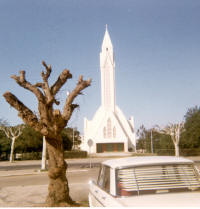
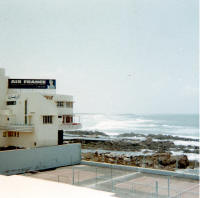
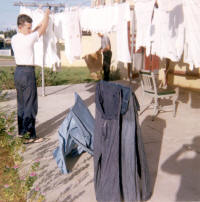
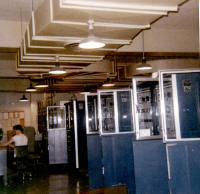
Above pix to left is a famous Church landmark there in
Kenitra, ocean side restaurant complex, laundry day at barracks and pix of
some shore base HF receivers. I used Niagara starch on the blue work
uniform pants and shirts, prior to ironing them as evidenced by them standing vertical. Later,
we had a Moroccan named Abdullah (pretty common name) that was our barracks janitor contracted to
do all of our laundry at a fair price too. It didn't take long in the
hot sun to dry your laundry either.
The pix to the far right below is Bill Porter & HC Morris in
Morocco, Africa 1966 (winter) on some R & R while in the U.S. Navy stationed about 20 miles inland
from Kenitra at a Receiving Station near Sidi Slimane and Sidi Yahya. HC is
from Cheraw, SC and retired from the US Postal Service. HC,
myself and others at our facility had
many adventures in Casablanca, Tangier, Rabat, Fez or
Marrakech, but can't remember which one Fez or Marrakech or both!
NOTE: Due to the
cold war
and other reasons which will manifest itself is
some of the hyperlinks provided, we were
required to wear a sports coat and tie to get off the base and our hair was
not cut short to give the appearance that we were military! There were
many foreign spies operating in the cities that we frequented while on
liberty aka R & R and we were trained to be on the lookout for them by their
mannerisms and of course any would be probing questions. For the most part, we didn't travel alone.
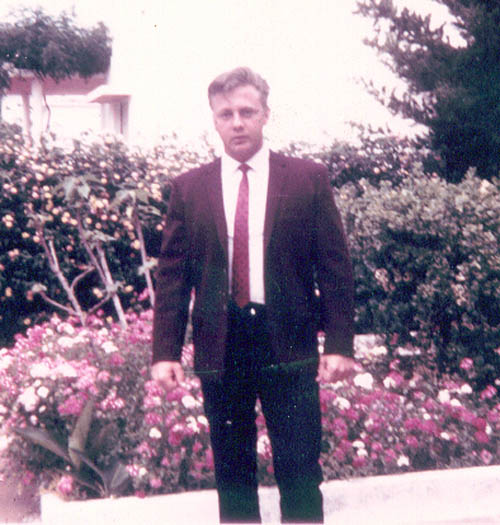
Our base had a sales representative and tailor from London, England that
would take our measurements and have whatever particular suit we wanted made
and shipped to our base. He was able to make on site alterations if needed.
I purchased three piece suits and sports jackets made of
Worsted wool,
Sharkskin,
Cashmere wool,
Herringbone Wool,
Harris Tweed, etc., but it didn't take, but a few years to out grow them
from the good food my future
bride provided!
Below a few pixs taken between August 1965 and July
1967 while in Morocco.

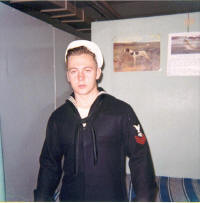
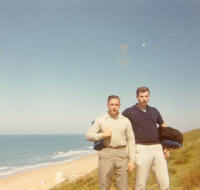
Nov1966.jpg)
The above pix is one of my brides favorites. Taken at the Sidi Yahya
Communications Station (receiver site) in Morocco, Africa in November 1966; a letter from
home, no doubt from my future
bride to be, cup of Java and one of my
favorite magazines, Fur-Fish-Game. We used
Morse code as a novelty to communicate with the main ComSta to
keep in practice in case we ever had to use Morse code.
HEART FELT EXPERIENCE
Most of the things we as young sailors did while on R & R and not
fully committed to our
Lord Jesus Christ, does not lend itself to print and have no desire to do so. However, there was
one memorable event that happened sometime in 1966 while several of us from
our duty station were on liberty aka R & R in Kenitra, Morocco for a couple days
and met two young ladies from Canada employed by the Peace Corps.
Their names were Pam Mitchell from Toronto and Sheila Katz from Ontario.
Our hearts went out to them as only our Lord Jesus Christ can motivate and
inspire via His Holy Spirit and was evident they could use some help, whereas we treated them to a wonderful meal and
a bond of friendship and fellowship was immediately established.
Everything they owned was in their back packs which didn't look to overly
bulky either. We were perfect gentlemen and before they departed on their Peace Corps mission there in Morocco, we swapped
addresses with Pam and Sheila and we went aside and took up money from each of us and gave it to
them to help them on their journey since the Peace Corps definitely was not
a money making job; more or less for the experience and dedication of
helping people. It was one of the most gratifying wonderful feeling and
humanitarian experience of my tour of duty in Morocco. Pam and Sheila would send a
yearly card to my address at Grandma Coley's home on Maple Lane, Wadesboro, NC when they ended their
tour of duty with the Peace Corps and they never forgot the kindness we showed them.
I lost contact with them many decades back sometime around 1975 when Grandma's old home
place was sold and trust Pam Mitchell and Sheila Katz are still alive
and doing well!
PICTURE EDITING BEFORE PHOTOSHOP
My
bride did some editing on the pixs below
that were taken in Morocco, Africa with a pair of scissors and
made a collogue out of them...wonder what else was in those
pictures?..........grin if you must!
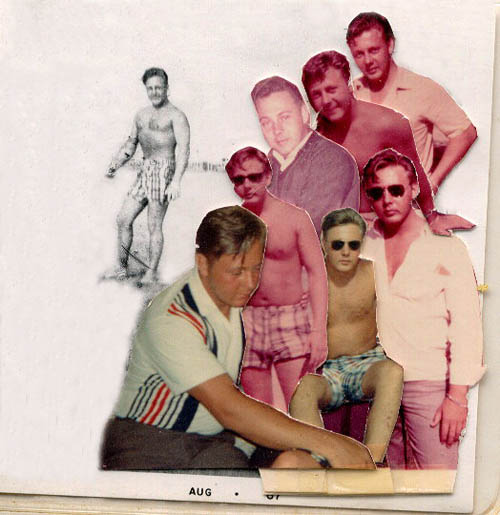
NOTE: The above background pix from August 1967
probably taken at Mehdia Beach, Morocco was badly
damaged by the acetate sleeve it was stored in. I ran it through
PhotoShop CS2 and cloned out some of the damaged pixels which were very dark
black spots on the photograph. As I stated above, my bride made a
collogue out of it by adding some pixs I had of myself with other persons in
the pix, of which she edited out with a pair of scissors....another grin is in
order. I worked out with weights as evidenced by the background pix.
I believe the photo was taken in mid 1966; however it wasn't developed
until August 1967 after I returned back to the USA from Morocco, Africa.
The
Six Day Arab Israeli War happened while I
was stationed in Morocco and communications was at a buzz for sure.
I am thankful that our Lord Jesus Christ extends his
grace and mercy to all of us and provides His Devine protection!
TF-140 NAVAL AIR STATION NORFOLK, VA.
My next duty assignment was the
Manned Spacecraft
Recovery Force Atlantic TF-140 which was at the Naval Air Station in Norfolk,
Virginia from July 1967 to Aug. 1968.
I was initially assigned to the message center while a
crypto room was being installed at the TF-140 building complex. After
the construction was shortly completed, my main duty at TF-140 was in charge of our facility crypto
room (only
personnel
in our section with a top secret crypto security clearance) to my knowledge and my
responsibility of getting the documents
decrypted, printed and routed
to the proper personnel. All that technology is obsolete and
declassified now, being replaced with on-line crypto
machines and systems in place due to the advancements in computers and of
course satellite communications.
APOLLO 4
I participated in the
Apollo 4 launch on Nov. 9, 1967 at Cape Canaveral,
Florida. Our team flew down TAD status a week before the launch
for specific tasks and we stayed in a motel there in Coco Beach, Fla. I don't remember
how long we stayed after the launch, but it was good to get back to Virginia
and be able to come home on the weekend to see my bride to be!
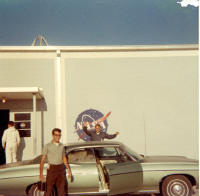
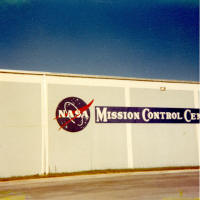
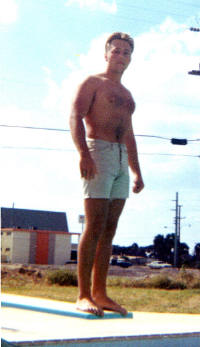
Pix taken at NASA Cape Canaveral, Fla. and
Mickey Porter at Coco Beach, Fla.
MARRIAGE
My grade school sweet heart,
Joyce Adcock and myself eloped and were
married on January 22, 1968 and did not tell anyone we were married until I had an apartment
rented for us in
Ocean View, Norfolk, Virginia which was not
very far from my duty station. She is still the love of my
life after 55 years of marriage and is my best friend as well! I can
not imagine life without her, our 3 children and 6 grand children!
I
first observed my bride
to be at the Wadesboro Church of God on August 11, 1957 as the entire
Adcock
Klan (ten of them) came into the sanctuary and
it was love at first sight both ways. She was dark tanned from the
sun, had a yellow dress on and long braided pigtails. A baby doll for
sure and still is!
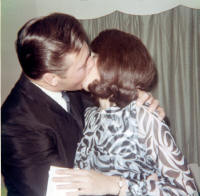
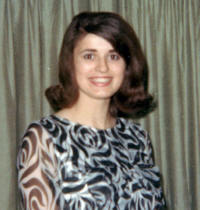
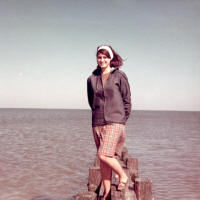
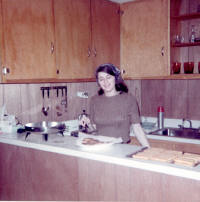
First two pixs on the left taken at our wedding in
Chesterfield, SC and the right two pixs of my bride taken in March 1968 at Ocean
View, Norfolk, Virginia.
WORLD BOOK ENCYCLOPEDIA SALESMAN
One of the things I vividly remember, was all the sales
people that crawled out from under the rocks trying to sell World Book
Encyclopedias, etc. They would get your address from the utility
companies when you had your power turned on. I posted a sign on our front door alerting those sales
folks that I worked various shift hours and do not knock on the door
unless it was an emergency or military related, but
that didn't slow them down.
A friend of mine from our duty station in Morocco,
Kenneth J. Connors
left in the photo hyperlink who was assigned a ship there in Norfolk, Virginia
came by for a visit when one of the salesmen knocked at the door, whereas
the salesman paid no attention to the sign I had posted. This guy was
selling World Book Encyclopedias and had a slight speech impediment. I
decided to have some fun with him and let him pull out every sales poster he
had of which sometimes he would pull them out and show them upside down and
of course we cracked a pretty good grin at his expense. I led the guy to believe I
was very interested and going to purchase a set of the encyclopedias.
When he brought out the
sales contract and ink pen, I told him, I wasn't buying a set and reminded him at the
beginning I was not purchasing a set of World Book Encyclopedias. I
thought he was going to cry for a moment and he sarcastically said, well, if
it is going to take bread off your table and I told him purchasing a set
would not take bread off our table. It was hilarious to watch him try
and get all the sales brochures and posters back into his brief case and he
departed with some of the posters hanging outside his brief case.
My friend Kenneth J, Connors from Kalispell, Montana and myself had a good
laugh off the guy. I know it was a little mean to do such, but
sometimes you have to "break someone from
sucking eggs."
That guy didn't give up, but sent someone else over and
he was sent on his way as well! I realize those folks were just trying
to make a living, but not every sales potential is a
blue fin sucker either;
gullible for you non southern folks.
Being a newly wed couple, World Book Encyclopedias was
definitely not on our agenda, however years later when our kids were in
school, we did purchase a set.
Modern technology has made the World Book, Encyclopedia
Britannica, many magazines and some newspapers going digital.
BACK TO THE TF-140 NAVAL AIR STATION
NORFOLK, VA.
It was January 23, 1968 when the North Koreans captured the
USS Pueblo and of course
plan B went into effect for secure encrypted communications, not aware that the
Walker Spy
Ring was doing serious damage to our cryptic communications by
handing over copies of current code keys to the Russians. Open the
above USS Pueblo hyperlink which details now
declassified information as far as cryptic equipment
inventory on board the USS Pueblo.
On May 22, 1968, the
USS Scorpion went missing and was later
located with all types of speculation as to what caused the accident.
I did four (4) years in the US Navy and was never
assigned a ship; imagine that! Remember the IBM punch
cards.......grin if you must!
My enlistment in the US Navy provided valuable job
skills training for later usage and an accelerated course in growing to
manhood very fast. However, most of my communications training and
skills were only applicable in an active duty military environment and/or
Defense Contractor type employment. The electronics training was later put
to usage with the North Carolina Telephone Company and passed the FCC
First
Class Radiotelephone Operator License exam on the first try in Norfolk,
Virginia in 1969.
HYPERLINKS SUBJECT TO PUBLIC DOMAIN
NOTE: All references to my military career
as far as communications, etc., are now declassified
as noted by some of the hyperlinks related to the USS Pueblo, USNS
Valdez, USS Liberty, Sidi Yahya and subject to public domain.
Upon honorably discharged from the US Navy on August 3, 1968, my
Uncle J. Mack Coley (now deceased) being Quail hunting friends and Masonic member
with Jack Miller, (now deceased) Vice President of the Outside Plant Operations for the North
Carolina Telephone Company, Matthews, NC, set up an interview with Bob Presson, (now
deceased) Manager of
the NC Telephone Company in Marshville, NC for a job interview.
Talk about a one of a kind job interview, Bob Presson
wasn't aware ahead of time of the interview for a Radio Equipment Engineer
position/job which consisted of installing and repairing two way radios,
base stations and mobile telephones, parts ordering and inventory for the entire telephone company which
spread from Matthews, NC to Pinebluff, NC. This was a hands on job,
not sitting behind a desk with a slide rule, predating the invention of the
personal computer. The
transistor was invented in 1947 and the
silicon chip was invented in 1961 and the US
Navy was heavy into the solid state circuits after WWII with the new technology replacing many vacuum tube
applications, however large transmitters still required those monster vacuum
tubes and power hungry power supplies. All the transmitters and
transceivers within the N.C. Telephone Company still had power amplifier
vacuum tubes, however most of the receiver portion were all solid state.
Bob Presson and only one other person, Ralph Starnes
(both now deceased) within the
North Carolina Telephone Company had an FCC Second Class Radiotelephone Operator License which was
required to adjust said equipment; e.g., power output, frequency, modulation
for the two way radios, mobile telephones and the three (3) microwave
stations located at Marshville, Wadesboro and Norwood, NC.
Bob Presson told Jack Miller, "He thought he was doing a pretty good job of
maintaining the radio equipment." After the interview and being hired
for the job, all three of us went down into the basement where the radio
repair shop was located and you could hardly walk through the door for all
the two way radios and mobile telephone equipment needing repairs.
Within, the three month "trial period", I repaired all
the defective units except one which was later repaired. I maintained
that job until 1972, whereas I trained my replacement Bobby Simpson (now
deceased) of New
Salem, NC, who worked under the FCC license of Bob Presson and I transferred to
my home town Wadesboro, NC working on inside office equipment specializing on Microwave, multiplex equipment, ITT, Stromberg Carlson,
Viacom, Motorola, RCA, GE and special circuits requiring modems and
switching equipment until 1975. At the same time, I was running my musical
instrument repair mail order business and attended the local Community
College until 1978 studying business. I earned a two year degree in Business Administration
and Industrial Management. While working with the NC
Telephone Company, I maintained an Amateur Radio Advanced Class "Ham"
license call sign WB4GAN and kept a 300 ft. long wire antenna and
Collins
KWM2A transceiver at our radio repair and installation facility
which was relocated in the rear of a large warehouse complex offering much
more room and at ground level. I chatted and Morse code with folks all over the world
during down time and kept a banjo and Dobro close by too. I was also a member
of the Navy
MARS program call sign N0KOU.
I worked under Bob Presson's
Second Class Radiotelephone License for about six (6) months and went to
Norfolk, VA in 1969 to the FCC licensing facility and passed the Second
Class Radiotelephone License. I went back to Norfolk, VA about six
months later and passed the
First Class Radiotelephone License.
The FCC revamped all their commercial licenses and changed the
First Class Radiotelephone License to a General Radiotelephone License
(General Radiotelephone Certificate). The FCC later issued lifetime
licenses instead of having to renew every five (5) years.
I still have a
current FCC Commercial Radiotelephone Operator License which collects dust
and guess too much of a good thing (electronics) can burn one out.
UNFORGETTABLE REPAIR
EXPERIENCE
Sometime before 1972 when I
transferred to Wadesboro, NC office of the North Carolina Telephone Company,
I had a very unforgettable repair experience of which I will try and
explain. The two way radio base station in the Wadesboro office had a
trouble in the receiver section that was allowing garbled noise to enter of
which the system had a private line feature which would only allow
transmitters that possessed a very low cycle tone riding on the main carrier
frequency to unlock a circuit in the receiver allowing that transmitter to
be heard.
I checked the entire receiver
section circuitry and could not find any voltage or resistance check that
was out of tolerance. I was under a tremendous amount of pressure
since we did not have a spare or back up transmitter/receive for the entire
two way radio system. Also, the President of the Company's office was
located in this building also adding additional pressure.
After a long hard day of trouble
shooting trying to ascertain the problem and fix it, of which didn't happen
that day, I remember during the night dreaming about the checks that I had
made during the day and what I am going to tell you, had to come from God's
Holy Spirit. While in the dream I was directed by an unseen hand to
the exact problem which was a power supply
electrolytic capacitor as the source of the
problem. The next day, I checked that capacitor and had a replacement
one in stock and took the replacement capacitor and touched the leads from
it to the capacitor in the circuit and the problem immediately cleared up.
Apparently the electrolytic
capacitor had dried up and without an oscilloscope to see that the power
supply DC voltage had an AC ripple in it, it was about impossible to locate.
Anyone that doesn't believe God
works on our behalf is a
fool which the Bible refers to
non-believers.
I was the only employee with the
NC Telephone Company that had
a
First Class Radiotelephone Operator License which allowed you to operate and
maintain TV, AM, Microwave and FM broadcast transmitters as well as two-way radios and mobile
telephones in the private sector. The FCC years later,
changed both the First and Second Class Radiotelephone Operator License to a
General Radiotelephone Operator License
(GROL) which later was lifetime, whereas the
others had to be renewed every 5 years.
One of my friends who is/was a PC
and IT guru stated, "that license might
buy you a cup of coffee today"...we
both got a good grin out of that statement!
During the summer of 1974 and
until July 1975 (guesstimate on the dates), our
section worked seven days a week for several months and I remember one pay
check which had 80 hours regular time and 79 hours overtime. We
installed inside office switching and multiplex equipment on the weekends
that would have normally been contracted out. I was burned out with
the job and decided to go full time with my musical repair business, which
was still doing fairly well in 1975 even with the recession of 1973 - 1975
coming to a halt.
William M. Porter
"still
kicking", is no stranger to woodworking and custom made
products having owned and operated a mail order business from 1969 thru 1978
under the business names of Porter’s Musical Repair and Porter
Banjo Company, however I started acquiring the data and Intel collecting
process much earlier. In addition to supplying factory replacement parts for banjos, mandolins
and guitars, I custom made mother of pearl and abalone pearl
inlay patterns
for prewar vintage instruments specializing in Gibson Mastertone
reproduction and conversion work and various stages of completion of banjo
necks, resonators, fingerboards, peghead and metal fabricated parts. I have
supplied mother of pearl, abalone inlay patterns and specialty
components to Gibson (inlay
patterns only via Carlton Pease), Martin (snowflake inlays via Mike Longworth), NBN,
GTR, Dobro, OMI (Rudy and Ed Dopyera), Custom Shops and Instrument Builders; e.g.,
John Monteleone,
Louis Stiver, Mandolin Brothers,
Frank Neat,
CE Ward, Bill Sullivan,
Jim Yarboro,
Bob Shoe,
Rural Yarborough,
Jennings Chestnut,
Jim Selman,
Dave Kennedy,
Harold Chriscoe,
Paul Tester,
Tom Morgan via Paul Tester,
Bill Gibson, John Janzegers,
Paul Sasser,
Frederick L. Snyder, Wilburn and Brons Hasty,
Bob Campbell,
Andy Boarman,
Joseph F. Wallo,
David Musselwhite,
etc., all over the United States and several countries. I still have
an old card file index of the mail order customers, however many are now
deceased.
THE OLD TIMERS CLUB
Back in the early to mid 1970s, I played with a group
called the Old Timers Club consisting of
Adzie Martin on the fiddle, Shuman
Lear, guitar and lead singer,
Brutus Gale on banjo and Bill aka Mickey
Porter on Dobro, of which all were retired (except Bill Porter) for a number of years, maybe a
decade or more. We would meet on Saturday morning at Shuman Lear's
store at the junction of Old Lilesville Road and Highway 52S in Wadesboro,
NC. The style of playing (Piedmont style) was ole timey all the way; no bluegrass!
This style was indicative of music played here in Anson County, NC back
during the 1920s through the 1940s with the banjos being picked with two
fingers versus three. We would also play at the local nursing home and it was a
tremendous amount of joy, whereas many of the
residents didn't have family members that visited them for whatever reason.
God gives us many blessings throughout our lives and I thank God through Jesus Christ our Lord
and Savior for each and every day that He allows.
Shuman Lear's Brother David played fiddle with several
groups and a pix of him is with the Dewitt Wheless
group back in the mid 1930s, further on down in this bio.
 Bill Porter picking Dobro in 1975 with
"The Ole Timer's Club".
Bill Porter picking Dobro in 1975 with
"The Ole Timer's Club".
Here is a
link to a 31 minute recording from a reel to reel tape, then to
cassette and then digitized to .mp3 file which
is around 37.5 Megabytes in size, therefore right click on the link and
save
as instead of streaming. The audio is not that great since it was
recorded in Shuman Lear's Store next to Highway 52 South with regular
traffic coming by and customers coming into the store for small purchases,
etc.
SHOP PIXS AND INFO


The above pixs around 1977 and compressing 3 to 5
plys of veneers to
form a curly maple Granada resonator back for a banjo
and adjacent pix of some burl walnut resonator backs for #5 Deluxe
resonators. Press was custom made using a steel channel frame and
a 20 ton manual hydraulic press with heating elements on both upper and lower
molds. The molds were made from aluminum truck pistons that were melted
down and sand cast with final truing of both pieces on a tape feed NC lathe.
Harold Chriscoe of Seagrove, NC purchased the above resonator press with
over 400 pieces of 15 inch square 1/16 inch thick extra nice curly and bird's
eye Northern hard maple veneer and Gibson original type 1/10 inch
poplar for the center core of the resonator backs sometime around 1980.
Harold let Doug Hutchins have the resonator mold and raw
materials of which he is not using the press, but has it in storage. John Bowles of Advance, NC ended up with the matching curly
maple side pieces if I am not mistaken since they were thick enough to use
for violin and mandolin sides. Very few craftsman today
fabricate a resonator back and sides identical to pre-war Gibson's.
Several custom banjo makers "cheated" a little on the resonator
sidewall construction which is acceptable by using multiple style laminations
instead of the Gibson style of construction. To basically get the same
Gibson look alike or clone results, a 14 to 15 inch diameter 1/2 inch wall
thickness hard maple drum hoop could be used without any steam bending and you cut it
down to the required size with a band saw and cut the proper length lap
taper (scarf joint) of which saved a good amount of time and did not require a lathe
turning operation, only a table router set-up. Back in the early 1970s, the
drum bent hard maple wood head hoops were very cheap and
readily available about 25 miles from my shop. The center poplar
lamination was mimicked by using a 3/32 to 1/8 inch veneered panel which had a
heavy poplar core and was easily bent to shape without steam and the outer
face lamination was glued in place with contact cement and/or hide glue,
etc.
My custom made sidewall press consisted of an outside diameter
steel mold/ring and the center compression element that featured a three jaw lathe chuck with three special
shaped cauls to contact the inner lamination. The three jaw chuck
applied enough pressure to compress the plys.
NOTE:
Frank Neat of Russell Springs,
Kentucky recently obtained the above resonator mold/press and the side wall press
from Doug Hutchins and also the Kennedy "Jellyroll" prototype
wood rim machine that I used for a few years. Updated on
05-31-10 by Bill aka Mickey Porter.
There is night and day difference between volume and
tone when swapping around resonators on some banjos that have the top
tension hoop and others as well. Gibson in later years (post-war) used
glue in thin flexible membrane sheets placed between the resonator back
laminations that were activated by the usage of high frequencies reducing the
amount of cure or dry time! I personally prefer the old style of
construction as they seem to sound better to me! I don't think there
is a cure for
Psychological Bias
which I probably have too!
A few more pixs from the musical instrument making
days: Sheet brass .063 thickness was die stamped to fabricate a metal
flange for early
Gibson tube and plate banjos. Mr. Lomb of
Waverly in NY
purchased sheet brass and brass tubing for me direct from the mill and had
it drop shipped and saved me a pile of money on raw material cost. I
still remember the empty coffee sacks and Jewish newspaper they used to wrap
and send small parts like
pre-war replica banjo hook nuts, etc., and they knew how to be conservative and
frugal. Some of the best nickel plating on my tube and plate flanges
were out sourced to them and the copper and gold plating was done in High
Point, NC. Old timers like Mr. Lomb are a thing of the past when it
comes to helping someone get started in business!
Insufficient capital
is the main failure of a small business.



 Tone hole die set in action.
Tone hole die set in action.
The plate
portion of the tube and plate flange aka two piece flange required a 60 ton press to stamp the OD/ID and was “farmed” out
to a metal stamping company in Charlotte, NC of which I owned the large die
stamping set and the
rest of the stamping was done in house using a small 5 ton mechanical
press with an indexing fixture. I went through three (3) manufactured
tone hole die sets to finally get one manufactured that was a perfect match for the
original tone holes in the plate and that die set was produced with an
optical grinding system directly from a black and white photo of an actual
size tone hole. Parts were then "out sourced" and
nickel and/or copper/gold plated. A few years later, Gibson Musical
Instruments decided to produce the tube and plate flange again due to
increased demand. That part had not been manufactured by Gibson since
the late 1920’s, however their new tube was much thinner walled than the
original and they milled more off the back side of the tube for the plate to rest
against and many broke where they were silver soldered together. The
multi-ply plywood wood rim that Jasper Wood Products supplied them was equally as bad
and would not support the tension exerted between the flange and the tension
hoop, pulling the bead portion of the wood rim upward and on some banjos a
complete separation. Horrible indeed! It is very sad not to
be able to produce a replica of a part that you originally made and
attribute that to the "Corporate Greed Of America"
mentality! Out sourcing parts is fine if the quality is there,
however the bottom line on a spread sheet is the culprit most of the time!
The tube portion of the tube and plate
flange aka two piece flange required a bender with
special spiral tooling to transform a ten (10) foot section of 3/8" diameter
heavy wall (.095 +- .005 inches) brass tubing into a helical coil rendering 3 complete units and it took seven other fixtures including silver soldering and a
lathe operation. My tube and plate flange was identical
to the original 1925 parts or at least the pre-war original I used as a
pattern since there were a couple different ID for the tubes no doubt a
product of tooling changes/wear, etc. of which was a very
small variance.
Many have asked what model bender did I use to roll the
tubes and it was a
Di-Acro Model 2 or Model 3 Hand Operated Metal Working
Bender; can't remember which. When I started manufacturing
climbing tree stands for deer hunters around 1986, I had a larger
version of the bender made; farmed out the lathe parts and assembled the
bender myself. Later, I purchased a Di-Acro Model 4 bender with
factory tooling for the
tree stands since I needed a much tighter radius
bend without distorting the tube diameter and a larger/heavier bending capacity for
special applications.
Those benders were/are expensive and worked great with the
proper tooling. Updated 06-23-18.
PORTER FLAMING CLAW BANJO
While manufacturing the pre-war tube and plate flange,
I made a prototype plate (circa 1975) for the tube and plate flange and used a copyrighted design from my "flaming Claw"
inlay
pattern and below is pix of the plate portion of the "Flaming Claw" tube and plate flange.
The tone holes (which resemble the
Cape
Buffalo's Horns) were cut using a jewelers saw blade and was very
laborious. I had intentions of making my Porter Flaming Claw
Prewartone banjo, but
the inlay and parts business kept me at bay and traded the below one of a kind plate to Jim
Yarboro of Gun Barrel City, Texas and he installed it on one of his Noble
banjos.
Jim Yarboro built me a Porter Flaming Claw banjo using
inlays that I had cut and inlaid around 1975 in trade for a fret saw
machine, display trailer and other things when I went out of business in
1978 of which I think the trade was made around 1979; a guess at the best on
the date. That banjo featured special binding custom made by Jim that
consisted of black/white wire twisted together and embedded in some type of
epoxy material and was a very unique binding for the neck and resonator.
I traded and/or sold the banjo to Harold Chriscoe of Seagrove, NC. I
later got the flaming claw plate back from Jim in 2004 and might put it on a
banjo one of these days. The tone hole pattern is beautiful and the
proper size for sound projections from the resonator for the tube and plate
flange since the standard Gibson tube and plate flange banjo sits higher out
of the resonator which would normally lower the resonant frequency, but the
aperture (opening) between the bottom of the wood rim is increased which
accounts for a slightly higher resonant frequency which seems contradictory,
but the acoustics speaks for itself. My flaming claw tone holes might
be
slightly overall smaller than the pre-war Gibson tone holes which I believe lowers
the resonant frequency similar to the one piece flange set-up. The
aperture between the wood rim and the resonator has the same effect as
enlarging or reducing the size of the sound holes of other acoustic
instruments. Bill Sullivan (deceased) of First Quality after seeing
the flaming claw flange and plating it for Jim Yarboro, wanted to manufacture
his own plate flange with my tone hole pattern, but it was copyrighted even
though Jim Yarboro had the only one made, Jim Yarboro would not allow Bill
to manufacture it. I purposely did not stamp every other hook
hole larger on this plate like the pre-war ones since it is to my
understanding the plate aka flange could be removed by removing half of the
nuts if one wanted to play the banjo in open back fashion. However, I
did stamp every other hook hole larger on the pre-war replica plates I
manufactured. Pix below:
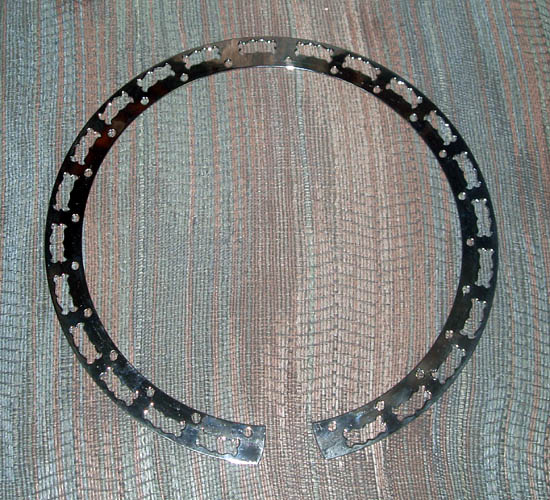
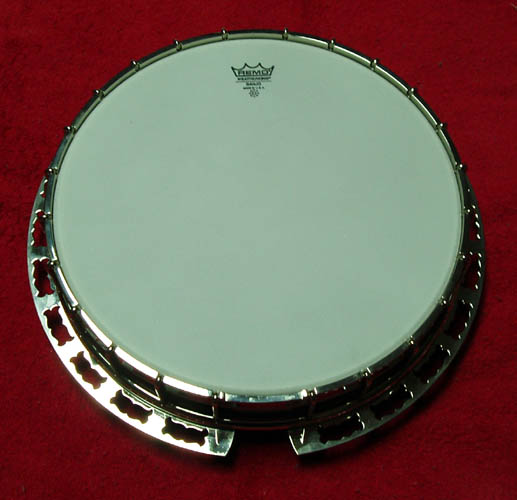
Above pix of my Flaming Claw pot assembly which will be
serial number 001FC with a Cox maple wood rim, Gibson USA Kulesh flat head tone ring
# 7236,
Porter Flaming Claw two piece flange, Huber Mahogany resonator and a Porter Custom Flaming Claw neck also in
Mahogany....See my banjo construction
home page for details. Finished banjo pixs below:
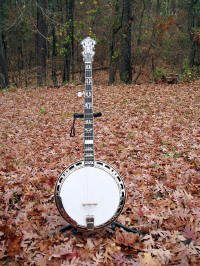
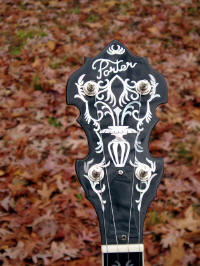
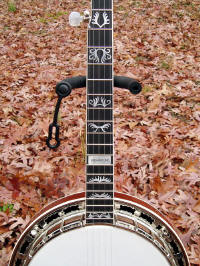
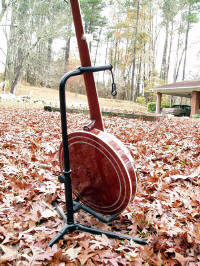
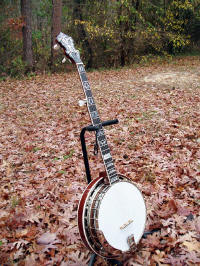
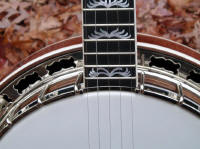
Banjo completed in late November 2010 and is
"one of a kind." I
plan to add a custom "Flaming Claw" armrest later. Never got
around to the armrest.....grin if you must!
I retired the above banjo to its case in January 2017
and started playing my custom build resonator guitar in our
Church and
other Church
functions.
The above banjo was brokered (sold) by my friend David
Musselwhite, Jonestown, PA in December 2021.
Web page updated by Bill aka Mickey Porter on 03-28-18
and 12-23-2021.
Around 1976, I started inlaying an engraved mother of
pearl PREWARTONE block at the 15th fret to the
fingerboards of my Flaming Claw banjo and used the
logo PREWARTONE on my banjo
strings and received a US Trademark Reg. No 1,044,105 on July 20, 1976 for
PREWARTONE.
I never did go into production with the banjo, because I could not keep up
with the custom inlay and parts sales. The parts and inlay business
was really booming after the movie Deliverance came out in 1972 featuring
the instrumental "Dueling Banjos", but sales started really
dropping fast before the end of 1977 due to the 1973 - 1975
recession we had. I had a lot invested in tooling,
whereas Japan started turning out "imitation" parts,
accessories, inlaid Gibson style fingerboards/pegheads, banjos and
reproduction stuff like
crazy. Japan supplied a tube and plate Gibson copy flange retail priced
cheaper than my raw material cost for my own replica two piece flange!
MAIL ORDER CATALOGUE
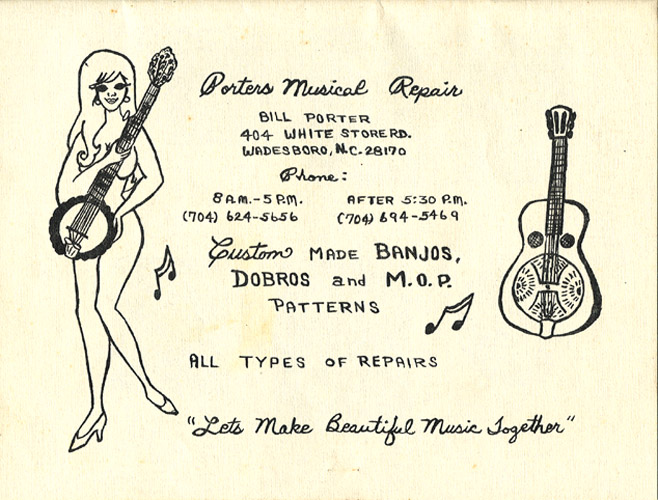
Pix above of my 1970's catalog mailed out and hard to
believe the price of a Gibson flat head tone ring which retailed for $33.00. A saying from one of my Ole Timer's
Club friends Brutus
Gale, "That was back when a dollar was big as a bed sheet"
which was a fairly accurate statement; a little before the inflation
of the mid to late seventies kicked in.
MINIMUM WAGE 1970
When I started my musical instrument repair service,
the minimum wage was $ 1.60 per hour and made some decent money from cutting
and selling pre-cut and inlaid patterns, mostly pre-war Gibson banjo
patterns which were in demand. See my
inlay patterns
page which details the time taken to cut 29 patterns of various Gibson
pre-war banjo mother of pearl patterns which averaged out to a little over
32 minutes per pattern.
I find it hard to believe
today that one could keep so many things going, but when you are in your
early twenties, the energy and enthusiasm level has to be at a maxim
as compared to the senior citizen status now....grin on that statement.
It was an excellent experience and did meet and make a lot of friends over the years!
The above address (now a vacant field) and telephone numbers are
obsolete.
1970 INLAY PRICES FROM THE ABOVE
CATALOG
Below a scan of the inlay prices in the early to mid
1970s; inflation has certainly took its toll..........grin if you must!
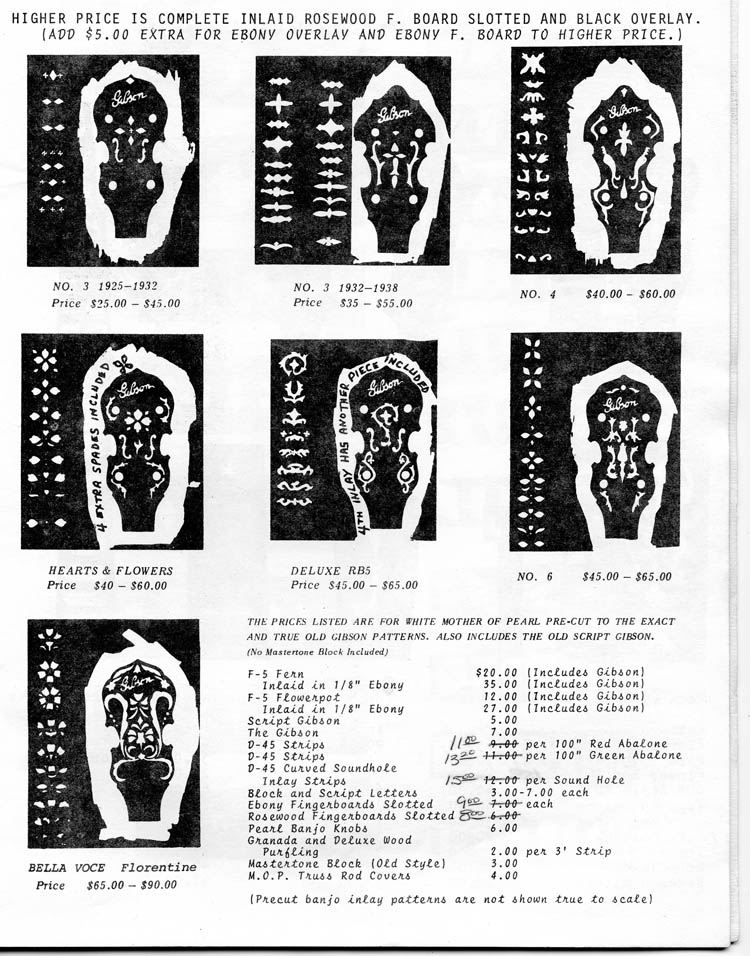
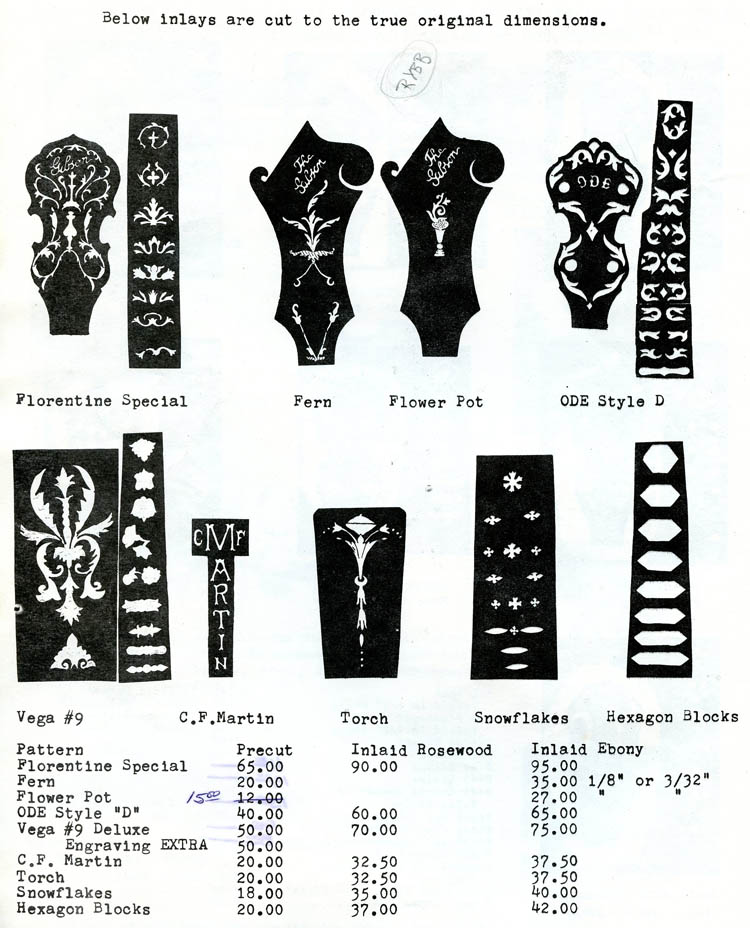
Above pixs of inlay patterns were hand drawn and
definitely not true to scale! Check out my
inlay patterns
page for pixs of actual cut inlays by yours truly.
I would grin when people came from various parts of the
USA to visit and purchase parts thinking I was an old man.......grin if you
must! I was in my 20's at that time and now 78 as of 03-18-2024!
During my mail order business days, I purchased metal
standard stock banjo, mandolin and guitar components directly from
manufacturers that supplied Gibson and other musical instrument
manufacturers like; Kluson, Waverly, Grover, Zaharoff,
Bird's Eye Maple, Schaller, Harris Ltd., etc. and
was able to sell at a minimum of 20 percent below retail price (MSRP) and items
manufactured in West Germany (specialty items) such as wood purflings,
bindings, etc. , a sizeable mark-up was possible before the devaluation of
the dollar took place. Ebony back in those days was jet black with
very little white streaks and the wonderful Brazilian rosewood before the
trade embargo!
I had Mr. Lomb of
Waverly Musical Products in NY to manufacture the old style banjo
nuts for me and was probably the first one to offer those old style long hex
nuts to banjo builders via mail order. All Waverly had to do was make
a special set of cams for their machines and the rest is history.
StewMac offered the same banjo nuts when they procured Waverly Musical
Products in the mid 1970s or later.
MOTHER OF PEARL
Pix
of several banjo fingerboards and pegheads being inlaid with mother of
pearl. Mother of pearl price in the early 1970’s was around $35.00 per
pound. Now the price is over $400.00 per pound. In the 1970's,
Porter was considered
"The Source" for accurate Pre-War reproduction
inlay patterns. I normally kept about 20 sets of pre-cut inlay
patterns for each standard pattern on hand and inlaid in the Gibson pre-war
style by cutting a hole through the peghead and fingerboard material.
With many pre-cut inlay pieces on hand, I was able to choose an individual
inlay piece that matched the pre-cut hole in the peghead and fingerboard
with a high degree of precision. Gibson and their vendors stacked up a dozen or more
peghead veneers and pegged them together and cut through all of the veneers
using a German made marquetry saw using a large #6 jewelers saw blade. If
your saw is accurate enough and you don't force feed/cut the material, the
piece on the bottom of the stack will match the original pattern very close.
Inlays produced today using the high technology CNC machines are far
more accurate and precise, but lack the individual artistic touch and
variation in design that the Gibson pre-war instruments posses.
Post-war CNC and/or rotary machine production inlays emulating Gibson patterns
from the early to mid 1970s from their vendor(s) look like they are cut using a cookie cutter,
e.g., RB800,
meaning each individual piece is exactly like the other without the old
style square saw cut backs into the design which gives it character and eye appeal.
It is to my understanding that Mar Pearl did a good bit
of inlaying Gibson's fingerboards and pegheads during the 1970s. I
have personally talked with David E. Markle (now deceased) and he designed
all the machinery used to route the inlays and pockets for the inlay work he
did for Gibson. He was running about 10 custom built routers that had
all the whistles and bells and I believe used a cam system to produce
identical inlays that used more or less an outside profile......long before
the CNC stuff. He also dusted his own diamond wire for cutting
inlays to use on his own diamond wire machine...he was at the top of the
inlay game back then for production stuff.
Gibson and/or their pre-war pearl vendors used poplar wood (heavy veneer) at least 1/10 inch as a backing for
their Mother of Pearl and Abalone inlays and it not only gave support to the
material, but used as a means to maneuver the material into the
jewelers saw blade. I have seen a few tenor/plectrum necks
cannibalized for the inlays that had mahogany used as backing for the mother
of pearl inlays, but this is rare! The German made marquetry saws Gibson used for
their pre-war inlays has long since been out of production and the new
machines are not as accurate in my humble opinion and do not have the stroke
length to utilize more of the jewelers saw blade.
CNC machines (routers) producing mother of pearl and abalone
inlays and inlaid fingerboards and pegheads is definitely the way to go for
production and there are some fine examples of artistically
produced designs
only limited by the programmers artistic ability since
cutters
are now very
small and durable! I certainly don't mean to detract from the many
artists using those machines, but I personally don't like them on pre-war Gibson
inlay designs though. It just doesn't have that variable hand cut look
to the inlays. CNC machines definitely has the precision not found in
hand cut designs. I am sure if Gibson had access to such machines in
pre-war days, they would have used them! No more inlays that I do, the
cash outlay just doesn't justify owning a CNC machine.
A trick in removing Gibson inlays and backing
from pre-war fingerboards is to use vinegar saturating the inlay area and
the vinegar will normally dissolve the binder used in the filler. Try
it and you might be surprised! The trend now days is not to
destroy the original tenor and plectrum necks, of which I don't ever
remember cannibalizing one for inlays.




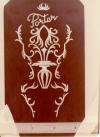
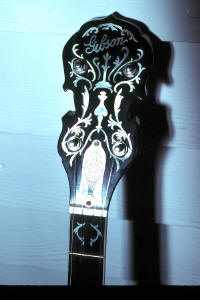
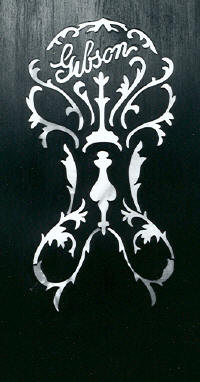
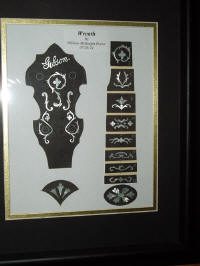
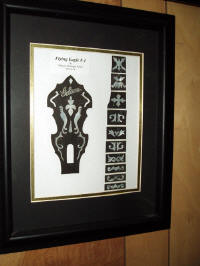
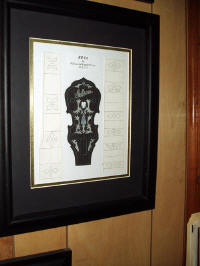
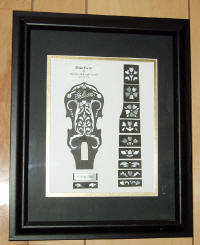
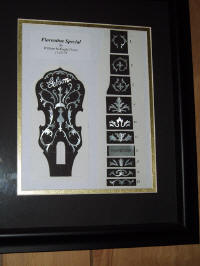
Above pixs of a few of my Gibson Mastertone banjo
mother of pearl inlay patterns
(master patterns) I cut and had
them photographed and offset printed patterns for cutting and inlaying
purposes. Little digital camera doesn't capture the detail in the cuts
since they are mounted under glass. It was individuals like
myself and many other custom instrument makers that "forced" Gibson
Musical Instruments to reintroduce their old style Mastertone series banjos
due to the huge increase in demand. It only took them about four (4)
decades to get back on the band wagon so to speak.
NOTE: GIBSON USA takes a firm
and aggressive stance against all makers of counterfeit instruments and
their distribution channels, therefore I would caution anyone against making
a complete Mastertone aka Masterclone of their instruments, present day and
past using the Gibson
logo on the headstock although the early inlay patterns sans the Gibson logo
are subject to public domain.
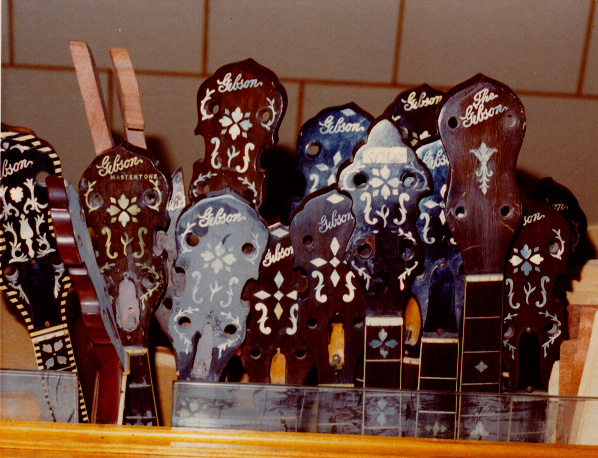
Pix of some of the Gibson Mastertone Pre-War tenor and
plectrum necks collected over the years of which most were manufactured
prior to 1930 as evidenced by their FON and the quality of the inlays. I counted about 35 at one
time and had an original Pre-War five string
RB3 (late)
neck that Tom Morgan
of Tennessee had cut in half to see how the truss rod worked; at least
that's what Paul Tester of Landover Maryland - deceased related to me of
whom I purchased the neck from. The neck was operational at the time
it was cut in half end to end and I believe had a broken heel that was repaired. The above
1/2
RB3 neck (5th string side) is in the
above pix, 4th from left in the background beside the Hearts & Flowers neck
which has the Mastertone letters inlaid in the peghead! If
memory is correct, the truss rod configuration is opposite from what one
would think, but what makes it work is the entire truss rod is still below
the center line of the neck, therefore the weaker side gives it in to the
force straightening the neck if the neck is bowed. However, the truss
rod doesn't work for a back bowed neck. My entire Gibson pre-war neck
collection was sold to Wayne Peterson in Minneapolis, Minn., but he
said he didn't get the pre-war 1/2 5-string banjo RB3 (late) neck and can't
remember who I sold or traded it to or if I had both halves of the neck at
one time either! CRS disease I guess! The 1/2 neck did
have some of the original inlays still in the headstock and fingerboard at
the time I owned the neck.
Below is a cropped pix showing the 1/2 Gibson pre-war
RB3 neck when I owned it:
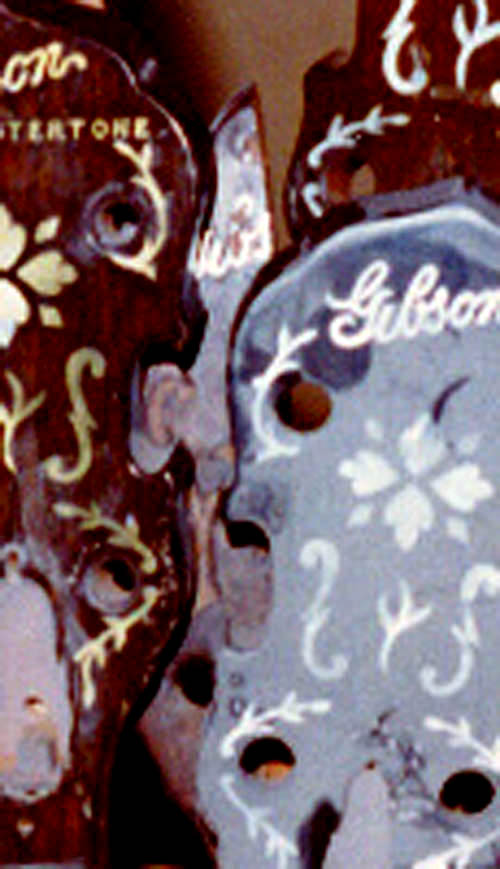
Pre-war Gibson banjos for the most part, did not have
the poplar wood backing on peghead inlays since the inlays were approximately
the same thickness as the peghead overlay veneer. However, the
fingerboards did have the poplar wood backing. On my
banjo construction
pages, I detail how Gibson and/or their vendors manufactured the pegheads
and fingerboards. Gibson outsourced about all their production inlay
work, but did do some in house inlays per George E. Hall, Gibson employee from
1927 thru 1933.
UPDATE on the RB3 late 1/2 neck cut in half
lengthwise; I talked with Jim Runnels at Huber Banjos today 11-16-11 and Jim
verified that the neck they have is the one pictured above, RB3 late model
leaves and bows and also has the neck heel repairs. There is a link on
the Banjo Hangout that gives a complete history of that RB3 late neck.
Joe Spann sent pixs of the RB3 late 1/2 neck and someone had removed the
peghead overlay cap and replaced it with a much thicker material (without
inlays) and had distorted the true shape of the peghead some. I can't
say for sure it is the same neck, but in all probability, it appears to be one
and the same. Why someone would saw the original headstock veneer off
the 1/2 neck blank and replace it with a regular piece of wood is beyond my
reasoning.
http://www.banjohangout.org/topic/220350
I also talked to Tom Morgan on 11-17-11 and he
remembered the neck very well, however I failed to ask him where he got the
neck from. Tom did state that it did not come from Paul
Champion's banjo. Pix of Tom Morgan below:
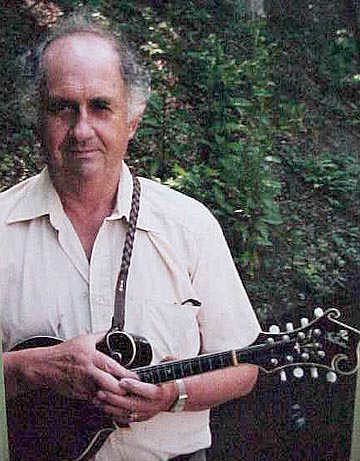
Tom Morgan from Dayton, Tenn. is considered
"The Dean of Bluegrass Luthiers" and
through Paul Tester (deceased), I received very valuable information, samples and
specifications of Pre-War wood purflings, bindings, inlay trim,
original neck carved heels for carving patterns, etc.; to have those
specialty items manufactured in West Germany that were not available at the
time, whereas I later offered them through my mail order catalog to
builders.
Tom was decades ahead of the old and new pack of banjo
builders/banjo gurus and certainly is "THE DEAN OF
BLUEGRASS
LUTHIERS"! Take a look at the below links
for additional info:
http://lfs.alexanderstreet.com/liner/39a76d2a16f1b32a3e4ce0b34d9cf8e4/FW31072.pdf
DC Bluegrass
Union
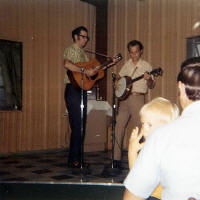
Picture of Paul Tester picking his RB5 Wreath Deluxe
arch top banjo with Harold Wilson 1972 or 1973. Photo
courtesy of Harold Wilson.
Note: Wayne Peterson doesn't have any of
those Gibson necks left, however he does have plenty of old catalogs and a
few other odd ball necks and other things of interest for the collector! 10-29-09.
I used the best of Gibson's inlay work in order to get a
master pattern cut for myself. Some of Gibson's inlay work were
horribly cut and most of their inlaid fingerboards and peghead has a
tremendous amount of filler, but I have seen some examples that would be hard
to replicate that were nearly perfect also. The workers at the factory
were on production and got paid extra for anything above their production
quota according to George Hall of Kalamazoo, Michigan - deceased.
There were a few "odd balls" in the above group made by Gibson and had a Bella
Voce with a different fingerboard and have seen and had original necks with
mismatching inlay patterns apparently ordered by the original customer. It appears that Gibson's only consistency was their inconsistency!
I believe my assessment of pre-war Gibson would classify as a true
paradoxical statement.
There is a very noticeable difference in the quality of
Gibson inlays prior to the 1930s and surviving records point that two
different companies provided Gibson with inlaid mother of pearl pegheads and
fingerboards before and after the 1930s. Joe Spann, Research Library
Director is authoring a book on
Pre-War Gibson which will uncover and unlock
a lot of information concerning various facets of Gibson's history and
banjo production!

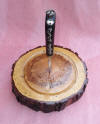
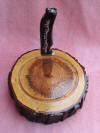

Above pixs of a custom inlaid Smith and Wesson skinning
knife that I did for myself around 1975. I retired that knife to my
show case in the early 1990s. The
mother of pearl inlays are from a copyrighted pattern of mine titled
“Flaming Claw” and my standard pattern I used on banjos and Dobro
aka resophonic guitars. The inlay work on the knife handle was all
free-hand if I remember correctly due to the curvatures of the handle on all
sides. The above knife, glass display dome and other inlaid and
custom knives were given to our son,
Bill Jr., on 07-08-16.
Specialty items and parts such as the Pre-War Kershner
banjo tailpiece, banjo hook nuts, Pre-War wood purflings
for Gibson Mastertone banjo Granada, #4, #5 Deluxe and Martin
Pre-war wood purflings were made in West Germany for me and the first to
offer those exact reproduction items for sale. I also had F-5 style
bridges made in Germany. There were some close
imitations out there, but none as precise as those I had made. Note:
Pre-War references prior to WWII.
JIM YARBORO NOBLE TOP TENSION BANJO
Jim Yarboro sent me a couple pixs of a banjo he built
in 1986 using one of the Flaming Claw peghead overlays that I cut and
inlaid. I traded Jim a dozen of those inlaid peghead and fingerboards,
(If my memory is correct) that had my copyrighted Flaming Claw
pattern. I currently have patterns 13
& 14 on a banjo and resonator guitar. Jim inlaid a mother of pearl
engraved Noble block where the script Porter would have been. Below is a pix of
the banjo that recently came back to him for a set-up, of which the banjo
was sold by Gruhn Guitars of Nashville, TN to its current owner.
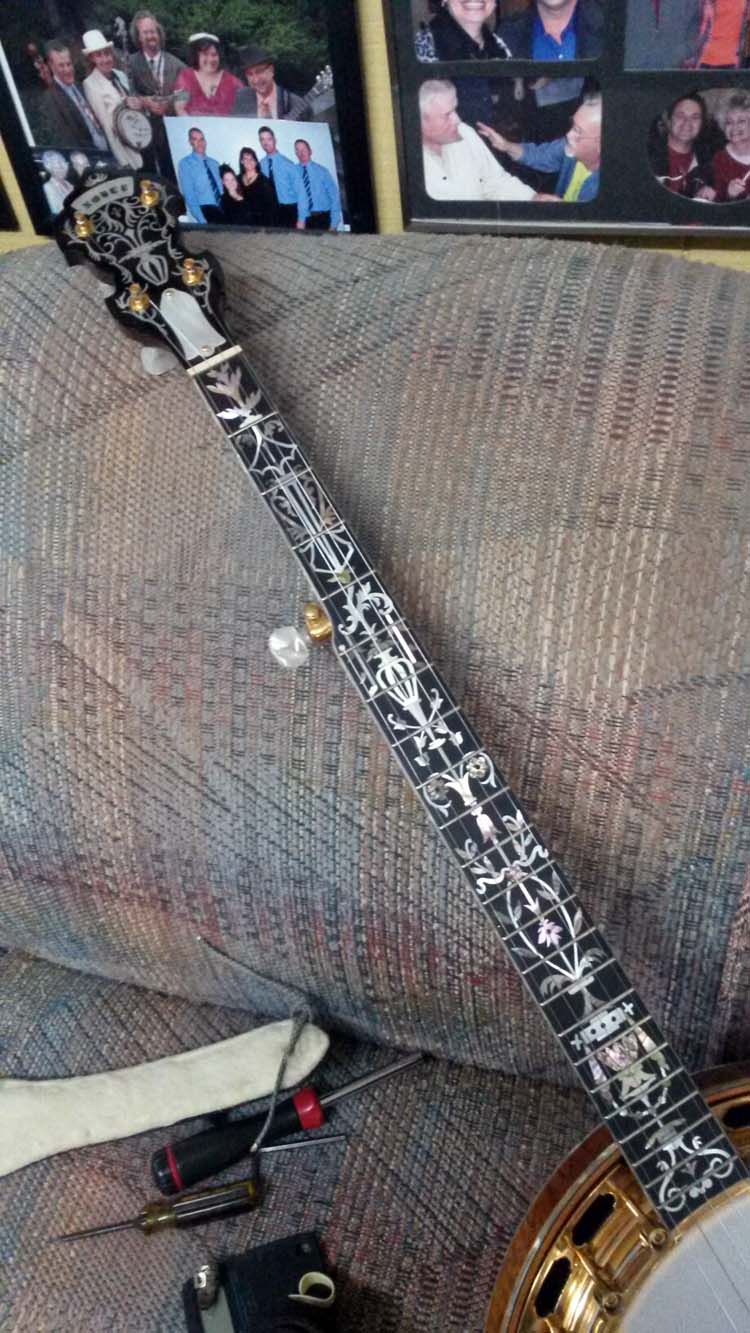
Jim purchased a pre-cut set of the tree of life inlays
and said it took him all night to inlay them. Jim is a top notch
craftsman!
Updated webpage by Bill aka Mickey Porter on 06-22-18.
RESONATOR BACK FROM MY PRESS
Below is a pix of the resonator back on the above
banjo. I traded and/or sold Jim a number of resonator backs in curly
maple and figured walnut, but no side walls. Jim stated the resonator
back came from me.
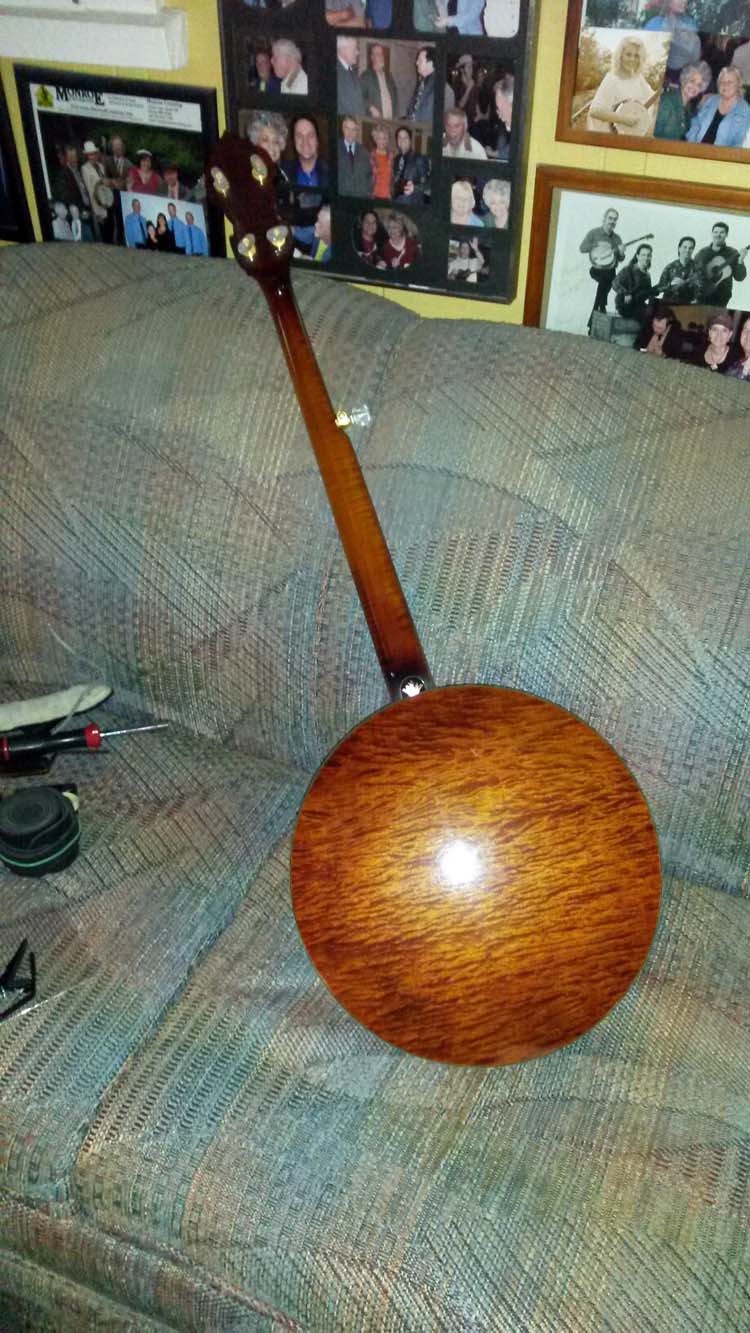
Part of my early banjo research and development
involved having several pre-war Gibson Mastertone banjo tone rings (flat head
and raised head) analyzed
with the then state of the art spectrographic analysis machines to
ascertain what the actual composition of their tone rings were and for those
that think it was some great secret, the alloy used was a standard
Navy G bell brass alloy according to former
Gibson employee George Hall (deceased) who worked for Gibson from 1927 through out 1933.
The thing about pouring a composition alloy
made up of different metals such as copper, tin, zinc, lead and other
metals, the evaporation rate and alloy will change when reheating and
pouring the same ingot and the analysis results proved this and enough
tone rings were analyzed to find out the common alloys used.
It should be noted that alloy composition
specifications usually has a specified tolerance; minimum and maximum
percentage of variance of the main element used such as copper which can be
as high as four (4) percent which can actually be classified as a different
alloy mixture specification. A good example is the closeness of
QQ-B-691 Comp. 6 and QQ-B-701a grade 6x tin bronze alloys below.
During THE GREAT DEPRESSION ERA, it appears from
spectrographic analysis results that Gibson apparently used what ever copper
alloy either Navy G, Tin Bronze or variants supplied to them of which is
understandable.
Joe Spann, Research Library Director, posted an article on
08-19-09 in www.banjohangout.org
whereas, he researched surviving Gibson financial records showing large
regular payments to
Star Brass Works of Kalamazoo, Mich.
(circa 1895-1961) from Gibson that reached
a high of 3600 dollars per month as of April 1930 and very convincing evidence that
Star Brass Works was
Gibson's main and/or only source for tone ring castings at the
time. Joe authored a book titled,
SPANN'S GUIDE TO GIBSON 1902-1941; click on the hyperlink to take you
directly to www.amazon.com for purchase.
I highly recommend this very informative one of a kind reference to Pre-War
Gibson.
As for the best sounding pre-war tone
ring to my ears it was the Tin Bronze alloy and not the
Navy G, but that is only my opinion since hearing is subjective. I have
heard one stainless steel tone ring mounted on a good three ply wood rim
that had it all; ring was turned from a solid piece of material (440C?) and not
cast. Far to expensive to attempt to manufacture and sell one that
way!
Many have asked about how Gibson pre-war
tone ring alloys varied and the COPPER content varied
from a minimum of
64.87 percent to a maximum of 98.8 percent.
The 98.8 percent Copper (Cu) was from a TB7 flat head tone ring
which was the most radical departure from the Navy G bell brass or tin bronze.
I received sample scrapings from John Monteleone Guitars of Islip, New York
on 03-19-76 of the above tone ring and also traded some mother of pearl
inlays to John Monteleone for a couple partial castings of the tone ring
shape for my research.
An analysis from a TB3 40 hole raised head FON 9237-10 belonging to James Fuquay (deceased) of Danville, Va.
had a Copper (Cu) content of 64.87, Lead (Pb) content .87,
Iron (Fe) content .052, Tin (Sn) content .082 and Zinc
(Zn) content 34.05 and Nickel (Ni) content .072 and smaller traces of
Bismuth (Bi) , Arsenic (As) and Silver (Ag) no doubt
products of the plating or impurities.
One of the lower FON
40 hole raised head tone rings model 3 FON
836-1 1930s had the following: Copper (Cu) content 86.9, Tin (Sn)
content 8.3, Zinc (Zn) content 4.1 and Lead (Pb) content .7
all in percentages. This tone ring was nearly identical to QQ-B-691
Comp. 6 called Tin Bronze. I received a
portion of the above raised head tone ring from Clarence Hall of Stuart, Va. on
01-01-75 for the analysis. Notice this alloy is very close to the
QQ-B-701a grade 6x that Gibson found on the 1929 TB-3 raised head tone
ring they had analyzed!
Current alloy
matching the TB3 RH Tone ring FON
836-1 is Leaded Tin Bronze
aka Leaded "G" Bronze UNS Copper Alloy C92300
with composition as follows: Copper (Cu) 87%, Tin (Sn) 8%,
Zinc (Zn) 4%, Lead (Pb) 1%. I don't believe you will find a
standard alloy today that is closer than the
C92300
to match one of Gibson's Pre-War tone rings that I had an
analysis done on. In the below pix, Clarence Hall has a 1925 Gibson
RB4 FON 8134-10 which has a unique history.
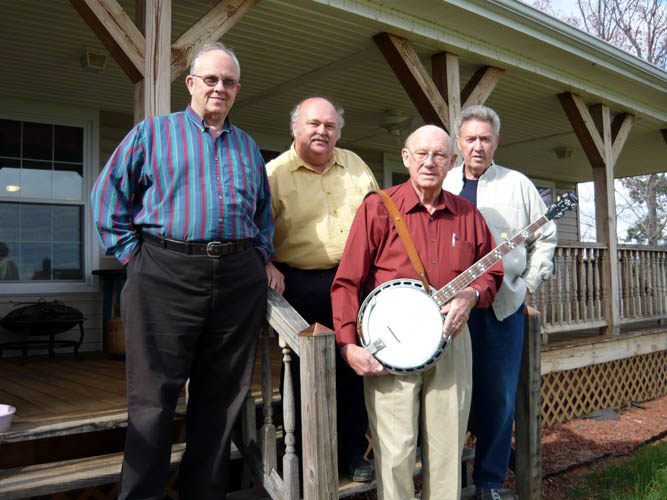
Left to right: Gene Parker, Doug Hutchins, Clarence Hall (now
deceased) and Allen
Mills
A pre-war raised head Gibson
banjo Uke tone ring 8 inch diameter (never installed) serial number 69
with no holes drilled in it was found at the factory by Davis E. Kennedy who
worked for them prior to 1970 and the analysis of that tone ring was:
Copper (Cu) content 69.8, Lead (Pb) content .006, Iron
(Fe) content .013, Tin (Sn) content .042, Nickel (Ni) content
.014 and Zinc (Zn) content 30.1 percent. I let Jim Yarboro of Gun
Barrel City have that tone ring several decades back of which he sold it to
Wyatt Fawley who is making a 3/4 size 5 string banjo using the tone ring.
Gibson did their own analysis of a 1929 TB-3 raised head tone ring per
Davis aka Dave Kennedy who had a copy of the original document as follows:
Copper (Cu) 84.48, Tin (Sn) 10.63, Lead (Pb) .43,
Iron (Fe) trace, Zinc (Zn) 4.5 balance and all are approximate.
Alloy commonly called trolley brass similar to Federal
specification QQ-B-701a grade 6X or 85-10-1-5 referred to as Tin Bronze.
It should be noted
that trolley brass is a much harder alloy than the
QQ-B-701a grade 6X alloy tested by Gibson and not to be
confused with this alloy QQ-B-701a grade 6X
which is Tin Bronze and not true
trolley brass
Trolley brass was used to manufacture trolley wheels
that contacted the overhead trolley line (power source) to make the
connection to the motors on the trolley cars and had to be a hard enough
alloy to prevent premature wear of the wheel. Picture taken from the
internet of what a trolley wheel looks like:
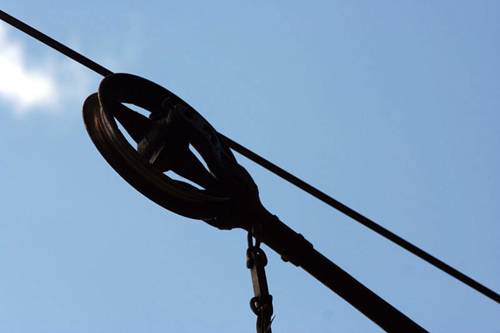
Open this
link for additional
information.
Gibson tone rings from the period
1949 to 1969 were as follows: Copper (Cu) 85%, Tin
(Sn) 5%, Lead (Pb) 5%, Zinc (Zn) 5% per alloy
specifications which doesn't mean that is what they always obtained. I do
not have the original document on file to validate so take it or leave
it since I relied on notes taken. I have never been impressed with
those tone rings which has too much lead to tin ratio. Here again, this is
my personal opinion! These rings
were later manufactured by
Riverside Foundry and Galvanizing Co. and weighted
about 3 lbs. 4 oz. if my memory is correct.
Gibson later flat head tone rings 1970+ era, catalog TOR898 were the
Navy G Bell Brass consisting of: Copper
(Cu) 88%, Tin (Sn) 8% and Zinc (Zn) 4% and their weight was
about 2 lbs. 4 oz. (far too light) and manufactured by
Kulesh. Fair
sounding banjos with a pre-war wood rim! These tone rings sounded horrible
on the Jasper Wood Products multi-ply wood rims that Gibson used at the time
on their new line of RB250s, RB800, etc. using the tube and plate design.
Again, if my memory is correct, they had a G stamped on the inside of the tone ring.
This tone ring had a good composition, but needed the extra mass to make an
excellent sounding banjo. My friend Jim Yarboro of Gun Barrel City, Texas
added an addition brass ring to the inside radius portion of this tone ring
to give it the extra mass needed. I don't have the date when Gibson
went back to the heavier (standard) 3 lb. 4 oz. + - tone ring which probably
was after 1978 when I sold my business.
I have copy of a
Gibson factory drawing
(reduced scale) of the 1970s TOR898 flat head tone which has G-BB stamped on
it on the inside of the skirt portion of the tone ring near the neck lag
bolt hole. Gibson later had the tone ring cast to the full weight from
the many complaints they received from vendors including myself that the
tone rings were far too light in mass. The original factory reduced
drawing depicts the light weight tone ring. It is to my understanding,
Gibson used a pre-war light weight flat head tone ring as a prototype for
their TOR898 1970s flat head tone ring, but I don't have any written
documentation as that info was verbal only. The reduced factory
drawing supports the light weight tone ring, but not my favorite weight tone
ring; a decent alloy though.
An example of a pre-war flat head with the light weight
flat head tone is one of the Royal P-T Mastertones FON 9360-13 shown
on Greg Earnest
website which validates post war Gibson did in fact copy an
original pre-war flat head tone ring for their TOR898 tone ring.
Why Gibson chose the Navy G
Bell Brass versus the QQ-B-701a grade 6X
or QQ-B-691 Comp. 6 called Tin Bronze
which in my opinion
is superior is a mystery which was available in the 1970s. All three of
these alloys are not that far apart and George Hall simply stated Gibson
used Navy G Bell Brass which is within
3.52 percent of these two alloys as far as the Copper (Cu) portion
goes and with the Zinc (Zn) portion within .4 percent; whereas the
Tin (Sn) varies 2.63 percent. Naturally, the mass of the above tone
rings will each be different in weight if machined to their standard
specifications because of the heavier copper element content variance and
will have a different "tap tone".
If I were to have a custom
tone ring cast today; I would use Copper (Cu) 85%,
Tin (Sn) 10% and Zinc (Zn) 5% which is very close to alloy
QQ-B-701a which is Tin Bronze and
machine the inside radius to where the tone ring weight was around 50 to 51
ounces. Without having a special formula cast, one could just as easily
use a standard alloy available today C90300
which is tin bronze and has a
nominal Copper (Cu) 87.5%, Tin (Sn) 8.3%, Zinc (Zn)
4.0% and as with any alloy there is a minimum and maximum tolerance
specified by the foundry/supplier and also a listing of the other impurities
which are very small.
Current Alloy UNS C92300
Leaded Tin Bronze aka Leaded "G" Bronze described above would also be a "dead ringer" to cast a matching
alloy to Gibson tone ring # 836-1. Find the right outside diameter tin
bronze pipe centrifugal cast with the correct wall thickness needed and
machine the tone ring from something that has already been cast and formed!
I do not have the manual that specified the breakdown of the alloys that
were standard and available back in the Depression Era of which many are now
obsolete. It went to the landfill with other research and development
materials that I had collected over the years.
NAVY M BRONZE
C92200 is another leaded tin bronze with
nominal % by weight as follows: Copper (Cu) 88%, Tin
(Sn) 6%, Zinc (Zn) 4.5% and Lead (Pb) 1.5% within the spectrum
of alloys found in the pre-war tone rings.
TOBIN BRONZE is a
tin bronze alloy that is within the spectrum of alloys that have showed up
in pre-war Gibson tone rings tested over the years by different craftsmen
looking for that Great Depression Era
sound with the "text book" composition as follows: Copper (Cu)
82.67%, Tin (Sn) 12.4%, Zinc (Zn) 3.23%, Lead (Pb)
2.14% with a few other elements to round out to 100%. John aka Jean
Janzegers used this alloy for tone rings he had cast back in the middle
1970s rendering good sounding banjos on a well made or pre-war 3-ply wood
rim. Tobin Bronze was used in the manufacturing of gears for the US Navy
and many other applications.
U.S. GOVERNMENT BRONZE, spec.
G is Copper (Cu) 88%, Tin (Sn) 10%, Zinc
(Zn) 2% with the tin and zinc being 2% different from the Navy G Bell Brass
of the TOR898 Gibson 1970s tone ring. Most of the 1970s Kulesh tone rings
were machined way less than 3 lbs. and more in the range of 2 lbs. 4 oz.
Naval Bell Brass 523B2
is now obsolete and consisted of: Copper (Cu) 78%, Tin (Sn)
22%. Note: Higher tin content provided better protection in the
harsh salt water environment, but makes a harder tone ring to machine.
Commercial Bell Brass 523B2a
consists of: Copper (Cu) 81%, Tin (Sn) 19%.
Paul Tester (deceased) of Landover, Md. related to me
on 09-16-76 that Steve Ryan's tone ring
alloy was composed of: Copper (Cu) 80%, Tin (Sn) 15% and
Zinc (Zn) 5% according to Steve Ryan. I do know they were top of the
line tone rings making excellent sounding banjos and some of his flat head
tone rings went as high as 3 lbs. 9 ozs. in weight.
Gibson prewar tone
rings can be grouped with those with ZINC (Zn)
content about 5 percent and those with ZINC (Zn) content about 30 percent.
I don't have a clue as to why the ZINC (Zn) content varied that much in the
prewar Gibson tone rings that I had analysis reports completed on other than
a totally different alloy mixture and composition! Since Gibson
used Brass Star Works (foundry) there in Kalamazoo, Mich. for their tone
ring castings and other cast brass parts, whereas, Brass Star Works also
poured castings for overhead brass trolley wheels at that time which had a much higher
zinc content for wear ability, one can surmise they used some of the same
ingots to pour the Gibson tone rings both arch top and flathead tone rings
as evidenced by analysis reports conducted. Several other
individuals and companies have done extensive analysis of Gibson pre-war
tone rings and it is to my understanding their findings like mine prove that
Gibson used whatever bronze and/or brass alloy casting that was supplied by their
vendor(s) with the alloys all over the the bronze alloy spectrum.
Getting some of them to publish their findings might be difficult since they
are in the business to make money and desire to stay ahead of any serious
competition which is good business sense. I definitely do not buy into
all the tone ring hype either. Sound perception is like beauty, only
in this case, "Sound and tone is in the
ear of the beholder".......grin if you
must!
Pre-War Gibson Employee George E.
Hall who worked for Gibson circa 1927 thru 1933 whom I mention numerous
times on this page, verbally told me that Gibson used Navy G Bell Brass for
their tone ring castings. No one has uncovered any documentation as to
a specific alloy that Gibson specified, but George Hall worked there during
the debut of the arch top and flathead tone ring and was also an
Experimental Manager at one time. George Hall was definitely in a position of know,
however analysis reports show the extreme wide variance of the alloys that
are present in those pre-war tone rings both arch top and flathead.
My research did not reveal any
two tone rings having exactly the same composition (although
close enough to identify a specific intended alloy) and doubt
there are such tone rings, but it certainly is possible. Tone ring high
profile (flat head) weight and mass, (45 to
55 oz.) depending on the alloy either Navy G Bell Brass, Tin Bronze or alloy
mixes between those are more critical
to that ole pre-war flat head sound (tone ring portion only)
than a percentage or two variation in a specific alloy. I am referring
to the basic alloy components of copper, tin and zinc. Other alloys
added for machine ability such as lead, however does make a drastic change! Changing
percentages of alloy components varies the tone ring weight even with the
same physical tone ring size/dimensions. My favorite Gibson pre-war
flat head tone ring weight was from 50 to 52 ounces to my ears and produced
the sound that I liked the most, however many 48 oz. tone rings are
excellent as well!
With all the well known and talented individuals and
Companies manufacturing and selling tone rings with claims their tone rings match the Gibson pre-war
formula, I surmise about any tin bronze
composition/formula either current, pre-war or obsolete alloy used today would substantiate
and validate said claims due to the wide variance of alloys that are in
those Gibson pre-war tone rings!
There is simply
NO
single
Gibson Pre-war Tone Ring Formula!
Period. Show me a pre-war document
detailing the alloy and I will "eat crow",
figuratively speaking that
is!
I have to grin at
all the claims of the new and improved pre-war original clone tone rings
from the same makers every few years, but that is what keeps $ cash $ in the cash registers and banjo makers and pickers happy! I am not discounting
that some later clone tone rings are better than their earlier counterparts
and some worse, but it is possible to do it right the first time with all the technology at
our disposal today! One of my pet clichés, "Normally you get
what you pay for"
doesn't always work for the vast amount of high dollar,
high technology Masterclone tone rings available today. I
expect the next development will be some secret alloy mined from the surface
of the moon to give that pre-war sound. Grin if you must!
I certainly do not buy into all the post-war tone ring hype although
different tone rings can make a difference in individual banjos, which can
go either way in tone enhancement.
If your pockets are keep enough,
purchase a new 2K plus high dollar tone ring.....each to his/her own and in your own
mind, it will be worth the investment since the brain will hear that tone
whether real or not! Yes, I am grinning too!
I can make the analogy or
comparison of the sale of prewar clone
tone rings to the deer hunter who will spend 40 dollars per ounce for deer
urine taken from one single doe in heat (estrous) in hopes of harvesting the
next Boone and Crockett World Record Buck and that is about as clean and to
the point as I can tell it!
The problem is not so much as knowing what the intended alloy is in some of
those pre-war tone rings, but the difficulty in getting a consistent pour
from tone ring to tone ring! A single tone ring using the old sand
cast method that was widely used in the depression era might yield several
different analysis results at different places within the tone ring due to
the method of pour and the cooling rate. Today, there is
technology
available that is non-destructive to the
part being analyzed and it would be great if someone
would take one of their "Holy Grail" banjos and have the tone ring
analyzed at different places to ascertain what the alloy is and the variance
at different places of the tone ring
and let the rest of us in on it! But wait, the magician doesn't
reveal his secrets either...go ahead and grin because I am!
Even with the known composition of a pre-war flat head tone ring, and a
reproduction with an exact match, that still doesn't guarantee you the
pre-war sound even though very, very close!
This could be the (missing link)
that I have overlooked and maybe others too! However, I have taken
samples near the top of tone rings, the lower portion and mid-way, but have not
had several samples taken and analyzed from the same tone ring to ascertain
a metal pour variance
within the tone ring!
Centrifugal casting of modern tone rings is
far
superior to the pre-war sand cast method producing a much more consistent
and purer tone ring, however the expense is greater for short production
runs! We must remember that Gibson was a "Production Orientated
Company" and built banjos as cheaply as possible for profits with the
available technology of the time!
Tuning individual components like
sound boards and backs for maximum resonance along with other instrument
components ceased to exist after Lloyd Loar left Gibson and production and
profits became paramount. Accurate electronic acoustical testing
instruments such as signal generators, frequency counters, dual-trace
oscilloscopes, sonograms, etc. were decades away, therefore trial and error
time tested methods were in usage at the time! Has the banjo made any
break through advancements since then with all the technology we have at our
disposal today? Not much in my opinion except for increased
production with the advent of CNC machines and other technologies!
"There is no one
single Magical banjo component manufactured today whether it is a tone ring,
wood rim, flange, resonator, neck, etc. that will match and fulfill the
sound that is in one's own head or psychic emulating the elusive Gibson
pre-war Mastertone sound; it is just the nature of the beast!"
I attribute this
phenomena as
PSYCHOLOGICAL BIAS. Simply stated, "Humans harbor biases.
These prejudices influence what we hear. In other words, if you EXPECT one
banjo and/or component to sound better than another - it will! This
phenomena or Psychological bias has been tested and proven by many
double
blind tests of all types to fully document and support this phenomena."
If the banjo
is not a pre-war original and uses the pre-war Gibson Mastertone design, it
is a copy or clone,
regardless of who made it! There is also a difference between a
reproduction, re-issue and an outright fake depending on your own usage of
semantics and who made the instrument!
Please feel free to quote me on the above statement
with all the "Copy Cats" out there making
banjos and still sucking "hind tit" without much
originality whatsoever! It is mere
economics and nothing else. In the past, I have been guiltily of
the same thing, but it is what the consumer wants however paradoxical as my
statement eludes to! If you use a Gibson one piece flange design (identical shaped tone holes), 3-ply wood rim,
flat head tone ring to Gibson's specifications, identical resonator shape and
configuration, basic pre-war inlay patterns, peghead shape, neck shape
including the hand volute; you still have a
copy of a Gibson Pre-War Mastertone aka a
Masterclone. The same goes for any instrument.
I have a sound file of a Gibson RB75
flat head Serial
Number DA5055 belonging to John Bowles which in my opinion is
"one of the best"
examples of what in my mind is the Gibson Pre-War Mastertone Sound;
brilliant highs, rich lows, right amount of sustain, even note clarity, note
separation and evenness throughout the range of the neck. The sound track
recorded without the benefit of EQ effects and studio enhancements and a
fairly faithful reproduction of the true sound. Strings were a few
years old on the "banjer"; imagine what it sounds like with a fresh set of
strings:
DA5055
sound file in .mp3 RB18 FON 744-1 owned
by a friend of mine Harold Chriscoe (now deceased) has the same type of tone and "rattle" as the DA5055.
Again, banjo tone is very subjective to each individual! I give the
edge to DA5055
only because it weighs less than 744-1.
UPDATE
I talked with Glenn
Chriscoe, one of Harold Chriscoe's sons today, (09-14-2022) and Glenn gave
me permission to place on this website that Harold owned Gibson pre-war
RB18 banjo FON 744-1, of which was later sold upon the death of
his Dad along with other valuable pre-war instruments.
Web page updated by Bill aka Mickey Porter on 09-14-2022.
Here is another sound file in .mp3 format with Gene
Parker playing
DA5055.
There is a massive difference from actually hearing
that sound and being able to hold the banjo and feel the nuance of
vibrations created of which permeates beyond the ear drum into the inter
soul and being of which words cannot adequately convey and describe!
Many have alluded that the "Holy Grail" pre-war banjo
sound so many have referred to over the decades as far as the Gibson pre-war
Mastertone flat head banjo itself, is more or less a product of accident or
random chance of the specific components. Every Gibson pre-war
flat head is not a jewel tone wise, yet still
has a certain distinctive sound, some much better than others! There has not been
conclusive evidence to support that Gibson actually did prior tests of
various tone ring metal compositions prior to the production of the raised
head
and flat head tone rings and there was no mention of any tests done by George
Hall, Gibson employee 1927 thru 1933 who was present at the factory with
the introduction of the both the raised head and flat head tone rings.
George Hall simply stated they (Gibson) used Navy G bell brass which was not an exact
science as evidenced by the spectrographic analysis reports of a sampling of
their tone rings. Gibson apparently used whatever tone ring casting
supplied to them from their vendors at the time. Gibson no doubt
requested Navy G bell brass, aka Tin Bronze from their foundry vendors
(STAR BRASS WORKS) for
their tone ring castings, however as stated, they certainly received tone
ring castings that are all over the spectrum. The Federal
specifications manual that I once had, broke each alloy down with a nominal
percentage by weight for each alloy within the composition and a minimum and
maximum allowance for each alloy which could easily be classified as
another alloy; e.g.,
QQ-B-701a grade 6X
or QQ-B-691 Comp. 6 called Tin Bronze. Look above to
see how close these two alloys are and others that are within the Leaded Tin
Bronze alloys. Gibson's goal was producing a quantity of instruments
as cheaply as possible yet maintain some level of Quality Control....you be
the judge!
Since original Gibson pre-war flat head Mastertone
banjos of all types are rare as far as their production numbers in
comparison to the raised head Mastertone banjos, it makes
them more valuable plus the majority of the banjo icons desired the
Mastertone flat head banjos for their Bluegrass sound. No one including
myself has a definitive scientific answer and/or evidence why those pre-war
Mastertone flat head banjos sound the way they do. Post-war Gibson
themselves and other banjo manufacturers have not been able to duplicate the
complex tone of those pre-war flat head Mastertone banjos although some of the
current Masterclone banjos
(copycats) are very, very close; e.g., Huber, Sullivan, Yates, etc., to that particular tone or "rattle" those Stallions possess. As
paradoxical as this statement, "I have little respect for anyone who is a
copycat." I have personally been there myself, but have seen the
light.....grin if you must!
How many times have "we" purchased an instrument
that had that magic sound we wanted at the time and find out a month or so
later after really playing the instrument that it did not have that magic
sound we were looking for?
Personally, I would own a stable full of those ole
pre-war Gibson Mastertone flat head Stallions, but
my pockets are too shallow...grin now!
Anyone who has owned or had the
opportunity to view original Gibson pre-war Mastertone banjos either
flat heads or raised heads up close and personal that have been completely
disassembled will find all kind of anomalies and various imperfections that
have been salvaged at the Gibson factory such as three ply wood rims that
have a couple additional filler strips glued in place on the resonator side
of the wood rim to hide very ugly ill fitting glue joints of which some
times the banjo is a complete dud because of a non-responsive wood rim.
Gibson placed the best fitting three ply laminations that did not need
filler strips next to the resonator (not always) and the worst fitting side
under the tone ring which was hid from view unless disassembled. Many times the
tapered maple
or poplar filler strips being 1/8 inch in width appear on both the upper and lower
side of the wood rim and extended about 1/4 inch in depth into the wood rim
and sometimes not that deep, just enough to hide the bad glue joint.
Raised head to flat head wood rim conversions will go beyond the depth of the filler
strips manifesting the bad glue joint and reveal the bottom of the channel
since the wedge shaped filler strip did not bottom out in the wood rim
groove cut and
there was an air or glue gap.
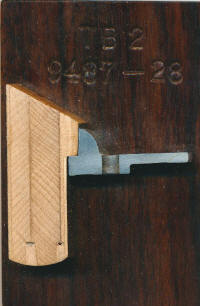 Photo courtesy of Frank Schoepf, Hampstead, Maryland
Photo courtesy of Frank Schoepf, Hampstead, Maryland
Above picture of wood rim TB2 FON 9487-28 that was
ruined by cutting it down to fit a Stelling flat head tone ring and
Bernd
Gassmann of Laudenbach Germany retrofitted another wood rim for the botched conversion
(of which he was not responsible for) and made the above wood rim slice and flange
cut away plaque
as a Christmas gift for Frank Schoepf, banjo historian and scholar
of Hampstead,
Maryland. You can clearly see how Gibson glued the tapered wedge filler
strips in place. Bernd Gassmann sent me an email on 05-15-13 about the
wood rim slice plaque he made for Frank and gave some additional
information, quote Bernd, "As Frank already mentioned, the rim was from a
Tb-2 conversion FON # 9487 – 28 and was totally ruined underneath the Tone
ring. When it came into my shop, a Flat head tone ring was installed,
just held in place by the head tension and had no contact to the rim on the
inside (there was a gap of about .040”) To my astonishment, the banjo had a
real good sound with a lot of punch and not too much sustain, which would be
normally expected from a free vibrating tone ring. Well, the good old
pre war rims – even working after such a fatal surgery!
As you can see from the attached pictures, the rim was originally made for
an earlier model (presumably a Style 0 or Oriole), since it had the 22 holes
for the shoe brackets, which were covered up by the lip of the flange. They
just glued a veneer in and outside the rim so it could be used again for
OPF-models. No waste at that time!"
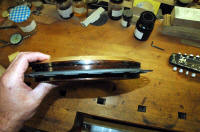
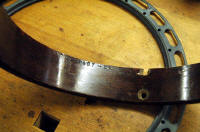
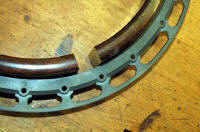
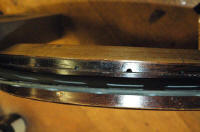
To use the ole cliché, A picture is worth a thousand words, more pictures
are even better! Pix of
Frank Schoepf (left in pix) and Bernd Gassmann, Master Craftsman and custom banjo maker in
Laudenbach, Germany:
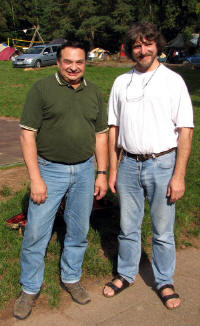
Below a scan of the top section of a TB11 wood rim
dissected end
view showing the installation of the tapered wedge wood filler strips:
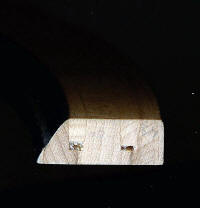 Photos courtesy of Frank Schoepf
Photos courtesy of Frank Schoepf
 Top view of TB11 wood rim
Top view of TB11 wood rim
I expect this was for
cosmetic reasons instead of a better sound, but from an
acoustic standpoint it would tend to be superior. I know of
one such original wood rim from a Pre-War Mastertone that was sawn in half
(not by me) to find out why the banjo was a total dud and revealed at least
an 1/8 inch width (void) space between one of the three ply
laminations the entire height of the wood rim which Gibson glued a filler strip on the bottom and top of the wood
rim to conceal the bad open joint. There are several theories about
"Dead Space" in wood rims as to the relationship of
vibration transfer within the wood rim from well know authorities, but I take
it as a grain of salt without merit! I equate such theories as
something that cannot be proven beyond a reasonable doubt; those
theories are simply an opinion! Tone rings many times are way too
loose (tone ring will come off wood rim if wood rim is inverted) by gravity
alone with too much slop or either too tight fitting
(tone ring will not come off the wood rim without excessive force or having
to use a band type clamp to twist tone ring off the wood rim) or worse heat
the tone ring.
Tone ring should be able to be removed from the wood rim with hand/thumb
pressure and at the point that you think you will not be able to get the
tone ring removed from the wood rim, and go back onto the wood rim without
much difficulty...that is the optimum fit in my
humble opinion, however many
prewar Mastertone
banjos have sounded great with a loose fit, but they probably would have
sounded much better with a proper fit. Improper neck heel
angle fit to the wood rim requiring the wood rim to be grossly distorted by
the coordinator rods to adjust the action has ruined many good original
banjo wood rims that have a permanent set (oblong shape) on the bottom of
the wood rim which can bend the lower portion of the tone ring out of round,
depending on the alloy used and thickness of the lower portion (skirt) of the tone
ring. The list can go on and on. According to
George Hall, Gibson Great Depression Era employee, they (Gibson) did not throw much stuff away if it could be used at
all due to lean depression times. Gibson carried that psychology of
being frugal into post war production as well.........looks like we might be heading that way
again too!
GIBSON STYLE 11 RESONATORS
RE-SURFACED
Over the many decades, the Gibson style 11 resonator
with the art deco pattern silk screened onto the pearloid material have been
"skinned" aka re-surfaced to find
a beautiful figured piece of of curly maple and/or figured (burl) walnut
that was used on their style 5 Deluxe banjos, Granada, Style 6, etc. In all
probability, Gibson used a perfectly good resonator already manufactured to
fill an order for the style 11 banjo sold during the depression era when
their more expensive Mastertone series banjos were not selling.
On the other hand, the resonator could have been a second, although many
that have been re-surfaced appear to be perfect in construction.
Below are pixs I received from Frank Schoepf, banjo
historian and scholar from Hampstead, MD on 09-20-2022 which had the pearloid material
removed exposing some beautiful figured wood veneer:
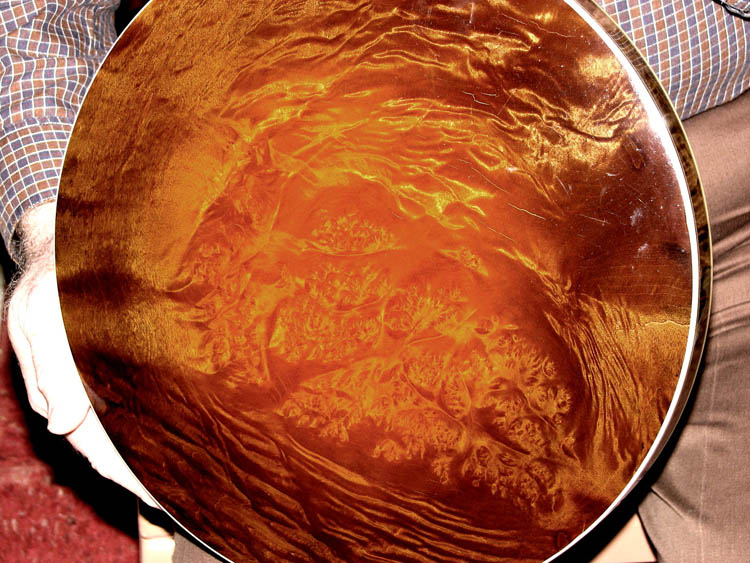
The above resonator Dick Smith found on a Kel Kroydon
and could see the sidewall inlay lines under paint, one of which was too
narrow. It blew him away because he had another style -6 with
resonator veneer from the same tree!
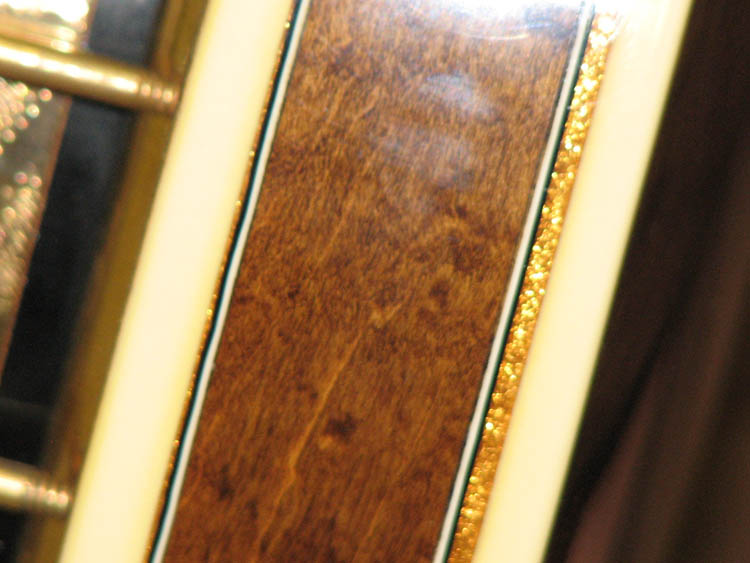
By the looks of the thin gold sparkle inlay, this must
have been a second resonator. As stated much earlier, Gibson did not
throw anything away that could later be used and/or modified, per George Hall, Gibson
pre-war employee, circa 1927 thru 1933!
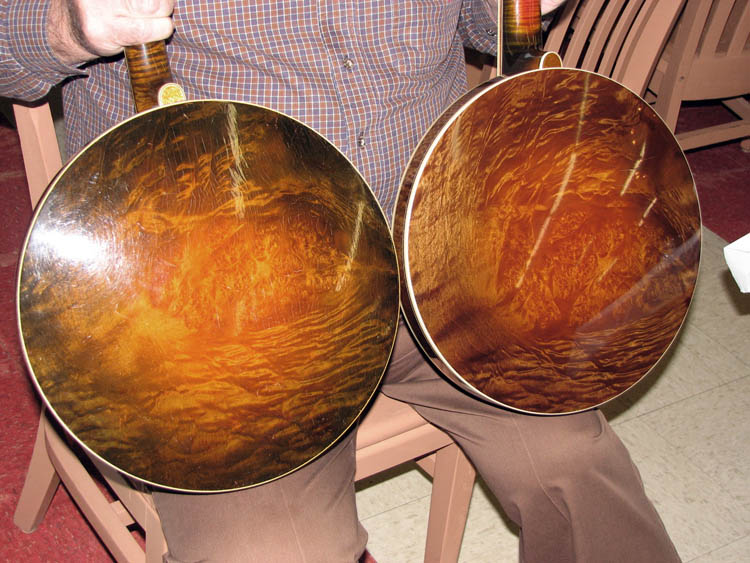
The above style 6 banjos, of which the resonator wood
on the right banjo matches the veneer that was underneath the Kel Kroydon
banjo and apparently sheared from the same fletch of wood!
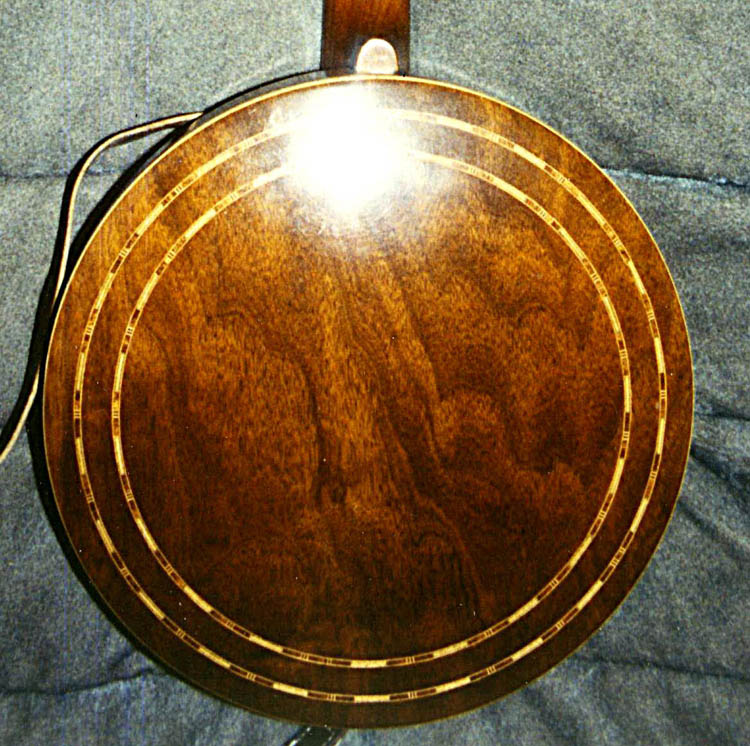
This is a resonator that Frank Schoepf has that was under style
11 pearloid. He could see walnut where paint was worn off the
sidewall, so he investigated. He never could see any defect in it. It
had a number 9554 in paint - no chalk on the resonator and Frank built an RB-4 around it:
Web page updated by Bill aka Mickey Porter on
09-20-2022.
SASQUASH RESONATOR UNDERNEATH STYLE
11
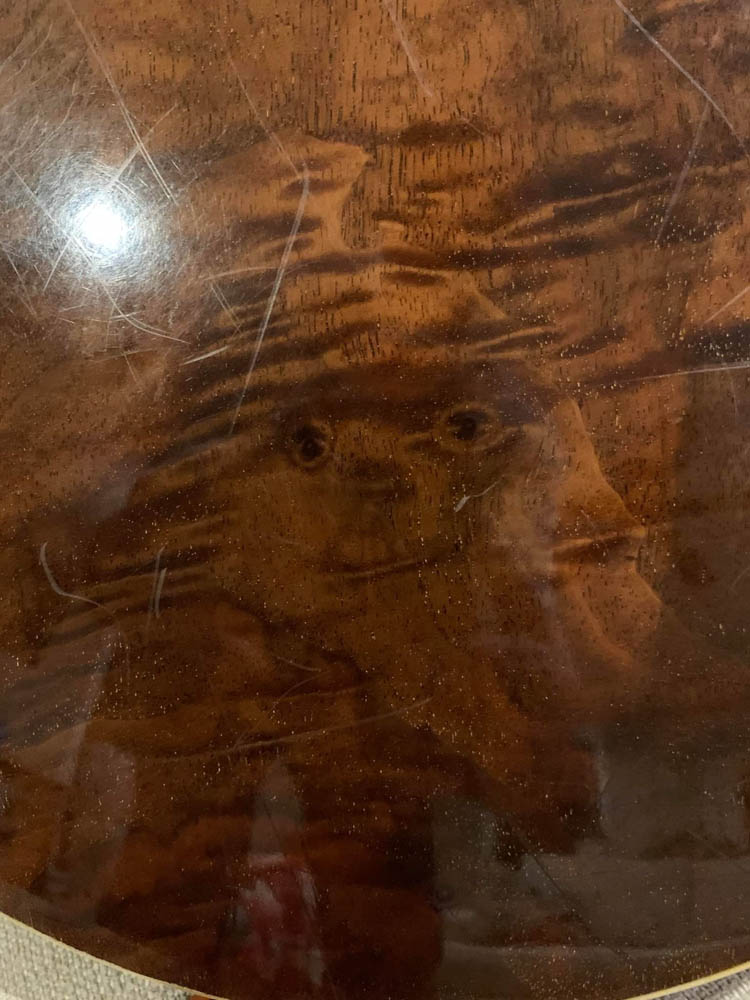
Above is a pix of a resonator that was skinned from a
ruined TB-11 by my friend and Brother in Christ, Jim Yarboro of Gun Barrel
City, Texas many years ago that revealed an unusual figured walnut pattern
Jim named Sasquash. Jim
stated it took him several days to get all the glue off the resonator back
that was underneath the silk screened pearloid. This resonator was
installed on a TB2 conversion.
Web page updated by Bill aka Mickey Porter on
09-21-2022.
WOOD RIM SPLICING
Below are a few pixs taken by Ken LeVan of Shunk, PA of
a 1927 Granada Hearts & Flowers two-piece flange tenor 40 hole raised
head FON
8769-20 that he purchased about 45 years ago that shows one of the anomalies
mentioned above. The wood rim was cut down at the factory and had
another piece added to the top of the wood rim of which we think they used a
ball bearing wood rim and simply cut off 5/8 of an inch off the top and glued part
of another wood rim to hide the holes drilled in the top of the wood rim
that contained
the washers and springs....a "guesstimate" at the best since the label was
added over the splice after going through their finish room. Many
examples of this spliced rim alteration for the two piece flange have shown
up over the decades since their manufacture and alteration by Gibson:
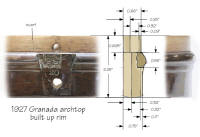
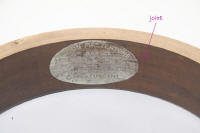
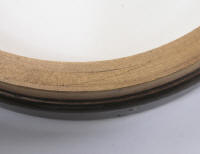
Below exploded view of the banjo pot assembly:
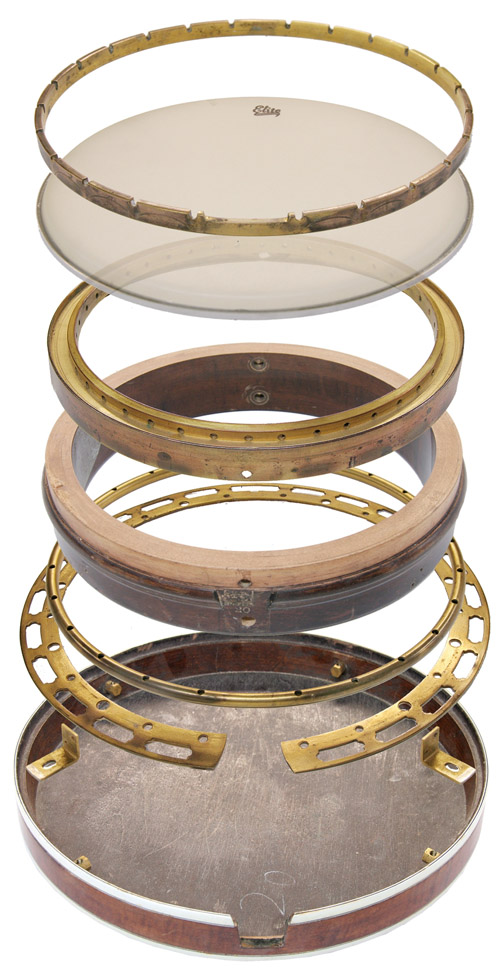
Photos courtesy
Ken LeVan, Shunk, PA. Ken is a top of the line craftsman and
artist!
Below is a pix of another spliced wood rim from the
same FON (Factory Order Number) 8769-16 that has the Mastertone decal
installed over the top of the splice and done at the factory no doubt using
up rims that were previously fitted for the ball bearing tone ring and
retrofitted for the raised head tone ring. A few other banjos with spliced
rims also. Check this link out for
additional
pixs:
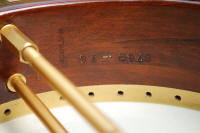
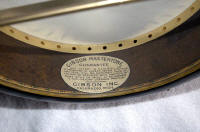
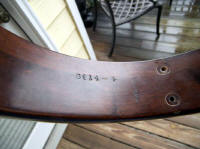
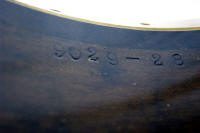
Visit:
www.earnestbanjo.com for additional information and pictures on the above
instruments.
Back in the early 1970s, I missed the opportunity to
purchase at least one pre-war flat head high profile Mastertone banjo that started out at
the factory as a raised head and Gibson cut the wood rim down and installed a
flat head tone ring with the cut decal in place, whereas I surmised it was a
post-war conversion, but years later proved to be a factory pre-war conversion. Back then without decades of experience identifying the
"quirks" of pre-war flat head tone rings, I didn't want to
gamble on purchasing a conversion, whereas I certainly didn't trust the
banjo trader offering the instrument for sale and that was probably my main
concern. I would not trust that banjo trader in
an out house with a muzzle on! I think many of us can look back and see numerous mistakes we
have made instrument trading, etc.!
Bronzes from "Henley's Twentieth Century
Formulas, Recipes And Processes" circa 1916.
"The composition of bronze must be effected immediately
before the casting, for bronze cannot be kept in store ready prepared.
In forming the alloy, the refractory compound, copper, is first melted
separately, the other metals, tin, zinc, etc., previously heated, being then
added; the whole is then stirred and the casting carried out without loss of
time. The process of forming the alloy must be effected quickly, so
that there may be no loss of zinc, tin, or lead through oxidation, and also
no interruption to the flow of metal, as metal added after an interval of
time will not combine perfectly with the metal already poured in. It
is important, therefore, to ascertain the specific weights of the metals,
for the heavier metal will naturally tend to sink to the bottom and the
lighter to collect at the top. Only in this way, and by vigorous
stirring, can the complete blending of the two metals be secured. In
adding the zinc, great care must be taken that the latter sinks at once to
the level of the copper, otherwise a considerable portion will be
volatilized before reaching the copper. When the castings are made,
they must be cooled as quickly as possible, for the components of bronze
have a tendency to form separate alloys of various composition, thus
producing the so-called tin spots. This is much more likely to occur
with a slow than with a sudden cooling of the mass."
The above reference certainly shows the difficulty of pouring bronze alloys
in the Gibson Mastertone era and gives some insight why there are so many
different variations in the analysis reports of Gibson pre-war tone rings
from the same original alloy mixture!
I will put
my money on a good three-ply wood rim especially Gibson pre-war, one
without any voids covered up at the factory by splicing a filler strip
between bad glue joints or a current well made one piece
layered old growth hard northern maple ( Acer saccharum) KENNEDY "jellyroll"
style wood rim
versus an
original pre-war tone ring any day of the week as far as sound production
(volume and timbre) goes!
A good wood rim is the heart beat of the banjo. All things have
to be made and fitted correctly, but again the wood rim is the key component when
comparing banjos to banjos. If I were in the business of selling a
special one of a kind tone ring, then there might be a different sales pitch,
but I am not in the business of selling neither tone rings or wood rims and
can afford to be objective, unbiased and conclusions made backed up by
experimentation with enough scientific evidence to prove my point.
Reproduction Gibson style 3-ply maple wood rims made back in the
1970's through the 1990's along with current ones, whereas many of
them after 10 years (and some within a few weeks) have shown a slight separation of the plys either by the
wood shrinking or the glue line shrinking. Some of the early
Mastertone 3-ply wood rims show the same thing, however most and the better
sounding banjo's wood rims are very tight and not able to detect any
separation of the laminations either by sight or feel. Gibson
gave a boost to their pre-war wood rims with the installation wedge shaped
wood filler strips glued in place
between separated plys for cosmetic reasons when fitting the tone ring and
flange and certainly helped the 3-ply wood rim integrity for tone
enhancement/propagation if the plys did not have
excessive void places
between the laminations. Many outstanding Gibson pre-war 3-ply wood
rims were also installed in their contract non Mastertone brand banjos they
produced during the Great Depression more out of a necessity.
There is a noticeable difference between the
craftsmanship of the Gibson three ply wood rims prior to 1930 and most of
the two piece flange wood rims were far superior in the plys fitting
together with more precision requiring fewer "filler strips" to hide a bad
glue joint! Many of the pre-war wood rims for the two-piece flange had
a center ply thickness approximately .312 plus or minus inches and many observers get
confused by the installation of the filler strips thinking they are looking
at a five (5) ply wood rim.
The two piece flange banjo wood
rim consisted of four (4) laminations, whereas the outside lamination aka
tenon was
glued into a mortise groove. The end of that lamination did not have a
scarf joint with that area hidden behind the neck heel. Several
paragraphs down, there are pictures and a drawing of the construction of
this wood rim.
Note: All three ply
thicknesses normally started out
the same thickness (.312), but turning the outside diameter and the inside diameter
to allow for the finished OD and ID reduced their thickness. It appears that Gibson did some type
of "visual" grading of their wood
rims aka "shells" since their higher grade of instruments have the better
fitting wood rim plys and many of what I would classify as seconds have
appeared in the factory floor sweep banjos, non-Mastertone brand banjos they
produced during the 1930s and early post-war banjos using what they had on
hand. However, there have been many flawless wood rims on
the non-Mastertone banjos they sold to various companies like Montgomery
Ward, etc. and those banjos have made outstanding conversions.
Gibson
style 11 banjos have rendered some of the
best sounding conversions to my ears and I attribute it mostly to the wood
rim!
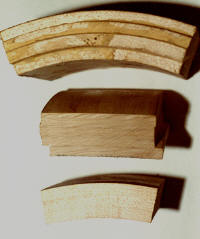 1974 R & D Jellyroll wood rim using Dave Kennedy's prototype
wood rim machine.
1974 R & D Jellyroll wood rim using Dave Kennedy's prototype
wood rim machine.
Take a close look at the above pix of
the glue line of the "jellyroll" wood rim that
I personally made using Dave Kennedy's prototype wood rim machine and dissected
manifests what a glue line or the lack of a glue line should look like.
No voids in a wood rim laminations equals a superior sounding banjo with all
other things being correct. The jellyroll wood rim makes
more engineering sense to me for absolute flawless glue lines with
less things that can get out of tolerance such as; wood thickness,
wood lamination length, taper angle length, grain structure from different wood
billets/fletches, etc., but now we
get back to the Holy Grail Syndrome because Gibson did not invent and
use the process even though one of their former pre-war employees George Hall
conceived the idea many decades before Dave aka Davis Kennedy built his
prototype wood rim machine or at least that is what George Hall related to
me. There is no question that Dave aka Davis Kennedy built the first
jellyroll wood rim building machine and at least two other instrument makers
has followed Kennedy's lead in this area! It is to my understanding
that Davis Kennedy supplied Gibson with his jellyroll wood rims (at least 60
units) initially, but he could not supply their demand and one other individual copied Dave's
jellyroll wood rim construction and attempted the same thing (supplying
Gibson) with wood rims.
As far as which is better,
"six of one and half a dozen of another"
so form your own conclusion! I would personally opt for a jellyroll
wood rim if it were made without any voids in the laminations. Those
that down grade the jellyroll wood rim construction have probably never made
one because of its difficulty to manufacture, therefore can only propagate
an opinion; in other words
blow hot air!
If I ever make another wood rim
for a banjo, it will be the horizontal orientated grain finger jointed block rim or have
Ken LeVan of Shunk, PA make me one of his.
I have not seen another
"jellyroll" wood rim manufactured that would equal the ones
produced on Dave Kennedy's prototype wood rim machine with such a flawless
lamination glue line/fit. Very few Gibson pre-war wood rims (post
1930s) would come
close, especially at the scarf aka lap glue joint!
There is
no magic to steam bending wood and contrary to
what many believe, "steam does not add
moisture to the wood; it actually dries it out". Steam
uses molecular water present in the wood to transfer heat. Those that
attempted to manufacture the one piece continuous length "jellyroll" wood rim after Dave
Kennedy's invention simply did not fully understand that without heating and
pressing the 1/4 inch thick steamed piece of wood (10 feet or more in
length) against a forming wheel, the steamed wood would cool down too
quickly to effectively get a 100% glue line without voids between the
laminations. Dave Kennedy's wood rim machine: 1) Steamed the wood,
2)
Bent the steamed wood around a forming wheel, 3) Dried the lamination and
4)
Glued the laminations in one process with the prototype machine requiring at
least two people since the forming wheel was gear driven with a hand crank.
I am thinking that it took five (5) minutes for the forming wheel to make
one complete revolution due to the gear ratio of the hand driven gear box.
Pix below of Dave Kennedy's jellyroll wood rim machine in operation:
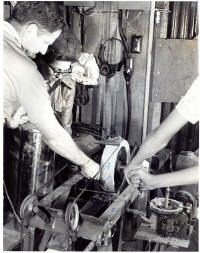
Two well known "copy cats",
one in California (retired now) and one in Kentucky (deceased now) attempted to make the jellyroll wood
rim with limited success by steaming the entire piece of wood in a steam
chamber, but it cooled down too quickly while rolling it around a mandrel to
effect a near perfect glue joint. Davis Kennedy is the
originator of
the jellyroll wood rim, all others are mere copy cats! If you are using
someone else's design, you are a copy cat no mater what you are making!
Below are pixs taken by Luthier Chris Cioffi of
Springfield, Tennessee; telephone 615-382-1376 showing how Gibson
made their pre-war wood rims for the tube and plate flange and an excellent
drawing by Chris of how they mortised a piece of maple into the outer
lamination to get the extra diameter needed to capture the radius portion of
the tube. The tube and plate flange wood rim is one of the strongest
wood rim systems made, but was and still is very labor intensive and replaced with the
introduction of the one piece flange (OPF).
Check Chris Cioffi Banjo Services out at:
Banjo Hangout:
Chris has the expertise and qualifications to do banjo repairs/construction
needed!
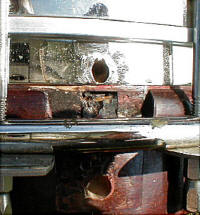
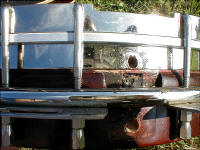
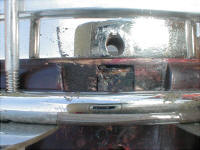
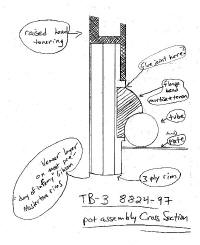
You have to look very close at most of the Gibson pre-war tube and plate
flange wood rims to notice the glue line of the mortised in strip of wood
(tenon). Gibson did not waste labor by tapering the ends of the
tenon as evidenced by the gap which was covered by the heel of the banjo
neck. Jimmy Cox at Cox Banjos,
Topsham, Maine 207-725-4677, in my humble
opinion is one of the best post war three ply wood rim makers today,
including the mortise and tendon wood rim for the tube and plate flange.
Jimmy does use the scarf joint for the outside lamination for the tube and
plate flange.
Some argue that three separate laminations make a
better rim because of the different grain structure, but enlarge the pixels
in the lower pix above of the jellyroll wood rim and observe a noticeable
contrast between the grain structure of the wood layers even though the
single piece of wood is from the same fletch or billet! It appears
that three separate pieces of wood were used to create the jellyroll wood
rim, whereas one single length of Northern hard maple was used.
Wood density, grain structure pattern variance along with cell
crystallization within a single piece of wood is a
somewhat shielded mystery as to the relationship between it's final effect
on timbre or tone and the ability to propagate sound waves! I do not have a conclusive scientific answer as to
the cellulose crystalline structure in a developing wood cell wall and what
takes place within the cell wall after the wood has been harvested, kiln and/or air dried,
steam/heat bent, etc., but I know what works most of the time!
Wood rim advertising is now taking on the same
hype (that is the clean or
politically correct word usage) as are tone ring manufacturers and just
maybe the Holy Grail Wood Rim will be revealed from
eight (8) decades of obscurity!
Hard Rock maple was a
colloquial term used and derived from
different types of Maple trees, the rock maple tree and the hard maple tree
and came about in the 1960s advertising when the Colonial American style of furniture
was in demand again. Hard maple (Acer saccharum)
is heavy, strong, hard, tough, stiff, close grained and shows mineral lines
and grey streaking in the heart wood with over 200 species and shrubs
worldwide and divided into two groups: hard and soft.
Sugar maple (or
rock maple: acer saccharum) is the most common hard maple. Silver, Red
Maple and Box Elder are more common soft maple species and grow across North
American and are less dense.
Also, I have no evidence that animal hide
glue is superior to our modern glues as far as giving that magical timbre
to an instrument, however many mandolin and
fiddle makers tend to disagree! Hide glues are definitely not as strong as
the original Titebond (aliphatic resin) glue that I have used since the late 1960s and my own tests
have the wood pulling apart before the glue line shears. There are
places where animal hide glues are called for such as violin tops, etc.
where a part at some point in time might need to be removed, but
I sold my electric glue pot decades ago and have no desire to purchase
another one either! If you witness wood separation at a glue line,
doesn't that give you a clue something is wrong? The majority of wood
rim separation of the plys normally are: ply lengths too long, faulty glue, absence of glue to begin
with, improper clamp pressure and application time or too much moisture content in the wood when the glue was originally
applied and several other factors more difficult to ascertain.
If everyone thought "inside the box" as
some of our traditionalists, we would still be using long bows as implements
of war instead of our laser and GPS guided smart bombs! I know this is a two edged sword
statement, but someone has to say it again and the parallel can be made to
musical instruments as well. I myself am guilty of using the ole
cliché, "If it ain't broke, don't fix it" and there are many
applications to use such a statement, but hide glue is not one of them.
If
I had to put a percentage on the relationship of the
importance of the wood rim versus the tone ring, I
would go at least 75 percent in favor of the wood rim
and this is a very conservative conclusion. Even a pre-war high
profile flat head tone ring
on a poor wood rim will yield poor results, but an excellent well made
maple 3-ply or jellyroll wood rim will
yield good to excellent results with about any modern Gibson style reproduction
high profile well fitted tone ring! If there were no merit to my assessment of the pre-war wood
rims on lesser model Gibson banjos without a tone ring, why are they so
expensive today and in such great demand just for the pre-war 3-ply wood rim
and/or resonator in order to covert to a Mastertone? Most will render
a timbre or tone that is normally not found using current manufactured
reproduction 3-ply wood rims and the wood rim is the foundation or building
block of the banjo...... that is why! This is an example of the aging
of the wood rim after assembly/construction for over 80 years. Just
purchasing old wood that has been dormant for many decades and centuries
cannot be equally compared to the finished product that time and mother
nature has done it's "magic" to enhance the timbre. That's my story and I am
sticking to it!
Anyone desiring to learn about quantitative analysis
for the cellulose la crystalline phase in developing wood cell walls by ,Yutaka
Kataoka and Tetsuo Kondo, there
are articles available that get into scientific detail, but will cost you
about $ 38.00 per article. Go to
www.sciencedirect.com
An original pre-war flat head tone ring will sound
different when installed on different pre-war wood rims, current made 3-ply
maple wood rims; whether Timeless Timber, Factory Floor, Cox,
Cooperman, Yates, Huber, LeVan, Kennedy jellyroll style or any
combination between....I certainly don't have a definitive or
absolute answer as to why!
I formulate a pc analogy as: "The
wood rim being the "motherboard" which
controls all the pherpherphical components such as the tone ring, neck,
strings, head, tension hoop, bridge, tailpiece, hook & nuts, resonator, etc.
to produce the volume, sustain and timbre one desires!" Bill
aka Mickey Porter
Check out my
finishing page
for further information concerning the wood rim.
Wood (trees) at one time was a living thing and I guess
you can make the analogy to human DNA, no two are identical! The
photosynthesis process we associate with the leaves, soil nutrients, climate
variations, temperature, annual growth, all contribute to this
mystery (timbre)!
 Plant
cell drawing from the internet.
Plant
cell drawing from the internet.
Read further down this page under the paragraph titled,
"My attempt to explain timbre" concerning old wood.
Jasper Wood Products
in the 1970s supplied Gibson with multiple ply laminated banjo wood rims of
which rendered some of the most horrible sounding out of the box Gibson
Mastertone banjos ever made! The Jasper wood rims were seemingly more
glue and lacquer than wood and the tone ring I.D. hung over the edge of the
wood rim which was about one lamination shy of 9.5 inches I.D. This
wood rim was prone to pull apart at the lip area that contained the tube of
the two piece flange. I had one of their stock Jasper wood rims
in an early CE Ward Masterclone (one piece flange) before using the Kennedy machine produced jellyroll
wood rim and would not do that again. The banjo was made by CE Ward
using post war Gibson parts and had a walnut wood rim in it that was turned
from a solid piece of wood by Bill Simpson and later cracked badly. I
sold the banjo with the Jasper Wood Products wood rim in it to Paul Sasser,
deceased of Pleasant Garden, NC and he said "that was the
worst sounding
banjo he ever purchased."
A few builders of of late have come around to this way of thinking
that do not have the incurable "Granada Holy Grail Syndrome"
permanently embedded in their brain altering the process of the cerebral
cortex. Many talented banjo pickers are unable to distinguish the
difference between certain pre-war flat head banjos played versus some
excellent post-war banjos in a blind hearing test which manifests a whole
arena of self biases, prejudices with predetermined invalid preconceptions.
However, there is a difference in hearing a banjo's tone versus hearing and
feeling the banjo's tone when YOU
are playing the same banjo! That last sentence I know is
paradoxical, but that is the difference in my humble opinion. If an
instrument is able to deliver the tone you are looking for, regardless of
the name on the peghead, you will want to play it non-stop and you will
certainly become a much better musician in the long run!
Gibson prewar Northern hard maple three ply wood rim
construction is by no means the only way to build a wood rim that will yield
outstanding timbre with all things being equally compared. There are
excellent wood rims made today by various craftsmen using different styles,
wood species and methods of wood rim construction such as horizontal finger
jointed multi-sectional wood rims using red maple. Each of us
has our own prejudices as to what we like and what we have the equipment and
capability to fabricate...the sky is the limit! Check out
Ken LeVan who can
think outside the box and an excellent craftsman.
I personally know that some of the pre-war
flat head banjos that I had the opportunity to play has something in their
complex tone that you are able to hear
and most importantly vibrational feel that
the majority of post war
banjos including Gibson do not possess. It might not be a tremendous amount
of difference and
I do not
have any conclusive scientific data as to why they do. I don't think
you can immediately duplicate 80 plus years of an instrument that has
constantly gone through different phases of seasonal changing humidity,
barometric pressure, internal stresses and movement of the molecular
structure of individual components brought about by these changes and of
course the actual playing of the instrument. A few modern banjo
companies of late copying pre-war Gibson like Huber, Yates, Sullivan and
Frank Neat are
very close to that sound and feel, but not quite there yet. I would not hesitate to own one
of their latest banjos if I didn't have the ability to build one of my own, but they are
mere
"copy cats" IMHO without
any originality whatsoever! I certainly would
not mortgage our home to purchase a mint condition
1930s Gibson Mastertone flat head banjo just for the sake of owning one or as an
investment either.
The 1950s thru the 1960s were the era to get a deal
on a Gibson pre-war flat head. Prewar Gibson flat heads were purchased by
many skillful and cunning banjo traders
routinely for 75 to 150 dollars from their original owners and/or their
children/relatives who apparently
had
no idea what their current value or worth was and were
quickly sold for 1500 to 2000 dollars due to their high demand; a very huge and tremendous
mark-up and profit at the time or today as well. There is a
morality issue
in this type of transaction for me personally, but many will do whatever it
takes to make money or for self-gratification in whatever form is necessary. If you have the means to own one of those pre-war
Stallions at their current inflated price, go for it; it's your money!
You probably want sound a bit better to the listener than picking one of the
Huber, Yates or Sullivan banjos IMHO, however you will certainly sound
better to yourself. It is just the
nature of the beast! I have heard other pre-war
non-Gibson banjos that possessed beautiful tone and volume as well, but one
cannot have the incurable "Granada Holy Grail or
the RB75 Syndrome" either! Ask yourself this
question: What generates the most
complex tone from any banjo? Hold your
two hands up! Bingo!
Personally, the
pre-war Gibson Mastertone flat head banjo style of construction (as a whole) are still the best
5-string banjos ever made for Bluegrass style picking!
Any banjo
manufactured today using the above style is still a copy or clone,
regardless of what name is on the peghead. The same goes for a guitar,
mandolin or any other product.
Jim Selman (deceased, 11-14-13) of Akron, Ohio had been
"preaching" the
importance of the wood rim for many decades and had a positive influence on
Bill Sullivan (deceased) of First Quality Music to produce the "Old Growth
Wood Rim." Jim Selman has purchased and/or traded more pre-war
flat head and raised head banjos including the Granada than
probably any person in the USA. Both
Jim and myself have seen some cheaper models of Gibson banjos pre-war and
post-war banjos; e.g., RB11 with a pre-war original wood rim and just a 1/4 inch brass
rod/tone ring that would knock the socks off most any post-war Mastertone
banjo! I expect Jim Selman purchased about as many complete inlaid
peghead and fingerboards from myself than any other individual and/or shop
during my own "music hay day." Jim Selman has also sold
Earl Scruggs many original banjos over the years! I am not talking
about Jim Faulkner (deceased), that is another story.
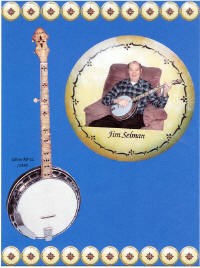
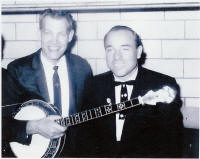
Above pix of
Jim Selman and the pix on the right is Jim
Selman and Earl Scruggs 1959.
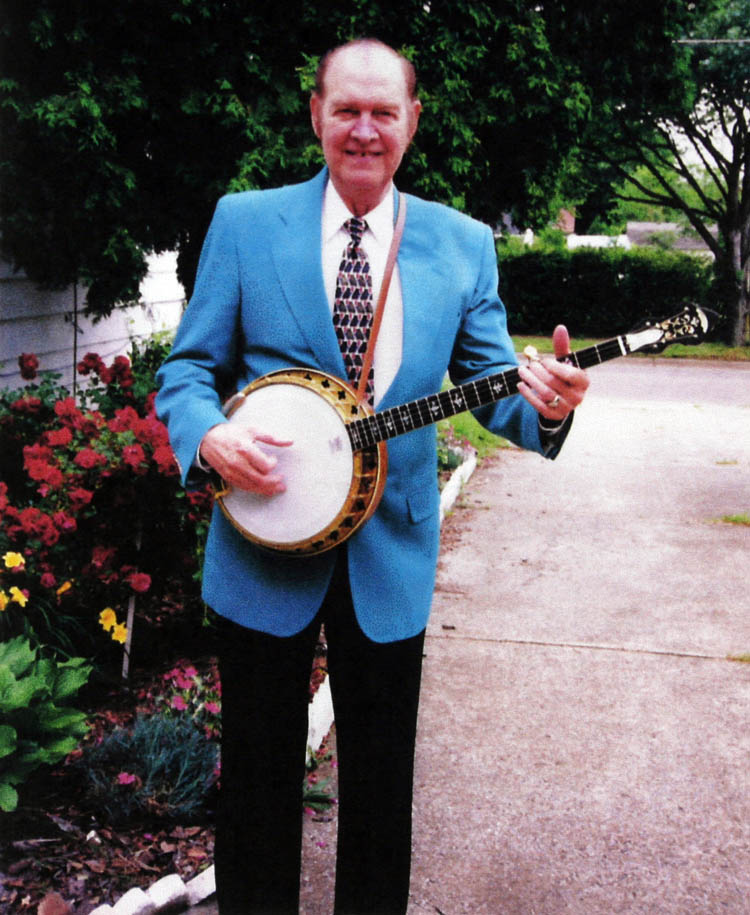
Jim was a sharp dresser too!
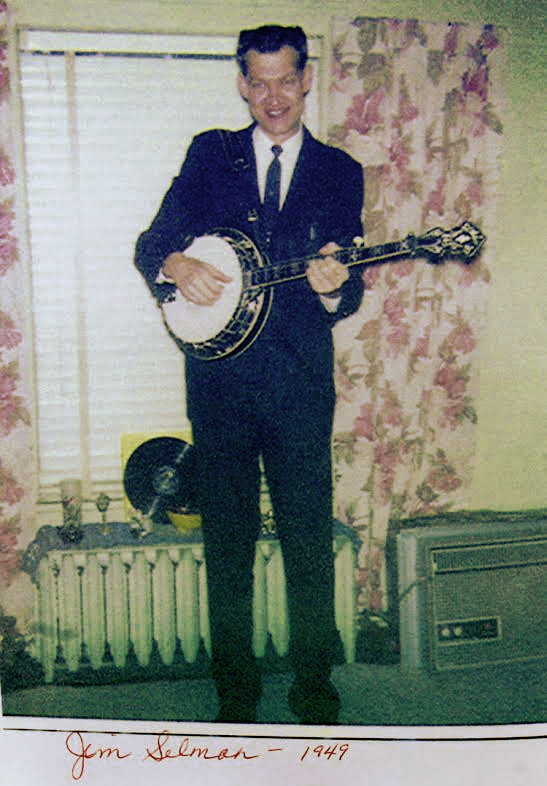
While going through a planer manual, I found a few pixs
that Jim sent several years back, probably around 2010 and decided to post
them. They were scans of pictures on regular copy paper, therefore,
the quality is lacking, especially on the 1949 photograph. Jim was
certainly one tall man! He worked for the
Cleveland - River Terminal
Railroad Co.
Web published update by Bill aka Mickey Porter on
04-05-17.
ADDITIONAL WOOD
RIM INFO, ETC.
Many of Gibson's original prewar three ply wood rims
that were left over at the factory after they ceased production of the Top
Tension models 7, 12 & 18 Mastertone banjos and RB75's has turned up in early post war Gibson banjos like the
early RB100 and RB150 and have made some outstanding flat head conversion banjos.
The aging and drying out of a wood rim after it
has been steam and/or heat bent to shape and also after the gluing operation
is a key missing element in today's production and short run production
banjos! Some of those wood rims were the full 3/4 inch thickness at the 1/4 inch
diameter brass tone ring portion for the arch top which had the 1/4 inch
diameter (rod) tone ring positioned toward the inner side of the wood rim to
mimic the raised head tone ring. Gibson kept about a year's supply of
wood rim components already bent to shape and in various stages of
completion in a very large heated drying room according to George Hall who
worked there from 1927 thru 1933. Their method of wood rim construction
was very crude by today's technology. but very effective back then when labor
was cheap and plentiful.
Early
recordings of Gibson Mastertone banjos (Fisher Hendley with his 1937 RB Granada
flat head Flying Eagle inlay pattern, shipped June 23, 1937 FON 9526-13) without
the benefit of high tech studio enhancements in the 1930's thru the 1940's
proves many of their banjos "right out of the box" had what it
takes without the benefit of time as myself and others elude to instrument
age as one of those missing magical components and is somewhat paradoxical!
Banjo later recorded by
Buddy Rose and now owned by Gordon Reid.
There is a excellent write up in
The Old-time Herald Magazine
volume 10, number 6 Aug-Sep 2006 issue with a good history of early North
Carolina musical groups including Fisher Hendley and other local Anson
County musicians, etc. Back issues are available for sale.
There is a picture of Fisher Henley with a ball bearing 5 string banjo
Hearts and Flowers with the Mastertone inlaid in the peghead and the picture
is circa 1930 of which Fisher Henley was 100 percent Gibson all the way as
evidenced by a letter in said magazine from Gibson.
I
gave away and hauled to the land fill about 55 gallons of research data with
a large amount of original Gibson factory data collected from George Hall,
Davis Kennedy and others that worked at the Gibson factory, prewar and
postwar, but hindsight always seem to be 20/20 for sure......go ahead and grin
on that statement. So much for needing more valuable file cabinet
space!
Check this
link
out!
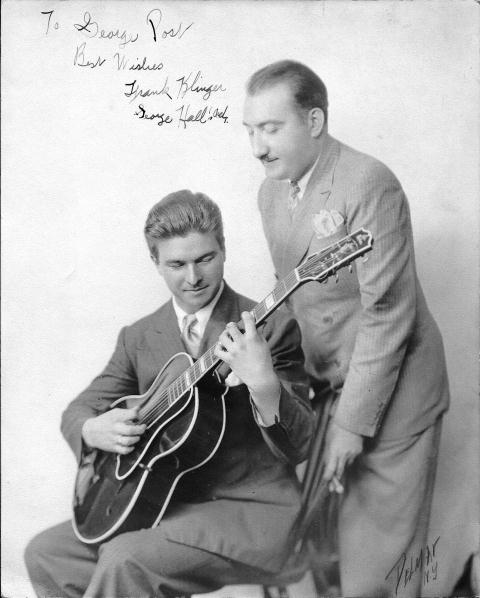
Photo courtesy of
Joe Spann, Research Library Director and
professional genealogist.
Above picture of George Hall (standing) and Frank Klinger playing the guitar
that I received from Joe Spann on 11-16-11 via email and very much
appreciated. Joe stated that Frank Klinger was a Gibson Salesman and
also played in a band with George Hall. George has a pin stripe suit
on, flower and a stogie in his left hand.
I give a tremendous amount of credit to Mr.
George
E. Hall (deceased) of Kalamazoo, Michigan who worked for the Gibson
Musical Instrument Company from August 5, 1927 through out 1933 and possessed a huge amount
of knowledge of every aspect of the Gibson Mastertone Banjo construction and
"picked his brain" many, many times via telephone and letters for
manufacturing details. I did have some of his hand drawn
sketches of
Gibson's Pre-War banjo wood rim bending machine and he was the first
person to detail a banjo wood rim made like a "jelly roll"
; e.g., one
continuous 10 ft. plus piece of 1/4 inch x 3 inch hard maple wood steam bent
and rolled onto a 9.4 inch diameter (elliptical) shaped steel wheel, dried and glued at the
same time consisting of four complete revolutions or more depending on the
wood length, with each end feather
tapering to make a complete round part after a lathe turning operation.
George stated that Gibson were just finishing up using the ball bearing tone
rings and were getting the arch top tone ring castings in when he started
to work for them.
I misquoted
the foundry source of those pre-war
tone ring casting on the Banjo Hangout as Riverside Foundry and Galvanizing,
whereas that was a post war
foundry source that Gibson used then, when I was talking with George Hall
back in the 1970s and scribbled some notes, whereas George was referring to
one of Gibson's current foundry vendors. I stand corrected on that one and my bad! George took an original factory pre-war tone ring
(arch top) while he was working there and made a modified flat head tone ring
out of it, (if my memory is correct).
George told me the factory allowed new employees to build an instrument of
their choice when they went to work for them as part of their on the job
training. I don't know what happened to his one of a kind banjo he
built, but he said it would go to the grave with him if he didn't get the
price he was asking for it; 50K in 1975. That banjo had an awesome tone and volume.
Dave Kennedy observed one of the flat head tone rings that George Hall had
modified and he described it as having saw cuts on the inner portion of the
ring that contacts the top flat portion of the wood rim and the cuts were
done with a hack saw with the spacing matching the flange tone holes.
Dave stated that he was not impressed with the modification. I lost contact with his daughter-in-law over the years and never asked about
George's banjo. Many of the Gibson employees named by George Hall
during our many hours of conversation over a (Watts telephone line) that did specific production tasks have faded from my memory since I took
only sparse notes back then. I remember him talking about a Swedish
man that did some of the custom in house inlays, but cannot remember his
name either. One has to be familiar with a production
environment to be able to fit the pieces of the Gibson Mastertone banjo mystique
together with some
degree of accuracy and clarity! Many of Gibson's
"floor sweep" banjos sold in the late 1930s
thru the 1940's were actually put together from components made during
The Great Depression Era and a banjo date of sale on an invoice does not provide an
accurate infallible cross reference to the (FON) factory order number/bin
number as to the actual
date the banjo was manufactured. Original pre-war Mastertone banjos
left the factory with mismatched individual components such as resonators,
necks and wood rims due to the depression and the need to complete a custom
order and Gibson themselves altered some of the original factory order
numbers and bin lot numbers
to effect the order.
Gibson had a tremendous distribution network (dealers)
nationwide and one must conclude that a company of that size would have to
stock a sizeable inventory of their catalogued instruments due to the amount
of time it takes to manufacture a banjo from start to finish.
Instruments sold in the mid 1930's certainly reflect they were made much
earlier and besides, "You can't sell what you don't
have in inventory" and those were hard times!
According to George Hall, individuals were assigned
production duties such as turning of tone rings, resonators, wood rims,
cutting wood rim pieces to length, bending wood rim components, gluing the
wood rims, bending resonator side walls, gluing operations of all types,
neck blank operations, gluing mother of pearl onto backer boards, scribing
patterns onto inlay material, cutting the mother of pearl designs, cutting fingerboard and pegheads in prep for the inlays, inlaying the
pre-cut inlays, binding resonators, slotting fingerboards, fretting
fingerboards after inlays prior to gluing onto neck blanks, staining and
lacquer, etc., and
assemblers/fitters of the final components by bin number. One has to imagine the
tremendous amount of instruments possible and warehoused from a production
environment and inventory ready to be sold. George Hall stated the FON
(factory order numbers) aka serial numbers of the banjos whereas they were
built (housed in roll able storage bins in lots of 40 units, however there are many bin numbers on
FON's that go beyond
40, some with much less bin numbers and missing FON's and out of sequence and
"the more information revealed, the more questions arise!"
At
some point in production, you will reach a point or level called,
diminishing
returns and 40 units could have been Gibson's
normal point of
diminishing returns! Just a "guesstimate."
NOTE: The
information that George Hall related to me concerning his employment with Gibson;
I can
only
relate what was told to me by George Hall himself since he worked there and
he was certainly in a position of knowledge and responsibility being an
Experimental Manager in 1931. I scanned some
notes
I made on 11-30-75 while talking with George Hall about the Gibson tone
rings and called Riverside Foundry on 12-01-75 and talked with Mr. R. G.
Diephuis, Sales Manager and he said their records did not go back that far
to 1927. My interest and intent was to get Riverside to manufacture
tone rings for me in 1974 if they were not locked into a current contract
with Gibson of which I don't think they were. My
goal was to ascertain the tone ring composition/alloys in Gibson's pre-war tone rings
and I accomplished that goal with the majority of the tone rings being
the tin bronze alloy. Most
of the documents and drawings I received from George Hall have long since
been thrown out and could only find the
letter dated June 4, 1973, and one
dated May 6, 1976, whereas
he was still somewhat loyal to Gibson after all those years and would not
hand address the outside of the envelope on one of them for whatever reason I can 't
remember. George still had a good relationship with Gibson after his
1933 employment and was up to date on a lot of their current jobbers that supplied
parts to them in the late 1960s thru the mid 1970s. I followed up on
several of those sources which were accurate at that time. It is
to my understanding that George continued to tinker with building banjos and
scrounged old parts from his contacts at the factory and who knows what type
of "Holy Grail" parts are in some of
those banjos he put together for his students! It is factual that
Gibson swapped out original prewar Mastertone parts during the post war years when repairing instruments due to
their current production parts not conforming to the pre-war parts
specifications; especially gold plated and engraved items and Gibson and/or
their employees kept many of
them. Back then, parts were just parts!
George Hall was granted US Patent 2,188,602 on January 30,
1940 for a collapsible music stand hyperlinked here:
United States Patent: 2188602
Click on images for a full view.
I never met George Hall face to face,
but due to the hours spent on the telephone talking with him and letters, I
certainly do feel as if I knew him personally!
ADDITIONAL INFORMATION ABOUT GEORGE
HALL
Joe Spann, Research Library Director and professional
genealogist, provided additional information concerning the date of George
Hall's employment with Gibson of which I updated and in 1930 his title at
Gibson was simply "Musician" and in 1931 he is described as an
"Experimental
Manager." In the final year of his employment at Gibson (1933) he is
described as an "Inspector." By 1936 he was in business as a locksmith
and was running a small locksmith shop in Kalamazoo. His October 9, 1978 obituary
describes him simply as a "Professional Musician" at Corsiglia's restaurant
in Portage, Michigan. It also mentions his great love of horses.
George had only one son Roger Hall who died in 2000 thus ending Joe Spann's search.
Joe Spann provided this information via an email on 09-25-09 and is very much appreciated!
I had one picture of George Hall standing beside one of
his horses of which I could not locate. I was very fortunate to have
known George Hall only via telephone conversations and letters and one of the few
individuals today that had actual contact with a pre-war Gibson employee that
worked there at the Kalamazoo Gibson Factory from 1927 thru 1933 when Gibson manufactured some of their best
Mastertone banjos. In my humble opinion, this was Gibson's musical
instrument renaissance period that has not been equaled since. Therefore, I certainly feel the information I
received from George Hall is Reliable and
Credible.
I have a hyperlink to a
document scan
from Riverside Foundry and Galvanizing Co. dated 09-26-74 for a quotation
for 100 tone rings lot (high profile flat head) cast from
QQ-B-701a Grade 6X tin
bronze, similar to commonly called trolley brass, however I never did
order the tone rings from Riverside Foundry and Galvanizing Co. I found out
about the trolley brass or tin bronze years before I had MacMillan Research
do the spectrographic analysis of the samples I sent them as evidenced by
the Riverside Foundry and Galvanizing Co., quotation for the QQ-B-701a Grade
6X alloy and also had a copy of the analysis report that Gibson did on the
1929 TB3 arch top tone ring. So much for "trade secrets"! I guess the
ole saying, "Loose lips sink Battleships" holds some merit after all!
Grin now! I was not convinced about Gibson using one alloy for their
tone rings since there was such a difference between pre-war banjos that
were set up properly. Some were run of the mill banjos and others were
great and that is what sparked my interest in having several tone rings
tested. My money is still on the old 3-ply wood rims, especially those
that did not need filler strips to hide the bad open glue joints!
I used the firm MacMillan Research, Ltd. located
in Marietta, Georgia to do the spectrographic analysis of the samples
submitted and they were signed by J.E. Mac Millan, Ph.D. Chemist and trust
the accuracy of the reports. I remember them using some high tech
equipment they purchased used from NASA.
I certainly enjoyed doing the
research about the Gibson pre-war tone rings and I am sure I only scratched
the surface so to speak and definitely not an expert at anything, whereas
others have continued the quest for the Holy Grail banjo sound and
have made great progress to supply some outstanding tone rings as close as
possible to the original alloys as can be made today along with great 3-ply wood
rims and resonators.
The only element missing is the natural aging
process (crystallization) of the components after the part is fabricated and the limited supply of Northern old growth
hard maple wood for the 3-ply wood rims which time will tell how successful "we" have
been! How long does it take to age an instrument in....that is
very subjective, but an instrument made right from the start
doesn't take that long! Instruments that I have personally made, after
10 years there has been a noticeable difference in the timbre of the
instrument with the biggest element being the reduction of out of phase overtones and a
deeper and more mellower tone/timbre and an increase in instrument volume.
Many banjo gurus have come to the same conclusion that it takes at least 10
years for an instrument to fully age in giving the qualities I mentioned
earlier. Again, this is still a very subjective area and regular
playing of an instrument helps accelerate the age in process. There
are a few "guarded" secrets to help accelerate the age in process and some
have leaked out over the years.
To paraphrase what one excellent
craftsman stated to me concerning current
banjo gurus of the Gibson Pre-War aka The Great Depression Era Mastertone banjos, "Today, builders are simply uncovering the dust where
many have already been and trying to re-invent the wheel again."
To repeat what I stated earlier,
"Personally, the pre-war Gibson
Mastertone flat head banjo style of construction (as a whole)
are still the best 5-string banjos ever made for Bluegrass style picking."
Bill aka Mickey Porter.
However, Bacon and Day during the 1920s built some
of the most elaborate banjos of the time mostly in tenor and plectrum and
their Ne Plus Ultra Silver Bell # 9 sold for $900.00 while a Mastertone # 3
sold for $100.00. The tone and volume along with the craftsmanship was unequaled
at the time and today as well for a
production instrument. Pix below of the # 9's pot assembly:
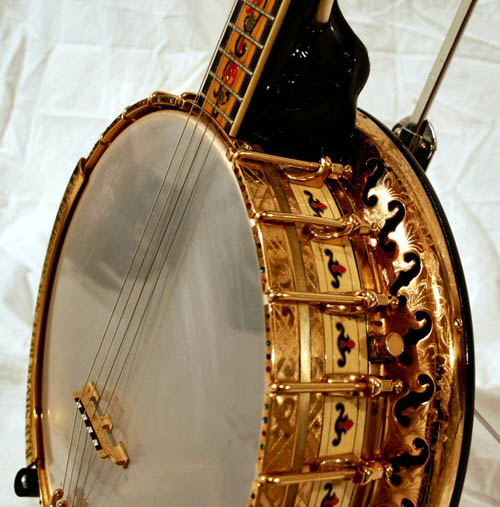
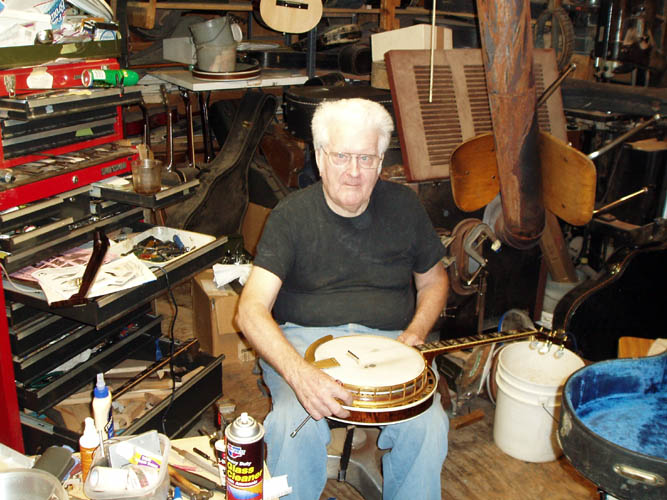
Harold Chriscoe of Seagrove, NC is a long time friend
dating back to the late 1960s +-. I visited with him today on 07-31-10
and we swapped ole stories, banjo building info while looking over
several pre-war banjos of which I had never had my hands on a ball bearing
Granada dating that far back; FON 8118-7. This Granada has a
very unusual piece of inlay in the headstock and everything was all
original. See the below pix of the head stock; look close and find the
abnormality which is not too obvious. Also inserted pixs of Harold's work shop:
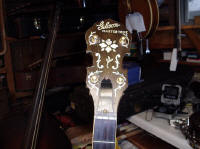
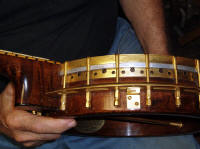
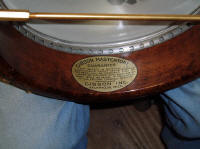
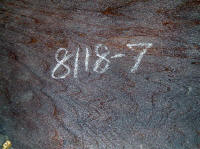
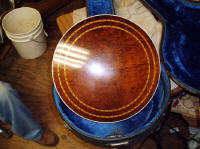
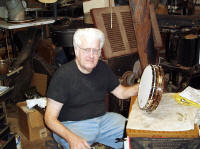
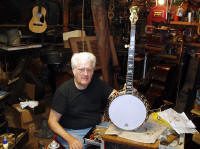
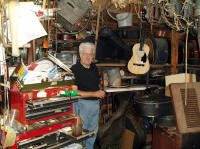
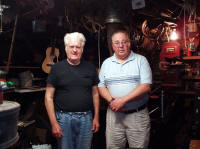
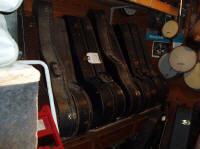
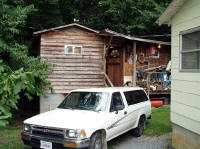
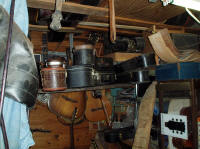
NOTE: I talked with Harold on 08-28-11 and
the above Granada was traded for a TB4 RH and some "boot".
Harold said he had turned down an earlier offer of 8K for the banjo.
In the above pixs, take a look at
Harold's work bench of which I call that
"working smarter not harder",
whereas he is able to do instrument repairs while sitting down in a regular
chair/stool which takes pressure off your legs and upper torso. To
reiterate, Harold could think outside the box and very well at that!
Harold said that C.E. Ward came into his shop and noticed his workbench and
was very impressed by it too! Harold traded a used tractor for one of
CE Ward's latest F5 clone mandolins that did not have any finish on it and
CE had played it for sometime while in the raw and it was definitely aged
in. Harold said it was a little difficult to get the finish like he
wanted on it because of the oils from the hands playing and handling the
mandolin.
Harold and myself did a lot of musical instruments and
parts trading back in the 1970s and he is an excellent top of the line repairman
and instrument builder. Harold had the ability to come up with
innovative ways (think outside
the box) of doing things back before specialty tools were available
and could and still does replicate the old Gibson stain and finish patterns as well.
Harold was able to use his table saw to remove the
required material off an arch top wood rim to convert it for a flathead tone
ring without using a lathe. He also had a router mounted underneath
his table saw top, whereas he could do precision routing without the usage
of a separate router table.
Harold's shop is packed with untold quantities of instruments, parts, etc. and doubt if
he knows exactly what he has...grin if you must. We dry fitted a
couple original tube and plate flange necks on my "Flaming Claw"
pot assembly and made a few measurements of the neck drop at the nut before
I drill the hanger bolt holes in my Flaming Claw PREWARTONE neck. It was a most
enjoyable visit and both our hair has gotten much whiter with all the norms
associated with "maturity", but we still have a
"sparkle" in our eyes for THE GREAT DEPRESSION ERA musical
instruments!
Harold would usually end our
conversation with "Good Nuff."
GOD SUPPLIES OUR
EVERY NEED!
Harold purchased a mint condition Gibson Hummingbird
guitar from me near Christmas in 1978, the year before I sold my
business and his purchase allowed our "kids" to have a wonderful Christmas
that year when things were really, really tight money wise. My
bride has not
forgotten that sale to this day and simply states,
"Harold was God sent with
her prayers being answered" and I do concur that as well!
I asked Harold if he still remembered that visit and
purchase and he said he did. He said he hadn't planned on coming this
way, but just got in his vehicle and headed this way. He had folding money in his wallet,
exactly the amount we needed! Like I
said, "God supplies our every need."
Harold Chriscoe was a permanent "fixture" at most of
the Bluegrass Festivals back in the 1970s and always on the look out for
that "Holy Grail" flat head Mastertone too, whereas he has had
his hands on many of them over the years!
Harold had a trading friend named "Buck" Grimes (now
deceased), of which I probably traded for a car trunk full of all kinds of
guns over the years and other things such as knives, etc. before all the red
tape for third party selling/trading of weapons came into being.
HAROLD CHRISCOE
APPRECIATION DAY
There are several YouTube videos of the Harold Chriscoe
Appreciation Day published on November 9, 2015 where many musicians from
various parts of the country came to Seagrove, NC to honor Harold Chriscoe
for his contribution to the Bluegrass Music Community. An award was present
by Sandra Hatley with many musicians displaying their talent.
Below is the hyperlink to the presentation of the
award.
https://www.youtube.com/watch?v=Epo4QYgx_yA
Web page updated by Bill aka Mickey Porter on 07-23-19.
UPDATE: I recently talked with Harold
Chriscoe via telephone and his daughter was killed in a car accident six
months ago. Harold's wife died 18 years ago and with his current
health issues, needs our prayers. Harold is on my daily prayer list
and I have a tremendous amount of respect for Harold! Web page updated by Bill aka Mickey Porter
on 05-13-17.
HAROLD'S HEAVENLY
HOME
Harold Chriscoe went to his
heavenly home to meet our Lord and Savior
Jesus Christ on July 25, 2018. Prior to his death, I talked to Harold via telephone and he
told me that the last chemo therapy treatments given did not help him and
the Drs. told him there was nothing else they could do. Harold has
been in my daily prayers since I learned of his medical issues and it was
my recent prayers for God to heal him if it was His will and if not, to take
him on home without a lot of pain and suffering.
I have many wonderful memories of Harold and have a few
tid bits posted above about Harold. Back in the early 1970s, Harold
wore a "ten gallon" white Stetson hat and I believe I took a pix of him
wearing it, but it got lost over the years.
Harold was one of the most kind, gentle, honest, humble,
generous and meek
persons I have ever known. I certainly miss him, but plan to see him
again when the
rapture/resurrection takes place which
can't be too far in the distant future! Good bye for now my friend,
until we meet again!
My prayers go out to Harold's family and friends in
their present time of sorrow and grief and with the Lord's grace and mercy,
time will help heal!
Web page updated by Bill aka Mickey Porter on 07-28-18.
UPDATE
I talked with Glenn Chriscoe, one of Harold Chriscoe's
sons today, (09-14-2022) and Glenn gave me permission to place on this
website that Harold owned Gibson pre-war RB18 banjo FON 744-1,
of which was later sold upon the death of his Dad along with other valuable
pre-war instruments. I have particular information about this banjo on
my web page hyperlinked
here.
I thoroughly enjoyed talking with Glenn Chriscoe and we
both reminisced about his dad Harold and it seems like only yesterday, I
posted the pictures taken of Harold on 07-31-10. Time definitely waits
for no one.
Web page updated by Bill aka Mickey Porter on
09-14-2022.
Back in the early 1930's a barber named Jim Graves who
owned Graves Barbershop in Wadesboro, NC had a Gibson dealership as a part-time venture and several
Gibson Mastertone 5-string flat head banjos were sold to individuals within a 10 mile radius of
which I tracked down. "Buck" Wheless's dad "DeWitt"
Wheless of
Ansonville, NC ordered an RB3 flat head around 1934 and had Jim Graves send it back to the factory to
exchange it for a gold plated flat head and don't remember him mentioning
anything about an engraving pattern on it and it took only a few weeks to
process and
Buck Wheless could not remember if it was mahogany or curly maple wood on
the neck and resonator. A banjo trader here in NC found out about the DeWitt Mastertone Gibson banjo
around 1960 and visited DeWitt Wheless and "Buck" Wheless was present when
the banjo trader persuaded his dad DeWitt to sell him the banjo if he ever
decided to sell the banjo "since
he was wanting another good Mastertone banjer to play because he had gotten
sick and had to sell his banjer" which was very
deceptive to say the least and untruthful!
Shortly after DeWitt Wheless died on February 16, 1961 the banjo trader showed
up and purchased the banjo from "Buck" Wheless sometime
within the next month for $150 dollars and "Buck" felt like he was obligated
to sell the banjo to him who "Buck" did not realize that he
was a professional banjo trader or that the banjo was easily
worth 2K dollars.
I visited the the banjo trader at his home in late 1969
or the early 1970s to ascertain the whereabouts of the Wheless banjo and he
stated to me that he had sold that banjo to a professional musician in
Nashville for 2000 dollars which ended my search for the banjo thinking that
it was the truth. The professional banjo player was the truth, but his
location was untruthful.
"Buck" Wheless told me on 09-14-09 that Jim Mills
had visited his home about three years ago doing research on the DeWitt
Wheless banjo and knew where the banjo was located and had his hands on the
banjo and thought it was a consecutive serial number to one of
Fisher Hendley's Mastertone banjos. Buck later told me that Fisher Hendley's
banjo and his Dad's
banjo
were ordered the same day and both banjos ordered received a few weeks later via train shipped
to Jim Graves (Graves Barbershop) in Wadesboro, NC. Fisher's Hendley's banjo
was FON 9584-3 belonging to Mr. Earl Scruggs after going
through a couple different professional musician's hands; i.e., Snuffy
Jenkins and Don Reno.
NOTE: I followed a couple leads on the
above banjo on 09-18-09 and 09-19-09 and talked to it's current owner who
wishes to remain anonymous on the web at this time and he
purchased the banjo from the same banjo trader mentioned earlier in the
Spring of
1965. He stated that he gave 1025 dollars for the banjo, whereas the
banjo trader was asking 1500 for it and would come down a hundred dollars in
price and finally agreed to sell it for the above price which included 25
dollars for gas money for the banjo trader to deliver it to him. The
Hearts & Flowers fingerboard had been replaced at the factory with their
standard bowtie inlays sometime around 1962 and some refinish work was done on the banjo right
after Carl Hunt purchased the banjo from the same mentioned banjo trader in 1961 and Carl Hunt
later sold/traded it back to the banjo trader for another flat head banjo, (The Jessie
Brown banjo 9473-3) of Polkton, NC that was also purchased by Jim Graves, Gibson
dealer in Wadesboro, NC. It makes one wonder
why Carl Hunt traded the
Wheless Granada back to the same banjo trader for a lesser grade banjo after he received the
Granada banjo back
from Gibson with the new fingerboard installed, however each one of us has our own unique preference toward
sound and playability. In my
humble opinion,
with the Gibson replacement RB 250 Bow Tie inlaid fingerboard, the overall
thickness of the neck was larger (thicker) than what Carl Hunt was
accustomed to with the original fingerboard. Pre-war Mastertone
Brazilian Rosewood fingerboards where about 3/32 inch in thickness versus
3/16 inch thickness of Gibson post-war fingerboards.
Basically, the same thing
happened to Earl Scruggs Granada FON 9584-3, whereas he sent the
banjo back to Gibson and had the original hearts and flowers fingerboard
replaced with a standard RB 250 bow tie pattern which was a thicker
fingerboard and he wasn't satisfied with the neck thickness. Earl took it upon himself to cut the thickness of the
neck down or have it cut down (that was related to me), which caused the original neck to warp and had a replacement neck
made. There is documentation on the Banjo Hangout detailing what has
been done to that banjo over the years with a couple different necks on the
original Granada pot assembly and the wood rim was turned down by Gibson for
a replacement one piece flange. The original wood rim would be
classified as a "Fat Boy" wood rim due to the size of the larger
inside diameter of the original die cast
flange.
The current owner had the bow tie
inlaid fingerboard later replaced by CE Ward.
A local banjo player Brutus Gale (deceased) who owned a
shoe repair shop in Wadesboro, NC and also a Gibson Mastertone flat head
banjo FON 9528-1 and played with the Anson County Ramblers on radio station
WADE in the 1940s, related to
me in the early 1970s that he played both banjos that Buck's dad had purchased and he said the one Graves sent back to the
factory (RB3 flathead) unknown FON sounded better than the gold plated flat head
Granada FON 9584-5.
The current owner of the Wheless Granada banjo visited
my shop in the middle 1970's, however we didn't discuss his Granada banjo of
which I was unaware that he was the owner of the Wheless Granada banjo. Man,
that was about 58 years ago! The Granada now has an original
style Hearts & Flowers fingerboard done in Brazilian Rosewood by Harold
Chriscoe of Seagrove, NC and I
believe is the 4th fingerboard on the original neck.
The Wheless banjo FON is 9584-5 is one of
the Granada Holy Grail banjos from the same production lot as Earl Scruggs
FON 9584-3 originally belonging to Fisher Hendley and Sonny Osborne's
FON
9584-2 and 9584-1 was sold to Hubert Lowe.
There are unanswered questions about the 9584-4. I could be
wrong, but believe all from this FON 9584 had a cut Mastertone label on the
wood rim and started out as raised heads and the flat head tone ring
was later added while at the factory before being sold to their original
owners back around 1934 as flatheads, although their production was apparently in 1930.
Below is one of two existing pixs of DeWitt Wheless
with his Gibson RB Granada Mastertone Hearts and Flowers flat head banjo with a double
cut peghead. I enlarged the pixels and noticed the standard Granada
engraving pattern on the armrest. Whether or not Gibson retrofitted
his existing banjo with gold plated parts in 1934, or replaced the entire banjo, I
don't know. The banjo is a 1934 purchase RB Granada flat head after consulting
with the current owner. The Granada has the old style resonator
featuring two wood purfling rings in the resonator.
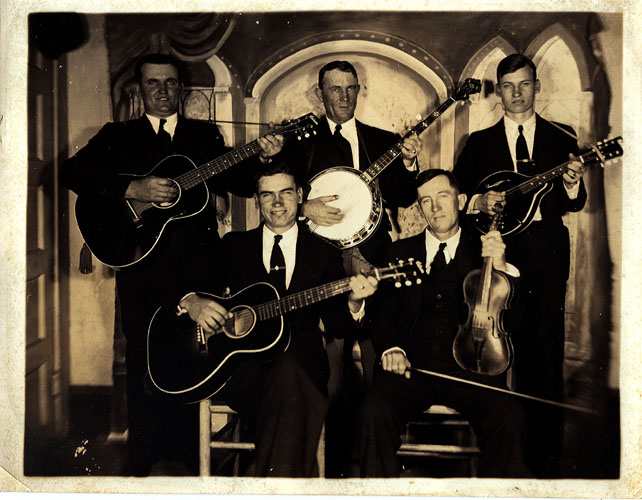
Picture taken in 1940 with Joe Hildreth standing with
guitar, Dewitt Wheless banjo, Jim Hildreth mandolin, Blake Hildreth guitar
sitting and David Lear fiddle. Group named "Skillet Lickers".
Banjo fingerboard does not have an inlay at the 15th fret which was normal!
Enlarged pixels of the armrest which has the standard
Granada engraving pattern on it...I could not make out anything on the
clamshell tailpiece or the tension hoop at that camera angle or the type of
wood. Talk about being excited after viewing the armrest engraving, I
knew it had to be a Granada:
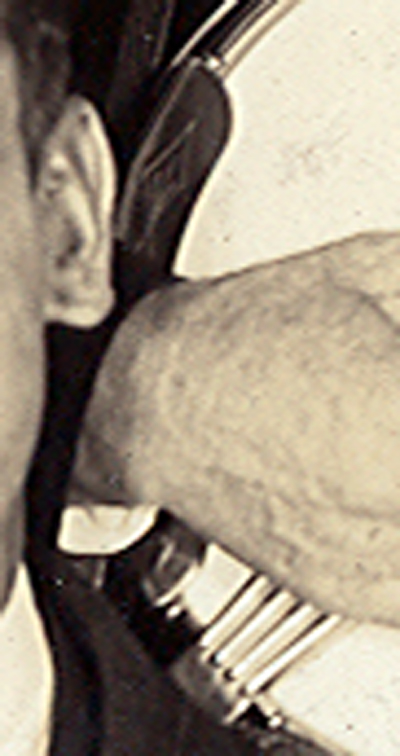
The other pix of DeWitt Wheless and his band, a few years earlier around
1936 in Charlotte, NC. I think Crazy Water Crystals was one of their
sponsors:
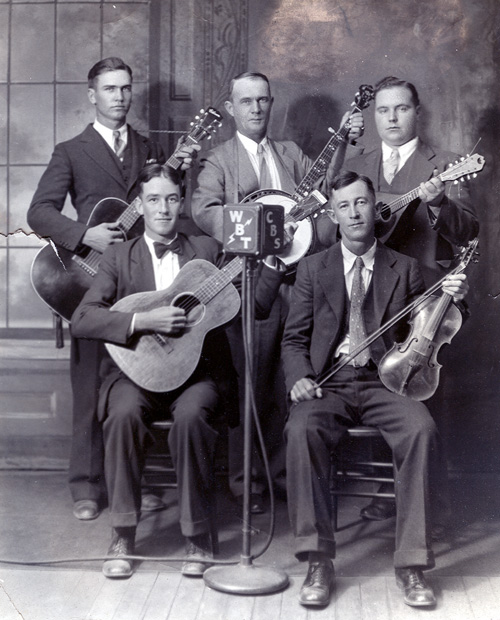
I have a sound file of the Granada played by the current owner that was
recorded about five years ago. Click on
Dear Old Dixie to
open a .mp3 sound file which is a little over 2 megs. in size. A good
solid Scruggs sound for sure! Those that have heard the banjo
recently, state that it has a much better sound than on the track above!
It was great to bring closure to the DeWitt Wheless banjo since I had looked
for it as early as 1969 when I started my Musical Instrument Repair business
and didn't have the time or resources to invest in such a great banjo that
is now part of the Granada Holy Grail Legacy!
I talked with the owner of the DeWitt Wheless banjo
last night, 02-01-14 and he agreed to let me publish his name on my website and he is
Tim Myatt at Snow Hill, NC and their local band is Highway 58 Bluegrass.
Tim had his Granada authenticated last year at the IBMA 2013 by Steve Huber and Joe Spann.
Tim related to me that he attended the Banjothon 2014 and many pickers were
very impressed with his Granada FON 9584-5 and his pickin too.
As soon as one of our friends health improves, (Harold Chriscoe), Tim and I plan to meet at our
friends home and I will take some photographs of him and his Granada.
I told Tim that most of the banjo pickers and traders in this part of the
country have known for many decades he owned the Granada 9584-5 which is
part of the Granada Holy Grail Legacy!
It was great to talk with Tim Myatt who has an
excellent
knowledge of banjos and some of the old-time banjo traders and we swapped a
few stories from the past for an hour or more over the telephone. Tim
might be doing an article for Bluegrass Unlimited and give a recap of the
history of his banjo which is well documented on this page.
Below pix of Buck Wheless 09-17-09:
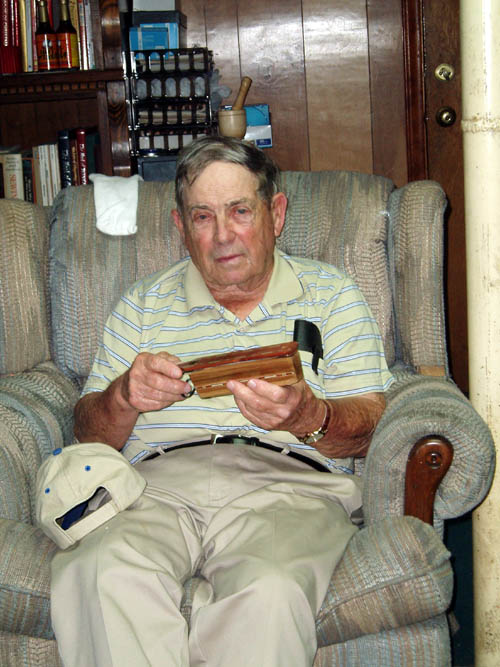
Buck Wheless, son of DeWitt Wheless came by the house
with two pixs of his Dad and I scanned them and presented Buck with one of
my Porter Dual Hens Field Grade Box calls made out of Butternut wood base
from Kentucky and Cedar wood lid from Anson County, NC. Buck still
turkey hunts and hope he will harvest another one this coming Spring season
with this call.
NOTE: Buck passed away on October 4, 2020
at the age of 90.
Mr. Brutus Gale (mentioned above) also owned a Gibson
1934 purchase RB3 flat head FON 9528-1 that had a wreath inlay pattern on the peghead and
fingerboard that he purchased from Bill Thompson in Wadesboro, NC in 1945 for 75 dollars that was purchased
from the Gibson factory by Jim Graves. I personally talked to Bill
Thompson (not the Bill Thompson
that owned a local grocery store) in the late 1960s and he steered me to Brutus Gale who stated that the same earlier
mentioned banjo trader came by and looked at the banjo several times in the early to mid 1960's
trying to purchase it and when he became sick needing money, he swapped the
banjo for an RB250 and I believe was given 150
dollars "boot". The same banjo trader later came back and swapped him a cheap
Kalamazoo banjo for the RB250
banjo with additional "boot", whereas he sold the RB3 wreath flat head banjo to
Junior Lowery of Goldhill, NC of whom John Bowles of Advance, NC purchased
the banjo around 1974 directly from Junior Lowery after seeing an ad in
Bluegrass Unlimited Magazine. Junior Lowery offered the banjo to me for 1500
dollars in the early 1970's, but I knew he was not serious and I couldn't afford the
banjo at that time anyway due to a growing family (three kids). I guess all
this was said to show how fast Gibson could deliver a banjo in the 1930's of which they
apparently had a good inventory of instruments on hand. The above
banjo is shown on Greg Earnest
website
with pixs. You could order basically any inlay pattern of
your choice according to Brutus Gale and George Hall in addition to Gibson
using up what materials they had on hand when discontinuing standard models
as evidenced by the mismatched patterns on existing pre-war Mastertone
banjos.
The Gibson RB3 flat head banjo FON 9473-3 (not the Wheless
Granada banjo) that Carl Hunt
(deceased) who played with The Arthur Smith Show in Charlotte, NC on WBTV
Channel 3 back in the 1960's was sold to (Jessie Brown) deceased of Polkton, NC by Jim
Graves in the early to mid 1930s of which again the same earlier mentioned banjo trader purchased it in
the early 1960s and sold it to
Carl Hunt. Carl Hunt left the banjo case behind his car and ran over the
banjo and broke the neck of the banjo and CE Ward of Charlotte, NC built a
replacement neck, but the banjo didn't sound as good with the original neck.
There is much to be said about banjo necks also! Below pix of Carl
Hunt at Union Grove Fiddlers Fest in 1967 taken by Ken Landreth with the Jessie Brown all original
flat head banjo with the exception of a C.E. Ward reproduction neck.
I have been unable to ascertain if the original 5-string neck had the
standard Leaves and Bows inlay pattern on it as did other banjos in the FON
9473 lot. Photo courtesy of
Gene Knight, Marshville, NC:
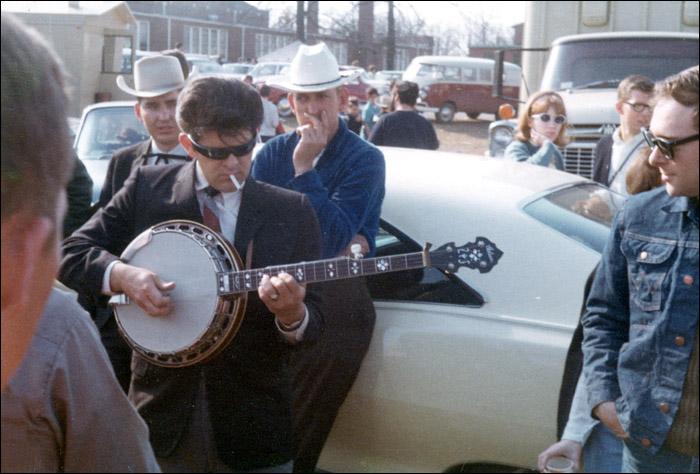
Gene Knight stated that the neck and banjo pot assembly
were later separated and Al Osteen had the neck and the pot assembly was
stolen FON 9473-3. CE Ward
stated that Carl Hunt loved to play that flat head Gibson and would stay up
all hours of the night playing when the rest of them had long sacked out!
If memory is correct, the wood rim has some special scallops cut/drilled into the
inner top portion of the wood rim that supports the "foot" of
the tone ring that makes contact with the load bearing surface of the wood
rim. The flat head tone ring was one without holes and no doubt the
theory was to "open up the sound chamber", although I doubt any difference
in tone or volume was observable. This was either done by CE Ward or
Carl himself. This banjo was from FON 9473 which were inlaid with
the leaves and bows inlay pattern, but have not been able to ascertain if
that was the inlay pattern on this neck. This pot
assembly has been stolen twice and currently still missing, but I could be
wrong about the info since it has been a very long time ago.
In the early 1970's I talked with Jim Graves daughter
about her Dad to ascertain if any records existed of his Gibson Music
Dealership and there were none. Graves Barbershop was located in the
basement of the old Lyon Building on the square in Wadesboro, NC which later
burned down in 1983 and a vacant lot now. See this BHO link for
additional information:
http://www.banjohangout.org/archive/257048/2
To get a perspective of the price the Gibson Mastertone
banjos sold for in
1934
as it would relate today, the average cost of a new home was $5970, average
wage was $1600 per year and the cost of a gallon of gasoline was .10 cents.
There were many, many folks that made far less than $1600 per year
especially in poverty stricken areas where the unemployment rate was well
above the National average of 22 percent. Considering all of those
factors, a similar Masterclone banjo
manufactured today is still a bargain. However, the original pre-war
Gibson flat head Mastertone banjos have inflated over a thousand (1000) times
their original sale price in less than eighty (80) years! It is also
hard to believe that some model Gibson Mastertone pre-war flat heads 5-string
banjos that sold for 1500 dollars in 1965 are now worth between 125K to 250K
depending on how deep the buyers pockets are.
It all boils down to, Supply
and Demand and the quest for the elusive pre-war sound? and the
opportunity to have what is considered the bench mark or best, whether
real or imagined. Lets face it, there were only so many made and the
demand far exceeds the supply and there are those today that have the resources
to purchase and/or invest in something that most cannot rationally attain!
There is nothing wrong with
buying the best if you can afford it!
Most of the people
I interviewed or their children in the late 1960s that purchased pre-war Gibson Mastertone banjos
during the depression era,
were in some well paying job or self employed; definitely living "high
on the hog" as ole timers would tell it!
COST OF LIVING IN
1965
Average new house cost $ 13,600; average income per
year $ 6,450.00 and cost of a gallon of gasoline .31 cents. The
minimum wage was $ 1.25 per hour or $ 2,600 per year for a 40 hour work
week.
The die-cast
one piece flange (OPF) was outsourced by
Gibson to Doehler Die Casting Co. and later the company became Doehler Jarvis.
Gibson used the one piece die cast flange to reduce the raw materials and labor cost and not as any sound
enhancement contrary to what many believe. I have seen at least three
(3) different banjo neck heel sizes for the OPF including an early Granada and
there might be as many as five (5) different sizes since they made the one
piece flange (OPF) larger and thicker with each mold revision for strength purposes due to the
weakness of the zinc alloy later referred to as
Zamak
(pot metal) and/or zinc alloy used. The earlier die-cast flange (OPF) yielded a slightly
thicker wall wood rim of which many refer to as a "Fat Boy Wood Rim."
Pre-war rim wall thicknesses vary from around .600 to .641 depending on
which one piece flange was used. Changing the depth of the pot
assembly in reference to the resonator has more effect which can be proved
by audio analysis. Take a look at this YouTube
video of Earl Scruggs playing Fireball Mail and notice how deep
his banjo pot assembly is setting in the resonator which accounts for that
gutsy, hollow, growling type tone. It is to my understand the banjo
was retrofitted with a newer post-war flange and the rim was cut to fit the
flange resulting in shorter length L brackets allowing the brackets to rest
on the resonator side wall instead of resting on the lip of the resonator.
I personally don't believe all the hype about a few thousands of an inch
making a drastic difference in tone, but if you have
PSYCHOLOGICAL BIAS, it certainly does. Whether the one piece
flange and rim is superior in tone production is and has been open for debate for
decades. Current die cast one piece flanges are manufactured from a
much stronger alloy than Zamak (pot metal) and/or zinc alloy that was used back in the 1930s.
Many are not convinced that the one piece flange is superior
to the two piece flange, but the Granada Holy Grail Syndrome players are using the one piece flange
banjos and who does not want to follow the leaders that are or were the best
in the field! Grin if you must! The overall
thickness of the two piece flange wood rim was about 1.25 inch versus
3/4 inch for the one piece flange. On the pre-war 3-ply wood
rims for the tube and plate flange, a separate lamination was added to the
outer ply and glued into a very tight fitting mortise joint that was shaped
to fit about 1/2 the radius portion of the tube and did not have a lap joint,
but there was a gap between the two ends of the wood and hide glue was used
as a filler, but not flush filled and very obvious and hidden by the neck
heel. I have never
witnessed that outer lamination separate from the outer ply of the 3-ply
wood rim. A very solid method of construction, but very labor intensive
to say the least and was replaced with the introduction of the one
piece flange/wood rim.
It is to my understanding that CE Ward of Ward's
Musical Instrument Repair in Charlotte, NC had a pre-war tube and plate
flange wood rim turned down to the thickness of the lower portion of the
wood rim to match the one piece flange wood rim specifications and there was
no noticeable difference in tone or volume.
I personally don't believe the additional width at the
bottom portion of the wood rim changes the resonant frequency of the air
chamber inside the resonator
enough to impede the volume and tone, however the extra weight of the wood
rim added is certainly open for debate and discussion as to volume and
timbre enhancement or reduction. There is a difference in the
distance between the head and the bottom of the resonator between the one
piece flange and the two piece flange design of which the one piece flange
sits lower into the resonator lowering the resonant frequency and
probably helps account for that hollow, tubby, dry, more gusty, growling sound that so many think
is the pre-war sound, but that sound I more or less equate to the Foggy
Mountain Banjo album sound by Mr. Earl Scruggs and the studio
recording of that particular album. Therefore, the tube and plate pot
assembly has a higher resonant frequency rendering a brighter sound with all
things being equal without changing the set-up to manipulate or reduce the
higher resonant frequency inside the pot assembly. This
conclusion seems paradoxical,
however with the pot assembly lower into the resonator with the bottom
of the wood rim closer to the resonator reduces the size of the opening (aperture) that exists between
the bottom of the wood rim and the resonator which you can view as a type of sound hole and this attributes to the lower
resonant frequency. I say it
sounds paradoxical because
larger sound chambers tend to produce a lower resonant frequency with all
things being equally compared, but the
aperture or opening between the bottom of the wood rim and the resonator is
the controlling factor in this case. It is like changing the
shape/size of the F holes in a violin or mandolin. Many are convinced that the tube also acts the
part of an additional tone ring and creates a much brighter sound, but again,
this is open for debate. The tube and plate flange was produced
in house by Gibson employees of which I can personally vouch for the labor
part. My system of taking a 10 ft. piece of .375 inch diameter heavy
wall brass tubing and wrapping it around a mandrel and cutting down through
them to produce three (3) complete units was exactly the method Gibson used
and George Hall and Dave Kennedy provided nearly all the info to produce
that part. It took some experimentation (trial and error) to ascertain
the amount of spring back in the tube before a final helical spiral bending fixture
was manufactured. The coiled tube was then placed in a dedicated cut
off saw/fixture which produced the desired ID for the tube taking into
account the thickness of the saw blade used. John Bowles of Advance, NC has all the tooling;
dies, etc., I had manufactured and made to produce the tube and plate
flange. One single production run of the tube and plate flange paid for the entire tooling and
equipment investment which I believe was less than 6K and ahead of the
introduction of the Japanese imitation banjo parts. Can you say
"Corporate Greed Of America"
as to the culprit for the Japanese imitation banjo parts that flooded the
market! It is to my understanding that Frank Neat purchased and/or
traded for the tooling from John Bowles that I had manufactured to produce
the tube and plate flange, etc.
I personally favor the tube and plate assembly because
it is better engineered without the usual flange bending upward due to more
pressure than the zinc alloy can with stand over the years.
It is a more costly method of construction requiring a larger OD wood rim
(four plys) which was it's demise during The Great Depression Era. Gibson
post war and clone one
piece flanges are far superior to the pre-war ones due to a stronger metal
alloy being die-cast.
The one piece flange does have the edge for rending
more of that hollow, dry, throaty, tubby, growling and gutsy sound so many are in
love with and this has been a controversial subject for decades! I
believe the sound just mentioned above is because of the
resonant frequency
of the pot assembly and not the tone ring!
Click on this
hyperlink of an audio file in .mp3 format featuring both a two piece
flange banjo and a one piece flange banjo. See if you can pick out
which is which. Audio file courtesy of Julio Boysenberry, Santa Maria,
CA.
Clermon "CE" Ward (deceased) who operated Ward's
Musical Repairs in Charlotte, NC. back in the early 1960's was one of
the earliest to do Gibson Mastertone banjo conversion
necks in NC and has cut up more tenor and plectrum original banjo necks
than any person in this part of the country, maybe the US. CE is an
outstanding banjo and mandolin picker and won the Banjo Picking Contest in
Union Grove, NC way back when. CE had a contract to do Band Instrument
Repairs for the Charlotte School System and also later worked as a auto body
repairman. I "gleaned" from his experience and he was a
foundation stone in getting myself started doing custom inlay work.
I later supplied him with the majority of his Gibson banjo inlay patterns.
CE made outstanding reproduction F-5 mandolins long before
Gibson reintroduced them again and many of his F-5's are in the
hands of professional musicians today. CE is retired and lives in
Concord, NC and below pix of him and Bill Simpson around 1979.
CE Ward (left) in the pix and Bill Simpson (right in pix) was a tool and die maker who did
some of my
early fixtures for metal components. In the early
1970's, I purchased CE's show cases when he closed his Music Repair Shop in
Charlotte, NC and still have two of them today for my archery and reloading
supplies and equipment. CE continued to do music repairs and build
instruments while he worked full time with a Ford dealership in their auto
body repair facility after closing his Charlotte, NC repair shop and
relocated to Concord, NC.
GIBSON MASTERCLONE BANJOS & MANDOLINS
CE, didn't have a lot of positive comments for pre-war
Gibson flat head banjos and would quickly tell and show you his personal
Fender Artist model banjo would pick rings around most any pre-war Gibson
flat head banjo.......grin if you must! He certainly had first hand
experience with many, many pre-war flat heads decades before they started
getting scarce. The ironic and flip side of the coin, Gibson pre-war
reproduction instruments did help to fill his cash register drawer on a
regular basis! Many of those Gibson clones, featured guarantee
Mastertone decals and the "whole ten yards", but that is what folks wanted
back then! At the time, Gibson did not manufacture the old style
Mastertone banjos and the demand was for them. There was no intention
to produce a fake banjo and some of those banjos today do look like the real
deal, including the original head veneer sliced off the original tenor or
plectrum neck and glued onto the reproduction neck leaving the black lacquer
in place, original inlays removed from the fingerboard and re-inlaid Gibson
style by cutting through the fingerboard, mandolin fret wire used, heel
fitted to the pot assembly using chisels, wood inlay strip over the top of
the truss rod visible at the neck heel and many other things that makes one
think it is an original pre-war Mastertone. The reason for the chisel
marks on the neck heel by C.E. was because he had a cutter made by Bill
Simpson for the
one-piece flange heel fit, of which the cutter rotated on a direct drive
shaft motor in an arc, but apparently the neck was not secured perfectly to
address the cutter leaving the radius of the heel with the neck canted to
one side. Therefore, the heel had to be hand fitted more or less like
the pre-war banjos were. Also, as most knowledgeable students of
pre-war Gibson Mastertone banjos, there were four or five different sized
one piece flanges manufactured by Doehler Die Casting Co. and later the
company became Doehler Jarvis. They had to beef up the strength of the
flange, whereas the early one piece neck fitting was much smaller than the
later one piece flange Mastertone banjos of the middle 1930s and beyond.
I know personally, because I saw the cutter and fixture jig/assembly that CE
had Bill Simpson make for him and did not purchase it when he closed his
business in Charlotte, NC. I was not impressed with the cutter, motor
and fixture. I had Bill Simpson make several one piece
cutters and heavy fixture for a drill press for me prior to the purchase of the large Baxter/Whitney 7.5 HP
double spindle shaper and then had cutters made for it by a large company in
High Point, NC that specialized in profile cutter heads, etc.
Bill Simpson also made me a fret saw machine and I used
the pre-war Gibson banjo scale that came to around 26 3/8 inches, however
the Gibson prewar scale was a tempered scale and did not mathematically
equal the computer generated scales of today fret for fret, but close.
I currently use Helms Machine Co. in Monroe, NC
704-289-5571 for any lathe or machine work needed that I do not have
the machinery to do myself. Steve Helms work is flawless to say the
least! Prior to Helms Machine Co. in Monroe, I used the services of
Edsel Kiker near Red Hill to do machine shop work for me along with Benny
Galliher of Anson Machine Shop here in Wadesboro, NC.
NOTE: C.E. later, placed his own name of
the headstock of his clone Mastertones & F5s.
I find myself using some of CE's favorite sayings such
as, "Rube Goldberg"
and Cloverine Salve, when he described some bad looking
instrument work. CE
was a very colorful person and didn't mind speaking what was on his mind and
would give you his opinion if you asked for it and most of the time without
asking...grin now! I certainly do miss CE Ward!
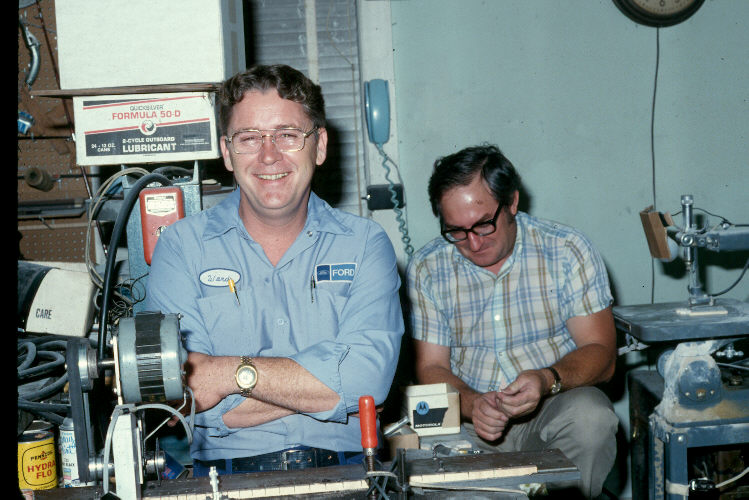
CE showing some serious grinning for sure!
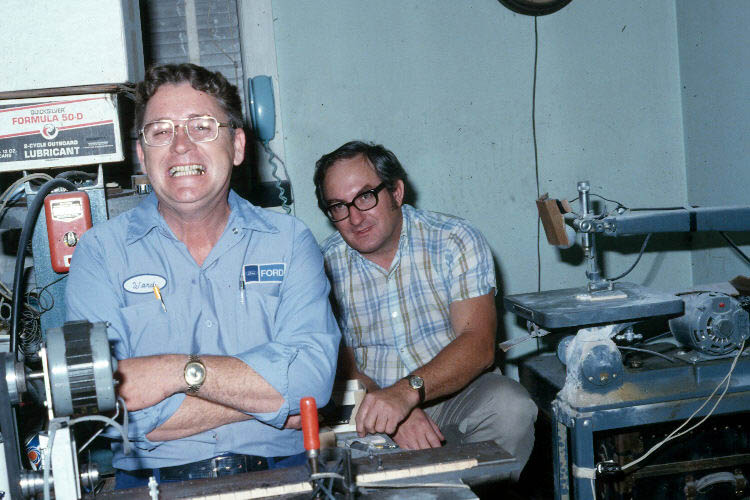
Note: I received the following information from Clarence Hall
of Stuart, VA on 05-11-09 concerning the death of CE Ward on May 7, 2009 as
follows: "Well known mandolin/banjo luthier Clermon Eugene Ward
(CE Ward) died Thursday at his home in Concord, NC at age 70. CE
started out building five-string necks for Gibson tenors in the sixties and
later built complete banjos with his own name on them. He built Sonny
Osborne's six-string (with an extra bass string) in the late sixties, at
Sonny's request. He was also a fine mandolin builder (I've owned three
of them over the years); Jack Lawrence has one, and Doyle Lawson used a Ward
A50 conversion when he played with the Country Gents. I've known him
for over forty years, and he will be greatly missed by
Joe Cline, Center Valley, PA."
BILL BENSON, SOUTHERN PINES, NC
I met a relative of Bill Simpson pictured below, who was a
machinists for a furniture manufacturing company in Southern Pines, NC and
his name was Bill Benson who died I am guessing sometime in the early 1990s.
Bill Benson built me another fret saw machine which was extremely heavy duty
and worked off the mathematical scale for frets and used a locator pin to
move the sliding table. Bill also built me a custom heavy duty fret
press machine which worked great and that was long before StewMac offered
one for sale. I also obtained a specialized cutter from Bill that
allowed you to freehand shape necks, of which the cutter was mounted on a
horizontal shaft; very efficient, but OSHA would have a fit if they saw that
thing in usage. You could push end grain wood onto the spinning cutter
head and it would not grab it and/or fling it out of your hands...grin if
you must! Bill and myself didn't pass any money, but we worked out
trades for materials and supplies, etc., and he put himself together a good
5-string Masterclone type banjo and did all the inlaying, woodworking,
finishing, etc. himself. Below is a pix of Bill Benson that I located
on 06-13-17 that was taken in my shop on White Store Road in the early to mid 1970s.
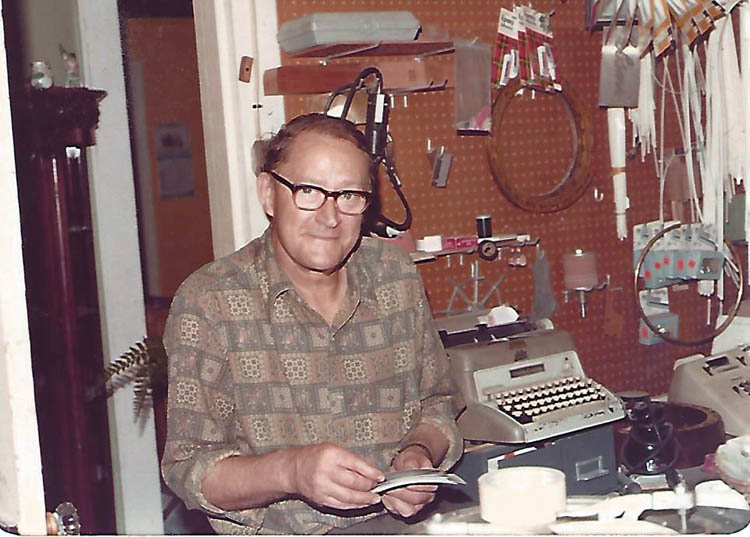
CE had a Fender banjo that he put together from a half
dozen other Fender banjos and he turned down an offer in the 1970s to
purchase an original RB18 from the banjo's second owner, the
same mentioned earlier banjo trader for 700 bucks because his Fender
would cut rings around the RB18. If memory is correct, I believe
the banjo trader brought the RB18 to CE Ward to have him replace the original calf
skin head on the banjo and offered to sell him the banjo at that time. Grin or cry on that one! That
same banjo was offered to another individual (Tim Myatt) for 1000 dollars, (current
owner of 9854-5) and every time
the perspective buyer went back with the money, the seller would up the
price 100 dollars each time until he finally agreed on the price tag of 1500
dollars and when the buyer returned with the money, the trader had already sold
the RB18 to it's current owner two weeks earlier. The
third owner of the RB18 purchased it for 1500 bucks and it is an excellent
all original banjo not for sale. I had the opportunity to put my large
calibers/micrometers on the RB18 FON 744-1 flat head tone
ring on 05-07-76 when the owner had it completed disassembled, but the owner
was afraid to allow any filings to be removed from the tone ring for
analysis. His RB18 wood rim has the filler strips installed both on
the top and bottom of the 3 ply wood rim which makes one think it is a 5 ply
wood rim of which it is not. The tone ring weight was 3
lbs. 2 oz. (50 oz.) weighed on a U.S. Post Office certified scale and
was .004 out of round at the top I.D. of the edge of the wood rim and .012
inches out of round at the outside diameter (10.997 and 10.985 inches)
- no doubt conforming to the shape of the wood rim over the years or vice
versa. The wood rim outside diameter at the extreme edge of the flange
was between 11.007 to 11.018 inches (.011 inches out of round) and matches
the tone ring out of round within .001 which was pretty close for a non-machinist
using the calipers!
One or two noticeable features of the above tone ring
was a ping test conducted did not reveal much vibration or tone generated at
all and didn't register on my testing equipment. The owner was very
alarmed over the ping test results and when he set the banjo back up, the banjo sounded great!
Also, the radius on the outer portion of the leading edge where the head
makes contact with the tone ring has a very small radius (nearly square).
This tone ring did not have the bull nose radius cut on the inside (tone
chamber).
Small subtle things when
compounded, creates a major difference in the long run!
Jim Mills recent book, Gibson Mastertone: flat
head
5-String Banjos of the 1930's and 1940's has pictures of the RB18
FON 744-1 banjo mentioned above.
The RB18 owner is an
excellent Craftsman too being Harold Chriscoe of Seagrove, NC (now deceased)!
UPDATE
I talked with Glenn
Chriscoe, one of Harold Chriscoe's sons today, (09-14-2022) and Glenn gave
me permission to place on this website that Harold owned Gibson pre-war
RB18 banjo FON 744-1, of which was later sold upon the death of
his Dad along with other valuable pre-war instruments.
I thoroughly enjoyed talking with Glenn Chriscoe and we
both reminisced about his dad Harold and it seems like only yesterday, I
posted the pictures taken of Harold on 07-31-10 added to my
biography page.
Time definitely waits for no one.
Web page updated by Bill aka Mickey Porter on 09-14-2022.
Mr. Davis aka "Dave" Kennedy of Athens, West
Virginia worked for Gibson from 1965 to 1968
in their repair and custom section. Dave is a genius at designing
things and holds a US Patent
4852446 for a banjo two-in-one tone ring and has given
away countless other inventions including a rimless banjo he applied
for a patent in 1963 and sold to Gibson and an early hot water heater on
demand design (tank less). Dave is a very intellectual man who
taught law, general math, bookkeeping, etc in a several schools in a couple
states. Dave did
contracts/beautification projects for strip coal mining companies and
majored in accounting with a minor in math if I am not mistaken. He was instrumental in providing
technical data and we "horse traded" many of my
banjo inlaid fingerboards
and pegheads for all sorts of things. Dave was the first to build a
wood bending machine to make the "jellyroll" wood rim described
above and I used his "prototype" machine for a few years and some
excellent wood rims were produced from his machine rendering outstanding
sounding banjos! Dave has a 250 acre park called "Highwall
Park" in Bramwell, WVA and host
bluegrass festivals and is open the 2nd Saturday of each month May through
October. Dave Kennedy uncovered a lot of original prewar
stuff "stashed" at the ole Gibson factory and had an original prewar
flat head engraved #6 tone ring that he received from Julius Bellsom of
Gibson who had the tone ring in his desk drawer for many, many years that was
sold/traded to Paul Hopkins of which Curtis McPeake had it at one time or
that is what was related to me anyway. I traded Dave Kennedy out of a
burlap sack
of un-plated original pre-war factory flat head tone rings
back in the middle 1970's and traded and/or sold them to Paul Sasser
(deceased) of Pleasant Garden, NC who was one serious banjo trader.
PAUL SASSER, PLEASANT GARDEN, NC
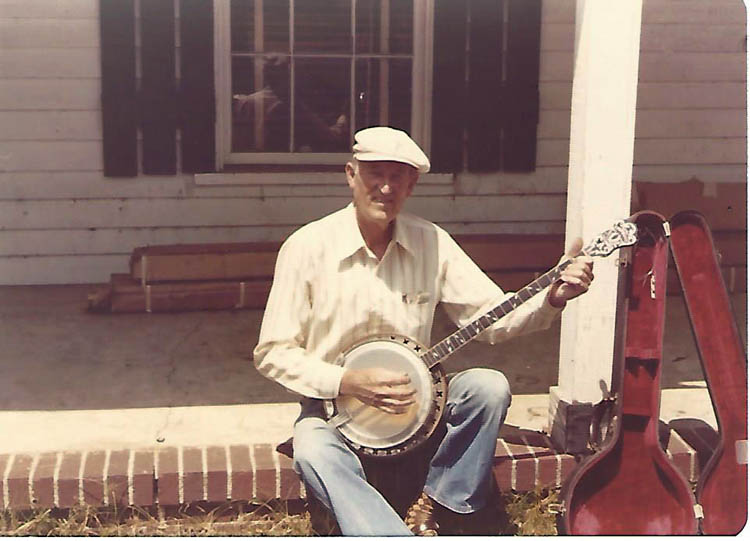
Above pix of Paul Sasser taken in the mid 1970s. Paul and myself did a
humongous amount of trading for various things and he was into trading for
the tenor and plectrum banjos, Paramount, B&D, Vega, Orpheum, etc., but did
run across some good arch top Gibson Mastertones from time to time and some
of the high end tenor and plectrum banjos. Paul was a painter by trade
and traveled a lot looking for musical instruments of any type. Paul
was a good craftsman also and he purchased and/or traded for a bunch of my
Gibson pre-war reproduction inlays, both precut and inlaid fingerboards and
head stocks. He was also into trading firearms as well, back before
all the red tape came of age concerning third party sales of firearms.
I took more pictures of him with several of his banjos, but found only two
pixs of him taken at that time, of which I located them today 06-13-17.
I remember how shocked I was when I called his home and found out from his
family he had just passed away from a heart attack, I believe the same day,
but could be wrong as to that particular day. Paul had a lot of
personality and most of the banjo shops and traders in NC and parts of
Virginia knew him well. Most of the instruments traders from that era
have passed on to the next life!
I am not aware that Paul Sasser ever owned a pre-war Gibson flathead banjo,
but that doesn't mean that he didn't!
Jim Yarboro of Gun Barrel City, Texas ended up with seventeen (17) of the
above tone rings. Dave had a large wooden shipping crate that
contained approximately 300 lbs. + - of un-plated original pre-war
flat head tone rings when I visited him and made the trade. No one
back then had any idea that type of stuff would be so valuable today since
original Gibson pre-war flat head 5-string banjos could still be purchased
for less than 2K in the early 1970s if you could locate them and 3K was top
dollar indeed!
There have been many questions raised about those un-plated flat head tone
rings over the years as to their actual manufacture date, but only time
can put decades of patina on unprotected brass and bronze and everything
else fit the pre-war period, plus they came from a reliable source. It
certainly is possible those rings were early post war production
that had been laying around the ole factory for 25 years or more until
"uncovered" and can't remember the skirt length, thickness, etc. and as
normal there were no unusual markings on the rings. With the many
different sized Gibson pre-war tone rings in usage during the pre-war era,
it would be extremely difficult to authenticate a ring based solely on the
physical size and shape, radius, skirt length, skirt thickness, tone hole
diameter, number of tone holes of an un-plated tone ring. I did
not have a spectrographic analysis taken due to the expense and those rings
were traded/sold as is which wasn't much more than a custom ring at the time
anyway; not like the high dollar clone
rings of today! Also, with the many different bronze alloys in those
Gibson pre-war tone rings, there is a wide margin for human error on this
one! Before I would shell out big bucks for anything that was in
question, there would have to be some serious provenance documented.
NOTE: The trained observer will notice on many of the pre-war
flat head tone rings, the lathe tool marks (similar to the tool marks on a
brake drum after turning or the grooves in an old 78 RPM vinyl record) is present on the slope of the tone ring due to
not removed prior to the plating process which renders a different color,
brightness and texture than the outside surface of the tone ring. Also
on many of the early and later year pre-war flat head tone rings there is a
flat portion in the "gutter" of the tone ring that has a radius on
each side that terminates into the angle from the slope and the skirt that
many refer to as a "bull nose." I
don't have the reason why Gibson used the bull nose cut unless it had
something to do with having to cut more or less material from the tone ring
casting to remove the sand cast mold imperfections, etc. It
should be noted that NOT all the pre-war
flat head tone rings possess the flat "bull nose"
aka gutter
cut so you can't say
this is the gospel for every Gibson prewar flat head tone ring. I have
seen them with a much smaller radius and also a .375 inch radius cut. The "bull nose"
aka gutter
cut appears more on the flat head
tone rings that weigh around 48 ounces or less.
Two pixs below of what the bull nose cut looks like. Frank Schoepf
made a "dental casting" of the inside of a flat head tone ring and Steve
Huber authenticated that the ring was pre-war. Click on thumbnails for
a larger screen view:
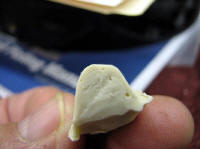
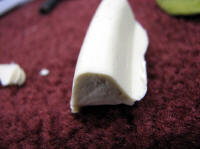
Photos courtesy of Frank Schoepf, Hampstead, Maryland.
Below is a pix of a "bull nose"
cut on a flat head tone ring FON 9528-3 courtesy of
Greg Earnest:
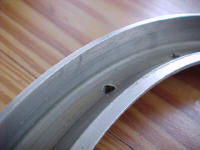
Below pixs courtesy of Frank Schoepf, Hampstead, Maryland of the casting
plate used by pre-war Gibson's (foundry vendor) for their flat head tone
ring casting. The casting plate is owned by Eric Sullivan,
First
Quality Music and photographed at the Banjothon 2012 convention:
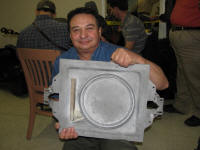
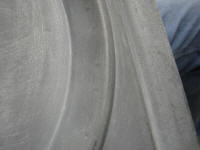
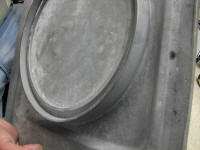

Frank has a good grin going above...........grin if you must!
See additional information about those unplated flat head tone rings (Gibson
pre-war flat head fixture tone rings) about
five (5) paragraphs below!
I received an email from Bill Hayes of Shapleigh, ME on 01-14-10 concerning
the unplated "Pre-War" flat head tone rings I received from Dave Kennedy back
in the mid-1970s as follows:
"Hi Bill,
I've been on your site a number of times. Great information and good
picture of old Doug Hutchens and Clarence Hall. I met Doug a couple of years
ago and had dinner with him in Stewart VA. Also saw him again and met
Clarence last year at Banjothon. I was particularly interested in the
section that you had about the un-plated prewar flat head rings. Seems like I
have one and it is a corker. This is what little provenance that I
have on the ring from the guy I got it from:
This is the information I received from the family on the tone ring.
Harrison Freeman lived in N.C. and passed away some years ago. He had
a uncle, Herman Bueck that worked at the factory in the prewar years. They
did not know what year he started, but do know he was there in the late 30's.
I received the ring you have along with many other prewar parts and banjo's
from the family of Mr. Freeman. The ring you have I personally took to Curtis McPeake in which he fully authenticated the ring to be prewar. Have
you ever heard of any of those folks Bill? I would have never bought it
except that I hold Curtis in pretty high esteem on the old prewar stuff. Whatever you know would be appreciated."
Below pix (upper left) taken on July 14, 1976 of Dave Kennedy, his bride
Carol and their son Dwayne at our old home place on White Store Road in
Wadesboro, NC. The other pixs of one of their daughters Cheryl, holding a
couple of his banjos were taken somewhere around that period in Athens, West
Virginia at the Kennedy home. The
Kennedy Stainless Steel banjo in the upper right was awesome looking and
sounding back then.
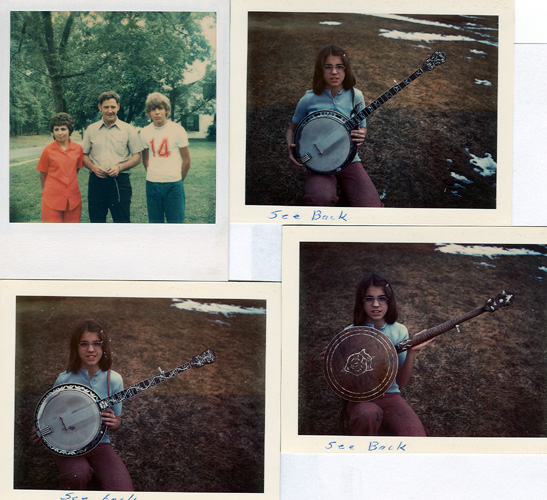
Note: Dave got the banjo on the upper and lower right pixs back
a couple months ago and is accepting offers for this one of a kind banjo.
The flange is made from 24 individual pieces shaped like an eagle and uses
the standard tube set-up with one of his 3 ply wood rims that does not have
any voids in it. Pixs below:
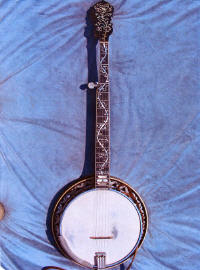
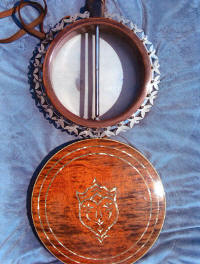
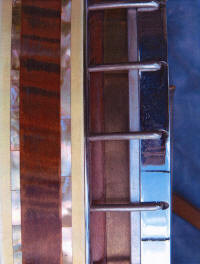
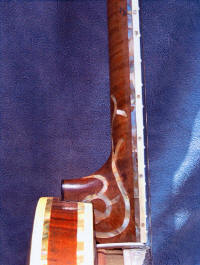
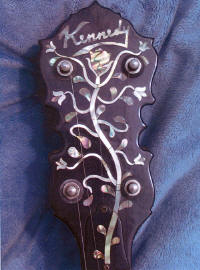
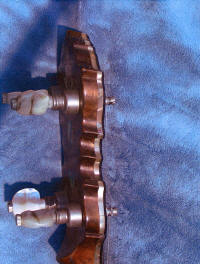
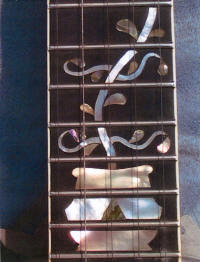
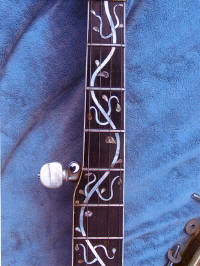
This instrument is profusely inlaid and Dave started on this banjo in 1969
working on it when he had the chance finishing it in 1976. The
un-plated flat head tone ring is from the same batch of un-plated tone rings
that came from the old Gibson factory that I have referred to above and
other places on this website.
PRE-WAR FLATHEAD TONE RING FIXTURES
However, I failed to mention about most of those tone rings. According to
Dave, the tone rings still had remnants of calf skin on them since they were apparently used
on special fixtures
used in the manufacturing process to produce calf skin banjo heads for
Gibson flat head tone ring banjos. Dave refreshed my memory about the
tone rings on 06-08-10 and he had forgotten that I ended up with most of
those tone rings until his daughter Cheryl had printed the info I have on
this website and sent it to him.
Davis aka Dave Kennedy is the real deal; the
rest of us have learned much from him either directly or indirectly and that
includes the current self-proclaimed
banjo gurus.
Davis aka Dave Kennedy can be reached at 304-384-7484 and cell number
304-961-6185. Dave's mailing address is: Davis E. Kennedy, P. O. Box
1219, Athens, WV 24712. Rob McCoury of White House,
Tennessee currently is playing this banjo. I nicknamed this
banjo the "Devil's Head" due to the inlay on the back of the
resonator.
Pix below of Dave Kennedy, his "bride" Carol and I
believe that is their son Dwayne (or his hands/arms anyway) with his
"jellyroll"
prototype wood rim bending machine. Dave later built another
full production model that was strong enough to be used as a mini-crane.
Dave stated that Paul Hopkins purchased/traded for the full production machine and the
prototype was purchased by Doug Hutchens and Frank Neat recently obtained
the prototype machine.

NOTE: Davis E. Kennedy passed away at his
home in Athens, WVA on March 30, 2018 and was 86 years old. Dave was a
mechanical genus and loved inventing things. Years ago, he sent me a
folder with pixs of some of his inventions and a set of D tuners he made, but
have it stored somewhere?.
I have some wonderful memories of Dave.
Web published update by Bill aka Mickey Porter on
10-19-18.
There were many others that supplied technical
information; inlay patterns, drawings, pictures, specifications, etc.,
during my banjo research and development including: Mike Longworth, Paul
Tester, Tom Morgan, Tut Taylor, Randy Wood, Frank Neat, Jim Selman, Harold
Chriscoe, Paul Sasser, Harry West, Bill Gibson, Chuck Erikson, David
Musselwhite, John Monteleone, etc., and Intel was either free or "horse
traded".
Eight of the fourteen listed above are deceased as of
07-31-18. Time waits for no one!
I shared much pre-war banjo information with Bill
Sullivan (deceased) of First Quality Musical Supply when he was first
getting started operating his business out of his home garage and/or
basement and he
certainly did develop an outstanding business.
A SPIRITUAL LESSON LEARNED OVER THE
DECADES
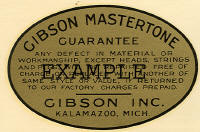 Don't trust all decals & labels! Made in 1972.
Don't trust all decals & labels! Made in 1972.
The above reproduction decal cost around .35 cents to have manufactured and
sold them for $ 5.00 each and/or $24.00 per dozen and strictly a business
deal and many banjo builders
purchased them. I certainly wasn't the first one to have them made nor the last one either,
however that doesn't justify my own actions. Being more
spiritually mature today, I would not offer such a
decal for sale, whereas I am sure most ended up on Gibson
Masterclone
banjos and some outright fakes.
The most important factor today; being a
born again Christian,
would not allow my
conscience to permit such! I was misled by the seller
in Marshville, NC of a
Mastertone with a fake decal in the late 1960s or early 1970s, who eluded
the pot assembly was real with a postwar reproduction neck and all things
including the fake decal looked correct. I didn't have years of
experience to ascertain the fine details necessary to prevent such a
purchase and took the hook, line and sinker. That must
have been
poetic justice in the making. I
later sold
that banjo for about what I had into it to Paul Sasser and was
aware that it was a fake and we both knew who made the fake. I believe
I gave 300 dollars for it and later had a Gibson Jasper Wood Products wood
rim installed in it, because the wood rim had cracked badly and that was the
worst sounding banjo that Paul Sasser ever owned according to him. The
fingerboard was too long between the nut and the first fret and the man I
purchased it from had it caped off at the second fret.....grin if you must!
I was a blue fin sucker all the
way on that purchase. The seller of the above Masterclone aka fake, had the
banjo caped off at the second fret where the banjo would note properly, but
would not play correctly in the open position due to the longer distance
between the nut and the first fret
Bill Gibson of Reinholds, Pa back in the early 1970's supplied a black and
white camera ready copy of the above decal. This decal was done long
before the invention of the personal computer and the gold sparkle matched
the original banjo wood rim decal which was photographed. Those that trimmed the
edge of the decal to the black border had a very convincing decal, but a
knowledgeable "banjar" trader would not be duped by the
usage of this type of reproduction decal. The
font Gibson used on the decal was artist drawn and not type set or at least
that is what was concluded. There are several ways to distinguish a
"fake" decal versus the original and many internet
threads posted to help anyone interested. One knowledgeable? vintage
instrument dealer in Nashville, TN. (mid 1970's) purchased a Gibson banjo
from a private collection in Danville, VA and the banjo was made from
post-war parts and was convincing enough for the buyer to think he had
"stumbled" onto an original RB4 pre-war flat head. The
original peghead inlaid veneer was cut from the original plectrum and/or
tenor neck very
close to the veneer and the original inlays from the fingerboard with the
poplar backing was inlaid Gibson style into a 1/8 inch thick Brazilian
rosewood fingerboard with small mandolin style fret wire onto the new
reproduction
5-string neck. I supplied Bill Gibson with a bunch
of these decals and Paul Tester (deceased) of Landover, Md. purchased the
balance of the decals when I went out of business. I purchased a
Gibson Mastertone RB4 banjo in the late1960's (mentioned above) that was a fake with post war
Gibson parts and home made wood rim, Gibson identical resonator construction and tracked
down the craftsman that built it. The same craftsman built the above
referenced Danville, VA RB-4 banjo. Excellent work and sounding banjo,
but not the real deal....only 300 bucks back then...grin if you must!
Many craftsman have gone to great lengths building "fake" pre-war Gibson
banjos and some are much harder to distinguish when using original pre-war
pot assemblies, but a knowledgeable buyer taking his/her time will spot the
fake. Even the smell and cracked finish of the resonator can be
replicated with ease, but many forget about the chisel tool marks on the neck
heel to wood rim fit and a dozen or more other tell tell give
away signs! Very few craftsmen today install a truss rod identical to
the pre-war ones, lower neck L lag bolt (prior 1929) and it takes the usage of technology to identify the truss
rod configuration buried underneath the fingerboard and maple filler strip.
Also, cut Gibson Mastertone decals on original pre-war banjos are very
difficult to determine if the Gibson factory did the conversion or post war
unless there is documentation on some of Gibson's pre-war shipping ledgers,
or the original owner knew the year of purchase and no outside conversion
was done while it was in his/her possession. In the case of a factory
pre-war raised head to flathead conversion, one must be able to determine if
the tone ring is definitely pre-war and not post war. This
paragraph is "food for thought."
Back in the 1970s and earlier, it was common to swap banjo components around
on original pre-war instruments before the invention of the internet with all the banjo cops
around. Many
banjo traders and craftsmen routinely replaced tailpieces, armrests, tension
hoops, tuning pegs, flanges, necks, etc. and have replaced tone rings as
well and not many back then was uptight about keeping something totally
original as long as they got the sound, looks and playability from the
banjo. Pre-war Gibson Mastertone banjos are probably the most duplicated and
counterfeited musical instrument today, other than Stradivarius!
Dobro guitars back in the 1960s were also prone to have outright fakes made
from cheap Harmony and other "off brand" guitars of which fake decals were
placed on the headstock! As long as there is money to be made, there
will be someone who will take the easy route; observed plenty of those
character type individuals during my 33 years working with the NC Department
of Correction.
ULTIMATE JUDGMENT
Individuals that use outright lies,
deception and fraud to purchase/sell
musical instruments or anything else, rest assured your spirit will not
enter into the
Kingdom of Heaven, but will be in hell for eternity, unless
you have repented of your
sins and make personal restitution if at all possible!
I did a good amount of business with Franz Dotzauer in Erlangen, West
Germany in the early 1970s until I sold my business in 1979. I never
met Franz Dotzauer or his son Gerhard who did all the correspondence in
English for their company. They were able to supply first quality
mother of pearl and abalone raw material blanks along with any other musical
woods that I needed and reproduction pre-war celluloid binding materials.
They also had contacts to have custom wood purflings made for me and other
brass metal parts such as the Kershner banjo tailpiece.
Below pixs of Franz, Gerhard, Thomas and the Grand Daughter
Helen Dotzauer of which I received the pixs from Gerhard on October 15,
2007:
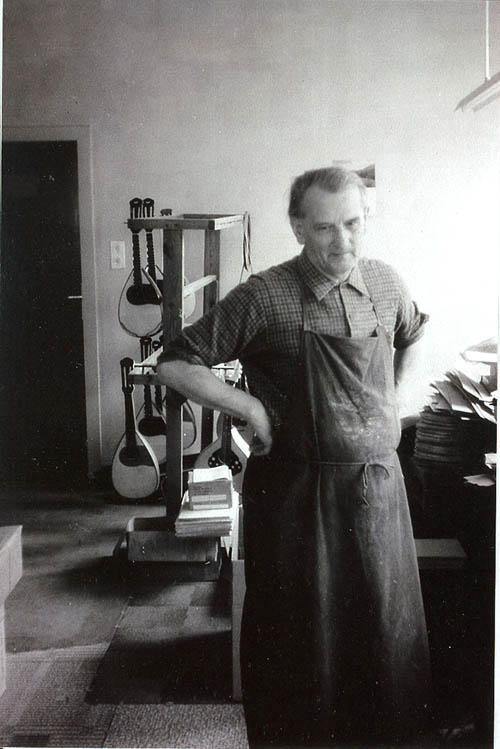
This picture of Franz Dotzauer, Master Craftsman taken in 1972 in his Mandolin work shop and
he died in 1981. Gerhard related to me that Franz and his Mother
established the business Franz Dotzauer Co. in 1946 after their deportation
from Czechoslovakia and she was the "boss" until her death. Mrs.
Dotzauer lived to a very wonderful age of 97 years and two months and was
never sick and never in a hospital prior to an upper thigh injury and died
from complications during a second surgery. God certainly does richly
bless us!
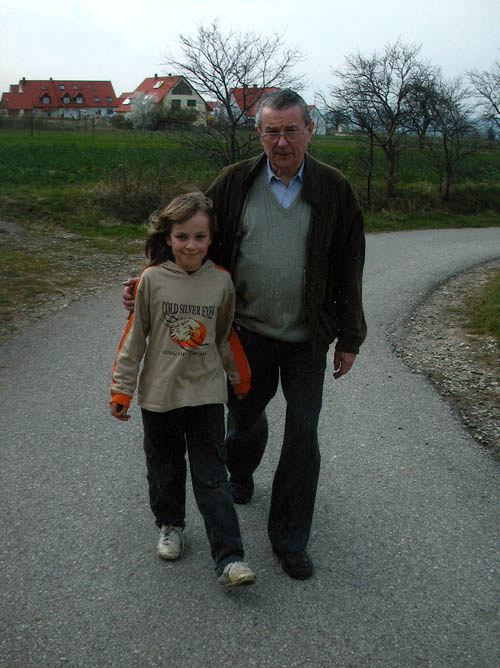
The above pix of Gerhard and his Grand Daughter Helen.
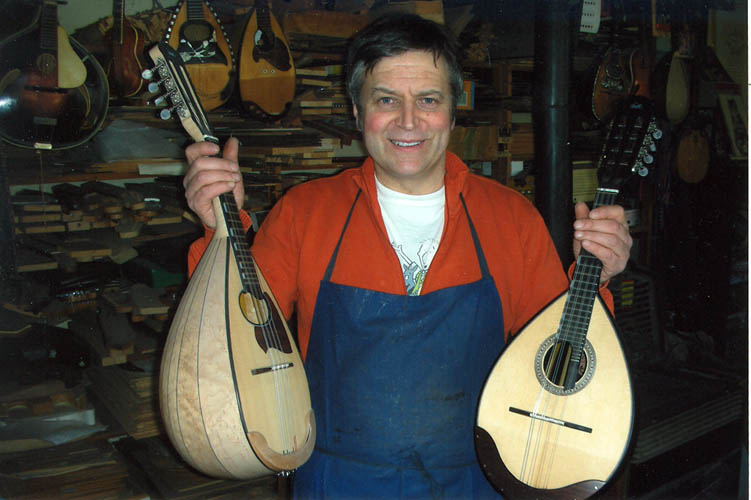
Picture of Thomas Dotzauer, Master Craftsman - Gerhard Dotzauer's son in the Work Shop.
Gerhard Dotzauer was a great person to do business with and I spent many,
many
thousands of dollars with their company over the years and never
disappointed with the products they were able to supply. They do not
sell in small quantities due to the shipping expense and all the current red
tape associated with International purchases/sales.
It has been my pleasure to meet some wonderful and talented people in the
music business over the decades and still maintain contact with many of them
as of today, but a great number have departed to the new life, since time
waits for no one.
God has richly blessed me over the years and as I say at every chance,
"Two of the Greatest Ships that ever Sailed,
Friendship and Fellowship."
After the recession starting around 1973 to
1975; in 1977 things were very tight
money wise and decided to sell the mail order business doing so in 1979.
I did not have enough reserve capital to see me through the lean times and went to
work with the N.C. Department of Correction and still employed with them
today as a Correctional Armory/Officer, certified armorer for Smith & Wesson,
Ruger, Remington Firearms and Facility Key and Lock Control Officer with 33 years of service as of
January 2012. I am looking forward to “retiring” on March 1, 2012 from the
NCDOC, the Lord willing of course! I have an
Advanced Corrections Certificate since 1992, have
been a Firearms Instructor,
Unarmed Self-Defense Instructor and General
Instructor off an on for 15 years leaving the instructing now to the younger
folks.
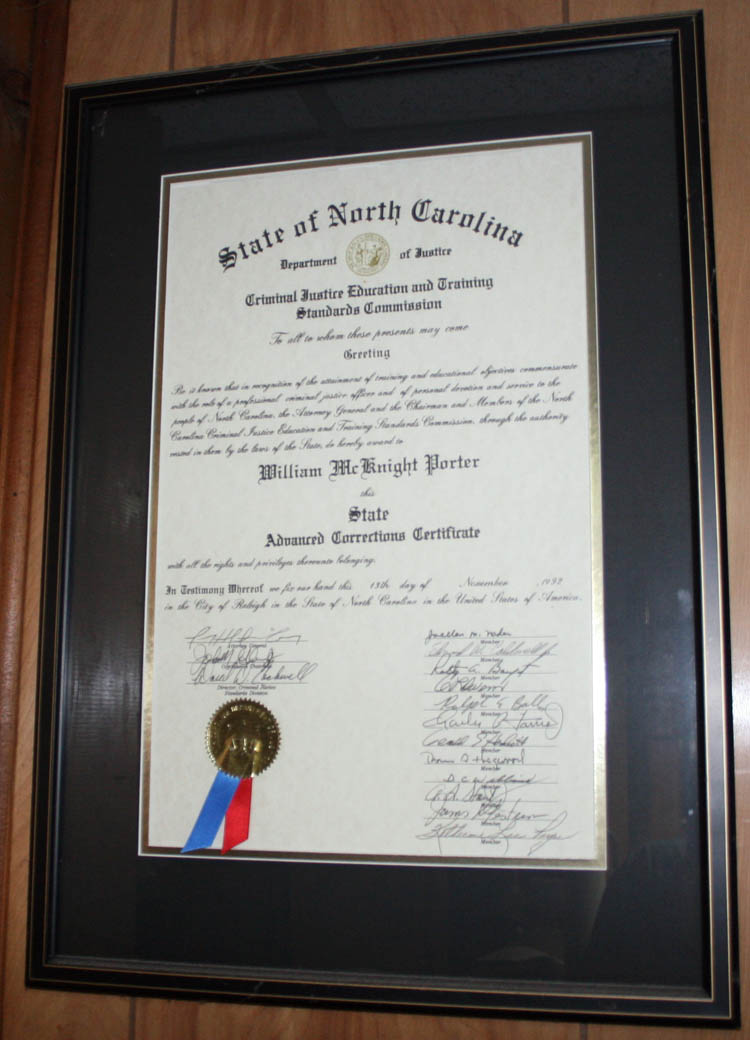
Below Porter, Brooks and Larry Shue presenting the
Advanced Corrections Certificate.
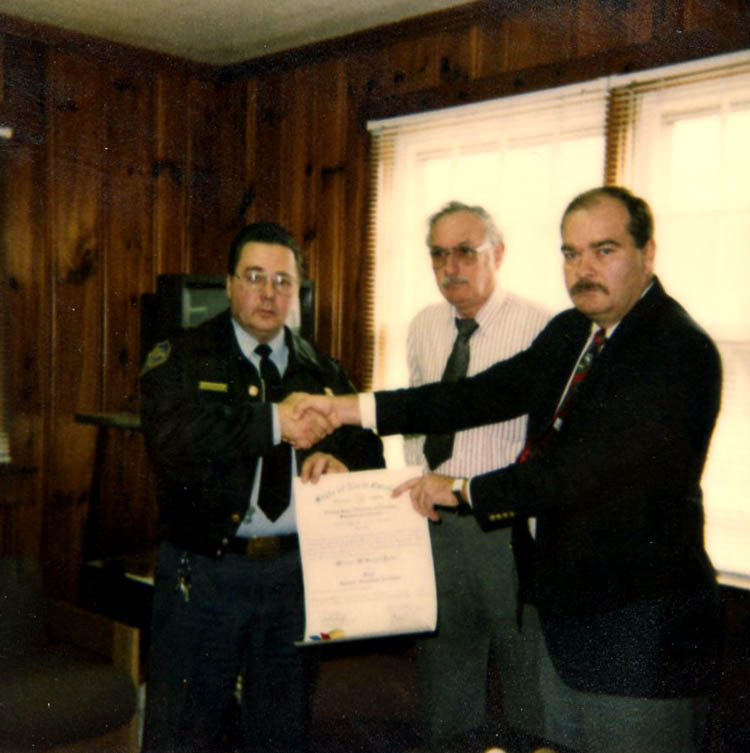
It was definitely God's
will for me to work for the North Carolina Department of
Correction. I had applied for jobs and most of the time got an answer
that I was over qualified for the job and the doors seemed to be closed for
the jobs I was interviewing for.
Over the decades; 33 years, I witnessed to many
individuals about Jesus Christ our Lord and Savior and did see some of the
fruition of a few giving their life to Christ! Most of the prisoners
used any means they could to exploit the system for their own personal self
greed, gratification and benefit, but there were a few that were God fearing and accepted
Jesus as their Lord and Savior. The majority of the inmate population have three main
objectives/wants and will do whatever it takes to make it happen: 1)
Drugs, 2) Sex, 3) Money, not necessarily in that
order!
HOW MY EMPLOYMENT CAME ABOUT
Out of the blue, I got a call from Ralph Coble the Brother-in-Law of a Correctional Sergeant,
Richard Ingold (now deceased) who later was advanced to the position of
Superintendent of the Anson Correctional Facility in Polkton, NC, whereas
Ralph Coble
stated they had a job opening for a Correctional Officer. I called the
Anson Correctional Facility and went for an interview, whereas the job opening was being
terminated within the next few days due to no one applying for the job.
Back then, DOC and DOT jobs were not advertised as they are today and most of those
employees stayed on until their retirement, etc.
To make a long story short, they made a special trip to
Fayetteville, NC and hand delivered my application to the South Central Area Office for
processing and I was hired within a week, if my memory is correct.
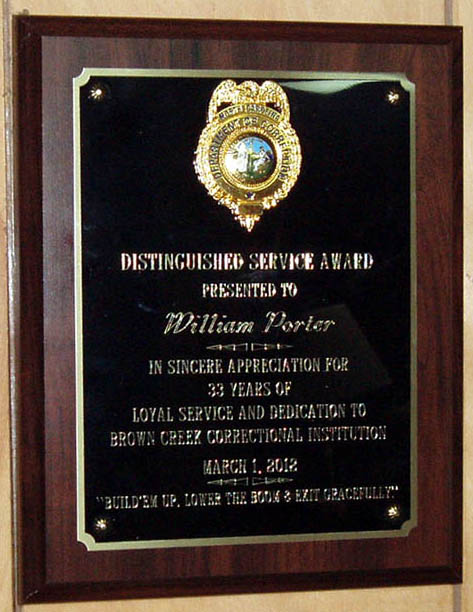
Visit
Porter's
Retirement Party page for additional information and a few good laughs
as well.
The music business took up most of my time and hunting was at a
premium until the early 1980’s and started turkey and deer hunting again
harvesting a long beard in 1982 using an old Lynch box call. I made a custom
wing bone call that year, but can’t remember who I gave it to.
It didn’t take long before I realized there was a
need for a good bow hunting climbing tree stand and started designing a telescopic foot
climber type tree stand and sold tree stands to the public and a few dealers
as early as 1986. I was granted two
US Patents
4953662 and
5167298 and sold the business
W.M. Porter, Co., Inc. in 2000 to an
outfit that manufactured aluminum dog boxes. Attached pix of tree stands:
This
pix was taken of the last tree stands that I made before selling all the
tooling and rights to the “Hunter’s Dream” tree stand. It is to my
understanding the company that procured the tooling, etc. was unable to get
adequate product liability and they decided to cease and desist production
of the tree stands. All my production fixtures and jigs were made by
myself and had to contract out a few custom parts for their assembly that
required a larger metal lathe.
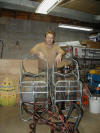
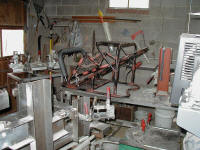
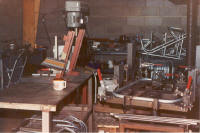
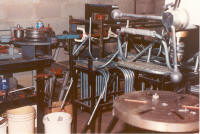
MAN CAVE
Bowhunting is my main hobby since 1979.....a few
pixs of my "archery hole" in one end our basement aka my
Man Cave. Some of the
pixs below were taken around 2001 and I have since gotten rid of all my recurve
and traditional archery equipment. My man
cave lacks the pool table and big screen TV, but I certainly
do enjoy it!
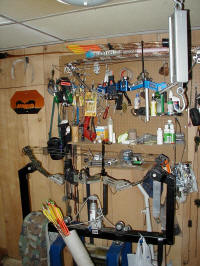
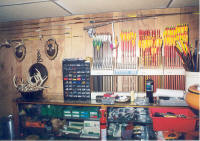
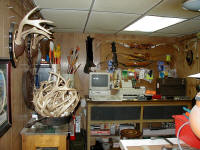
Pix to the left of my early custom made telescopic bow
press. I had special tooling made to swedge aluminum arrow shafts to a
six (6) degree taper for the old type insert-less "Snuffer"
and Black Diamond broadheads.
One of my best inventions I "gave" away was
an offset roller cable guard long before the single track
wheel and true cam bow was on the market. I used my invention to
separate the cables on an older wide track round wheel compound bow providing increased fletch clearance and a much quieter bow by isolating the
cables. I used two small one inch diameter rollers from an ole
Whitetail Hunter model Bear compound bow with an aircraft aluminum
supporting main frame with the majority of the support bar/frame milled away
to reduce the overall weight. It didn't take too long before my invention was on the market
with a few modifications such as adjustability to fit different brace height
bows during the early 1980's. I believe it was about the same time
that Kidd Archery procured Jennings bows to go along with their Bear bow
acquisition. I learned from that mistake for sure!
Don't show or tell about your invention unless you have pertinent
documentation such as a patent pending since you only have a year to file
for a patent once you publicly display your invention.
Check out the below pix of my deer horn stew pot....it
is maxed out with the main ingredient:
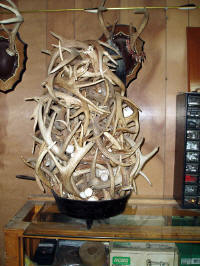
Harvested with arrow, muzzle loader, pistol and rifle.
A pile of consumed venison!
With some free time on my hands again, I
decided to make another musical instrument and called my good friend Jim
Yarboro in Gun Barrel City, Texas that still had the molds for building a
resophonic aka Dobro guitar that he got from me in 1979 and he shipped them
to me UPS and the fun started. I had sold most of my wood working equipment and had
only a few power hand tools left and this guitar was made by good friends
letting me use critical pieces of equipment such as the band saw, table saw
and jointer, etc. all of which I do have today…another grin is in order.
A few pix of that guitar under construction and Jim Yarboro and his banjo
picking "bride" Carol in 1976.
The poster board pattern tracings that I used to make
the bending and working molds were received from Tut Taylor when he was with
George Gruhn and Randy Wood of GTR there in Nashville. Tut made a
tracing from an original 4-way match walnut Dobro (if my memory is correct
on the model) sometime in the early
1970s when I was working with the North Carolina Telephone Company in
Marshville, NC and had my instrument repair and mail order business going at
the same time. Many nights, my bride and myself stayed up until after
midnight filling orders, etc.
NOTE: I sold Paul Tester (deceased) of
Landover, MD., a walnut four-way match unfinished Dobro body that was
created using the molds in the early to mid 1970s! I still have the
rosewood head overlay with an original inlaid mother of pearl
logo that was supplied by the Dopyera Brothers that was going on the above
Dobro. The logo inlay doesn't have the engraving on it. I located the head stock overlay in the Dopyera Brothers file.
I guess I am a pack-rat for sure, since that has been over forty (40) years
ago.
NOTE: I replaced a neck in
Ray Atkins ole
"White Faced" Dobro sometime before 1972 and the Dopyera Brothers sent me an
original Dobro decal to place on the headstock.
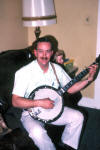
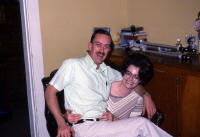
Pix
of the guitar back with the bracing just hand planed to shape. Most
resophonic guitars (square neck) do not have any bracing, but I added it
since this was going to be my personal guitar and might have been just a
little overkill, but that is ok too.

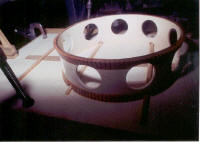
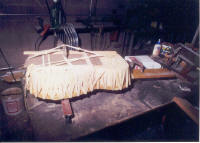
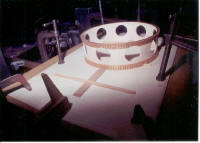
Pix
of semi-finished body of guitar with the holes for the sound screens not cut
yet or any bindings added and bending mold and working jigs used to build
the guitar.


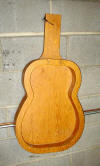
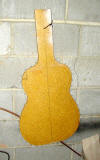 Note: Ervin Sloane's mold design.
Note: Ervin Sloane's mold design.
Inlaid ebony fingerboard with the Flaming Claw mother
of pearl inlays being glued to the curly maple neck blank with a pile of C
clamps. Might be another overkill on the clamps too!
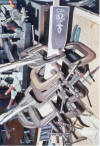
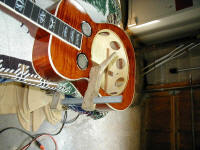
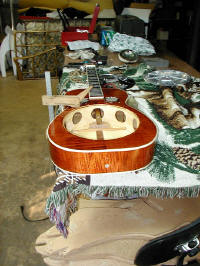 Old style "neck tongue" construction.
Old style "neck tongue" construction.
Pix
of finished resophonic Dobro guitar with all curly maple neck, back, sides
and top with inlaid ebony fingerboard and peghead. It was finished on Father’s Day in 2000 and has aged
now and sounds great! The little pc microphone doesn't accurately
replicate the bass range of the guitar and the guitar sounds much mellower
"in person".
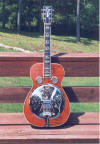

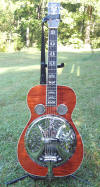 Softly and Tenderly .mp3 file
Pee Dee River Slide .mp3 file
Softly and Tenderly .mp3 file
Pee Dee River Slide .mp3 file
I'll Be All Smiles Tonight with
Porter & Curtis. Click on links to hear mp3 sound file.
Fireball
Don't grin too big; I hadn't picked on the Reso
in about 25 years and started messing with it a little after I made the
above guitar!
MODIFIED SOUND WELL HOLES 06-15-17
The old saying, "If it
ain't broke, don't fix it", which is very sound advice, but
sometimes, I do violate my own logic and thinking. Another ole cliché,
"It is better to leave well enough alone"....grin
if you must!
I started back trying to play my resophonic guitar this
year and the above resophonic guitar is made from curly maple except for the
sound well which is poplar and has a little higher resonant pitch due to the
solid wood construction versus the plywood construction of the Nationals,
Regals, and Dobros from the 1930s.
I viewed a number of different sound well construction
resophonic guitars as well as the ones with nothing, but baffles and "sound
posts", whereas I would modify the standard round sound holes in the sound
well on this guitar. Many of the die hard traditionalists like the
parallelogram shaped holes versus the round holes, but as to which one is
better is still open for debate. I know I would be taking a gamble,
but didn't think it would change the sound for the worse and would open up
the sound well and maybe lower the resonant frequency and might even pump up
the volume some, but this guitar has very good volume and sustain. I
know, it seems crazy to mess with it!
I didn't have any good RotoZip router bits on hand and
had to wing it. I tried to use a slotting cutter in my portable drill,
but I couldn't control it freehand and that was out. I found a 3/32
inch router bit and used the Dremel tool and drilled close connecting holes
between the sound holes that I wanted to remove and end up with four (4)
very long sound elongated sound holes, with a regular round sound hole for
the neck area and the tailpiece area. After cutting the pieces out, I
used a small 3/4 inch diameter sanding drum on the Dremel and 100 grit
sandpaper to finish the work.
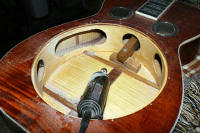
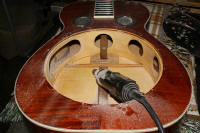
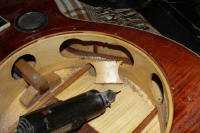
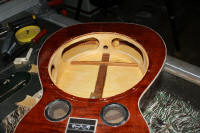
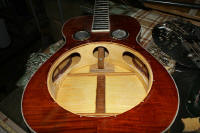
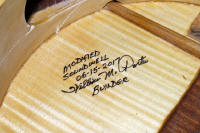
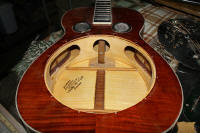
I put the resonator and spider bride assembly back into
the sound well, attached the cover plate and tailpiece and tuned her back
up. I believe it has more volume, sustain and the tone is sweet!.
I will let it settle down a few days and see if I can get an old Windows XP
Pro system running and record some sounds and see if I can hear a difference
between something that I already have on file. This PC here is Windows
8.1 and I don't have an audio imaging program that works on the 64 bit
system. I know if you cover the sound hole screens the volume
definitely goes down, therefore sound is projected from those holes for sure
and they are not there just for looks in my humble opinion and works on the
same principle as a drum as to the release of sound waves, sound holes for
the mandolin and guitar, of which size does matter.
The traditional sound well guitars definitely help to
keep the top from imploding and offers a secure means to mount the resonator
cone. Later designed baffle systems accomplish the same thing as does
the sound post system to keep the top from imploding and the more open body
cavity does change the tone, volume, overtones, etc.
I plucked the bass string and counted one thousand one
and could still hear an audible sound at one thousand twenty one count, but
it was very weak. I don't have a clue as to what the sustain on other
resophonic guitars would be and what the gauge mark would be as to the
number of seconds of useable sustain.
INSTALLED FISHMAN UNDER THE SADDLE
PICKUP
I installed a Fishman Jerry Douglas Series Under the
Saddle Pickup on 07-14-17 and was initially pleased with the sound, but
things went down hill from there. In combination
with the Jerry Douglas Signature Series Aura Imaging Pedal, it was fair
sounding.
See this link
for details of the install.
Since I have taken you on a journey, I will finish up
soon. It was some of my turkey hunting buddies that nudged me into
making box calls and they wanted something that would work and also something
different to add to their ever growing custom turkey box call collection.
As mentioned earlier, I worked in electronics
installing and repairing two way radios, base stations and mobile telephones for the
NC Telephone Company
from 1968 until 1972 and switched over to inside equipment working on
Microwave, ITT, Stromberg Carlson, Viacom, Motorola, RCA, GE and
special circuits requiring modems and switching equipment until 1975 at the same time I was running
my musical instrument repair mail order business and attended the local
Community College until 1978 studying business. While working with the
NC Telephone Company I maintained an Amateur Radio Advanced Class "Ham"
license call sign WB4GAN and kept a 300 ft. long wire antenna and
Collins KWM2A transceiver at our radio repair and installation facility to
chat and Morse code with folks all over the world. I was also a member
of the Navy MARS program call sign N0KOU. I still have a
current FCC Commercial Radiotelephone Operator License
(GROL) which collects dust
and guess too much of a good thing (electronics) can burn one out.
With a background in
ELECTRONICS from the US Navy, the Telephone Company,
and CIE graduate, I decided to apply
some techniques used from my music days for testing sound chambers and
experimented for a couple years with different call body shapes and
configurations to come up with my current box call which is called “Dual
Hens” which features a unique and novel sound chamber with a “Torpedo
Nose” inside taper. With the aid of computer audio editing and imaging
programs, I am able to hear and see what the frequency analysis of the sounds
being emitted by my calls and other maker’s calls as well to achieve my goal
of producing an excellent sounding call. Even with technology, it is about
impossible to get two calls to give the same frequency response and timbre
or color due to the
individual characteristics of wood from the same billet or fletch. This is
what makes call making so much fun and exciting and yet stress the brain a
little when something doesn’t work just right when it should!
Calls will however exhibit certain sound characteristics
attributed to the call maker either by design or accidental discovery of
design commonly called (trial and error).
The difference between the sounds from a good
box
call and a great box call can be attributed to the timbre
or color of the sounds emitted which can be described as mellow,
harsh, piercing, raspy, mild, clear, warm, strident, sharp, breathy, flat,
throaty, gutsy, hollow, growling, dry, tubby, light and heavy of which is very subjective and to some degree
changed by
weather conditions such as humidity and barometric pressure. A box call
will sound much different when played 25 yards or more away from the
listener and the acoustic surroundings such as dense undergrowth, hillside,
valley or an open
field will change the perceived timbre of the call and could sound
nasal, hollow or throaty as well. The
in phase harmonic overtones produced by a box call greatly influence
the timbre or color of the sound transmitted by the call and is difficult to
give a word description, but sound recordings and graphs depict what is
taking place. However, such recordings or graphs do not tell you how
to arrive at such a point, but merely show the end result! A call's
resonant frequency or pitch can have a beautiful tone, color or timbre yet
be lacking in volume or the ability to project the sound a great distance.
There are a host of variables affecting the acoustic qualities of a box call,
but most agree timbre is that component of sound that is most
pleasing to the ear in addition to the calls ability to reproduce the sounds
of the wild turkey.
Timbre is what separates Stradivarius, Amati, Guarneri and Stainer
violins from other violins within the same 18th century period of
construction as does any musical instrument including box calls. There
are many myths such as water logged century old wood reclaimed which
produces that magic sought after sound element timbre, but that theory
and myth is as water logged as the logs themselves! Other myths was
the usage of centuries old wood from cathedral timber, but carbon dating
of
Stradivarius violins disproved the old wood theory along with a "secret"
varnish used was also disproved by chemical analysis. Old growth dense wood is
only one element in the equation for great
timbre whether it is
a musical instrument or turkey box call. Musical instrument components
along with box call components are adjusted to compensate for the density of the wood
used depending on what type of sound you are opting for. Mass
production call and musical instrument manufacturers are not usually set up to account for wood
density and ever so often a super sounding call and instrument will come to light more or
less by chance. Those are the calls that are entered into some of the
call makers contests, however when a call manufacturer has a 1000 calls to
choose from, it is hard to compete using only one single call, but it can be
done, but the odds are high.
View the links below for additional information about
wood density. Thanks to
Ken LeVan for the
links.
Science Daily
Fungi Infested Violins
Some call makers are advertising one piece hand hewn
call bodies, but if using a drill press or any power tool to remove call body
(cavity) material, that call
in reality is not hand hewn. I would welcome a CNC router or laser of which
I do not have to aid in the quick removal of “waste” material on a call body,
but instead use conventional tools such as router, drill press, table saw,
router table, cut off saw, planer, jointer, carving station, sanding stations, palm sanders
and yes hand tools such as chisels, rasps, files, gouges, carving tools,
etc. The inference is that a hand hewn call is superior in
construction and produces a better sound than a call that is machine carved
or routed, but is subject to much debate and opinion, but
microscopic analysis
of test wood cells and fibers along with audio frequency analysis cannot
support such views.
Machine carvers and routers do impart certain characteristics
to the wood cells that hand tools such as a chisels and knives cannot
accomplish. There is a valid case for musical instruments including box calls that have
the soundboards "stress relieved" in the
construction process
with "special tuning" and component configuration allowing the wood to vibrate or
flex in a controlled predictable manner. This is not a
new technique, but centuries old of which the wheel has been
merely re-invented with the aid of modern technology mainly the personal
computer.
NOTE: Call base is integral part of the call body and
not glued in place.
Pix of my field grade “Dual Hens” model call
with inlaid # 4 wood purfling and Eagle medallion.

 Click on turkey icon to hear sound file.
Click on turkey icon to hear sound file.
Call available in Butternut, Black Walnut, Sassafras,
Mahogany and Poplar with cedar lid.
Pix of one of my North Carolina “Limited Edition”
Custom Deluxe calls:

 Click on turkey icon to hear sound file.
Click on turkey icon to hear sound file.
Eastern Red Cedar lid inlaid with Mother of Pearl Dogwood
blossom with Green Abalone Pearl center and the North Carolina State outline
is done in Red Abalone Pearl with strutting turkey in Green Abalone Pearl
with etching/engraving for feather detail. This call is no longer
available.
Check out the
Products section and look under
Shop Pixs for custom inlays designs on the drawing board.
My one piece carved box call bodies are roughed out and
allowed to acclimate or age for about a year before any final tuning. I
keep a good supply of various woods on hand in this pre-tuned condition. I
personally believe it makes a difference in the final sound of the call and
most calls do get better with age! The delivery time of my field grade
call is around two to four months and there is a current back log of one to
two years for a custom deluxe call depending on how much inlay you
desire. Calls are first sealed with sanding sealer and a coat of satin
lacquer applied. I have found the less finish applied, the call has
more
response, sensitivity, volume, tone and timbre with all things being equally
compared to a non-finished call. The inside of the
torpedo nose tapered sound chamber has very little finish only a
light coat of sealer which for the most part is scraped or sanded away at
critical areas affecting the call's resonance.
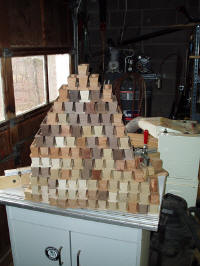
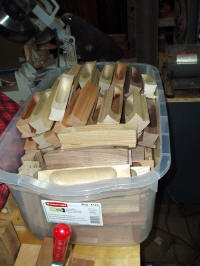
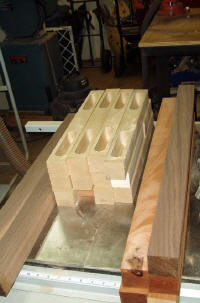
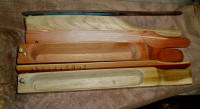
Pix of calls allowed to acclimate or age before any final tuning, etc.
and end view of my one piece carved call body calls.
This procedure is very time consuming and costly up front, but the end
result is worth it. Most of the time, "You get what you pay for".
The far right pix of a few well known custom call makers calls used in my
Research and Development although I do not make a long box or fence post
type call.
My standard Field Grade “Dual Hens” call is
$ 300.00 plus $ 10.00 shipping and $ 20.25 NC Sales Tax for a
total cost of $ 330.25. Money back guarantee (less shipping
charges) if not satisfied provided call is returned prepaid and in undamaged
condition.
I do not ship orders
outside of the USA.
The North Carolina “Limited Edition” Custom Deluxe
call pictured above start at $500.00 which requires a $50.00 non-refundable
deposit. This call is no longer available!
I no longer donate calls to NWTF chapters or support the organization
due to alcoholic bars set up with free drinks as a means to
inebriate potential high dollar spenders and bidders at their banquets.
This is a disgusting and immoral way to conduct business to raise money in my
humble opinion! Also, the usage of
"bar maids" (literally and figuratively) to serve the drinks and assist in the auction is
low class. When you are
of the world, this is a normal protocol.
Page updated by Bill aka Mickey Porter on 09-19-17.
CONTACT:
contact@portercalls.com
Porter Custom Calls
531 Burlington St.
Wadesboro, NC 28170-2501
Telephone: 704-694-6316
NOTE: I no longer monitor the above contact link due to the high
volume of malicious emails received from all parts of the world and all emails
are currently rejected. If you need to contact us, go to the trouble to send a
letter or post card
(snail mail) to the address provided on the
order form page.
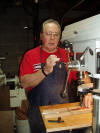
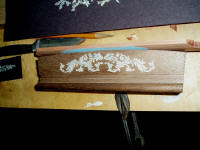

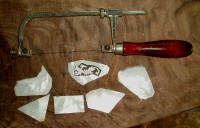
Pix of Bill Porter taken on 05-01-08 drilling a hole into a box call lid for the
installation of standard Eagle medallion and laying out a custom mother of
pearl inlay pattern. It has been many years since doing any serious
custom inlay work, but it is like riding a bicycle, it is coming back
quickly.
A FEW PIXS FROM THE PAST


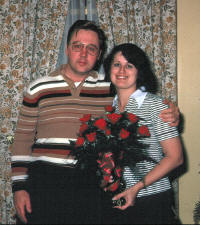
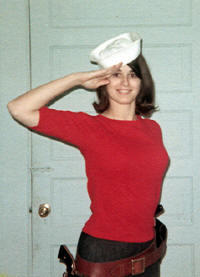
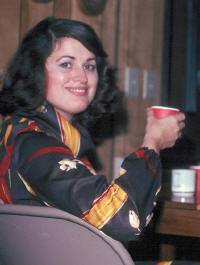
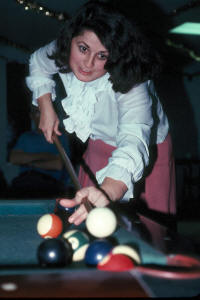
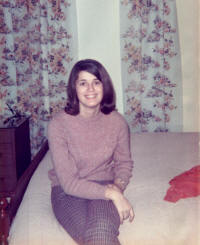
Pix of my bride and myself taken on May 2, 2008 in San
Diego, California attending our son's retirement ceremony from the US Navy.
The date on the camera is a couple years behind....grin if you must and pix
of our 37th wedding anniversary taken in 2005 and one taken on January 22,
1978 and a few other pixs. Time waits on no one!
My bride Joyce aka “Tweet” has put up with a lot of my
mess (hobbies & businesses) from our home the past 51 years which seems like
only yesterday we were married. She is the love of my life, my best
friend and been by my side supporting me in all my endeavors and an
excellent crafts person and artist!
Praise be to God for his many
blessings through out our lives through Jesus Christ our Lord and Savior.
AMEN!
RETIREMENT
As stated many paragraphs above,
I retired from the North Carolina Department of Correction on March 1, 2012
and have definitely enjoyed my retirement with my bride, family and friends.
I have numerous
short stories documenting some of our trips
and continue to give God through Jesus Christ our Lord and Savior, the
Praise, Honor and Glory in all things.
Many have asked how I like
retirement and I tell them it is great, but have found one thing wrong with
it and they looked puzzled and ask what? I tell them,
"You never get a day off."
Now, your turn to grin, because it seems I never run out of something to do
which is a good thing.
Web page updated by Bill aka
Mickey Porter on 06-30-18.
Two of the greatest ships that ever sailed:
Friendship and Fellowship!

Bill aka Mickey and Joyce Porter 06-13-09. Web
page updated on 02-07-14 by Bill aka Mickey Porter.
DAVID MUSSELWHITE
VISIT
I had the pleasure of a visit from David Musselwhite of
Jonestown, PA, one of my early musical instrument customers and
friends on 10-08-14 and we had a wonderful time bringing into focus things
that have changed over the decades. David would come by for a visit
back in the 1970s when he and his uncle were deer hunting near Hoffman, NC
and when visiting other relatives here in NC. Below is a pix of David
who is a treasure trove of
information for Martin guitars and prewar Gibson banjos and mandolins:
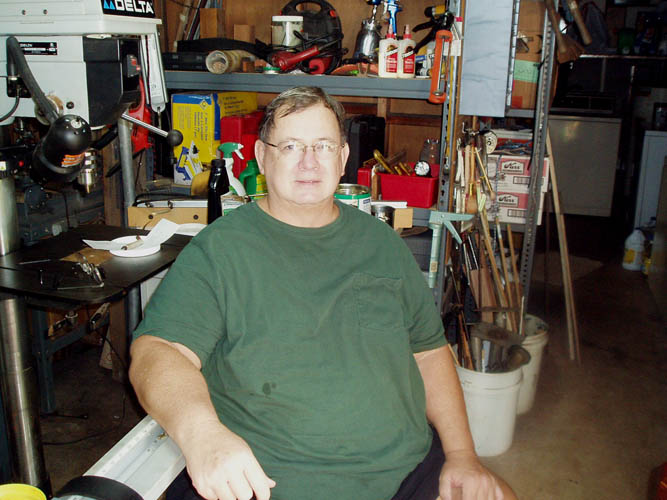
David picked Grandfather's Clock on my ole Porter
Flaming Claw five string "banjer" and he sounded real good too. David
and myself kicked back in my workshop and basement "Man Cave" getting up to
date on current things and reminiscing of the past. Hopefully this
coming Spring, the Lord willing of course, my bride and I plan to get up in
David's neck of the woods for a long overdue visit.
NOTE: My bride due to medical issues, is
no longer able to make trips of any length, therefore we never got a chance
to visit with David and his family.
Two of the greatest ships that ever sailed:
Friendship and Fellowship!
Web published updates by Bill aka Mickey Porter on
10-27-14, 07-17-16, 10-11-16, 04-23-17, 03-28-18, 05-23-18, 06-23-18,
06-30-18, 07-27-18, 07-28-18, 01-31-19, 07-20-19, 02-14-2021, 12-24-2021 and
03-11-2023.
DAVID MUSSELWHITE VISIT 11-23-18
David came by for a visit on 11-23-18 and I have the
short story linked
here with pixs:
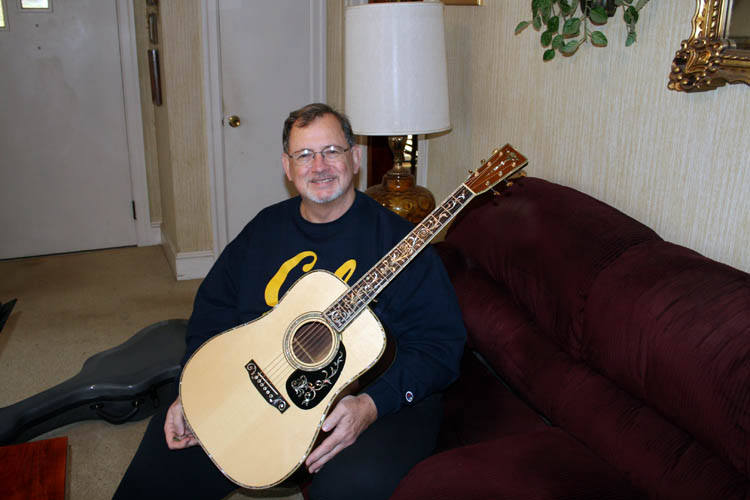
Web page updated by Bill aka Mickey Porter on 11-23-18, 05-19-2023
and 08-04-2023.
LEAVING ON A
SPIRITUAL NOTE
If you do not know Jesus Christ as your Lord and Savior, please take
this moment to accept him by Faith into your Life, whereby Salvation
will be attained.
Ephesians 2:8 - 2:9 8 For by grace are ye saved through
faith; and that not of yourselves: [it is] the gift of God: 9 Not of
works, lest any man should boast.
Hebrews 11:1 “Now faith is the substance of things hoped for,
the evidence of things not seen.”
Romans 10:17 “So then faith cometh by hearing, and hearing by
the word of God.”
Open this
link about faith in the King James
Bible.
Romans 10:9 “That if thou shalt confess with thy mouth the
Lord Jesus, and shalt believe in thine heart that God hath raised him
from the dead, thou shalt be saved.”
Open this
link of Bible Verses About Salvation,
King James Version Bible (KJV).
Hebrews 4:12 “For the word of God is quick, and powerful, and
sharper than any two edged sword, piercing even to the dividing asunder
of soul and spirit, and of the joints and marrow, and is a discerner of
the thoughts and intents of the heart.”
Romans 6:23 “For the wages of sin is death; but the gift of
God is eternal life through Jesus Christ our Lord.”
Romans 3:23 “For all have sinned, and come short of the glory
of God;”
Micah 6:8 “He hath shewed thee, O man, what is good; and what
doth the LORD require of thee, but to do justly, and to love mercy, and
to walk humbly with thy God?”
Philippians 4:13 "I can do all things through Christ which
strengtheneth me."
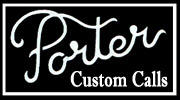
HOME PAGE
